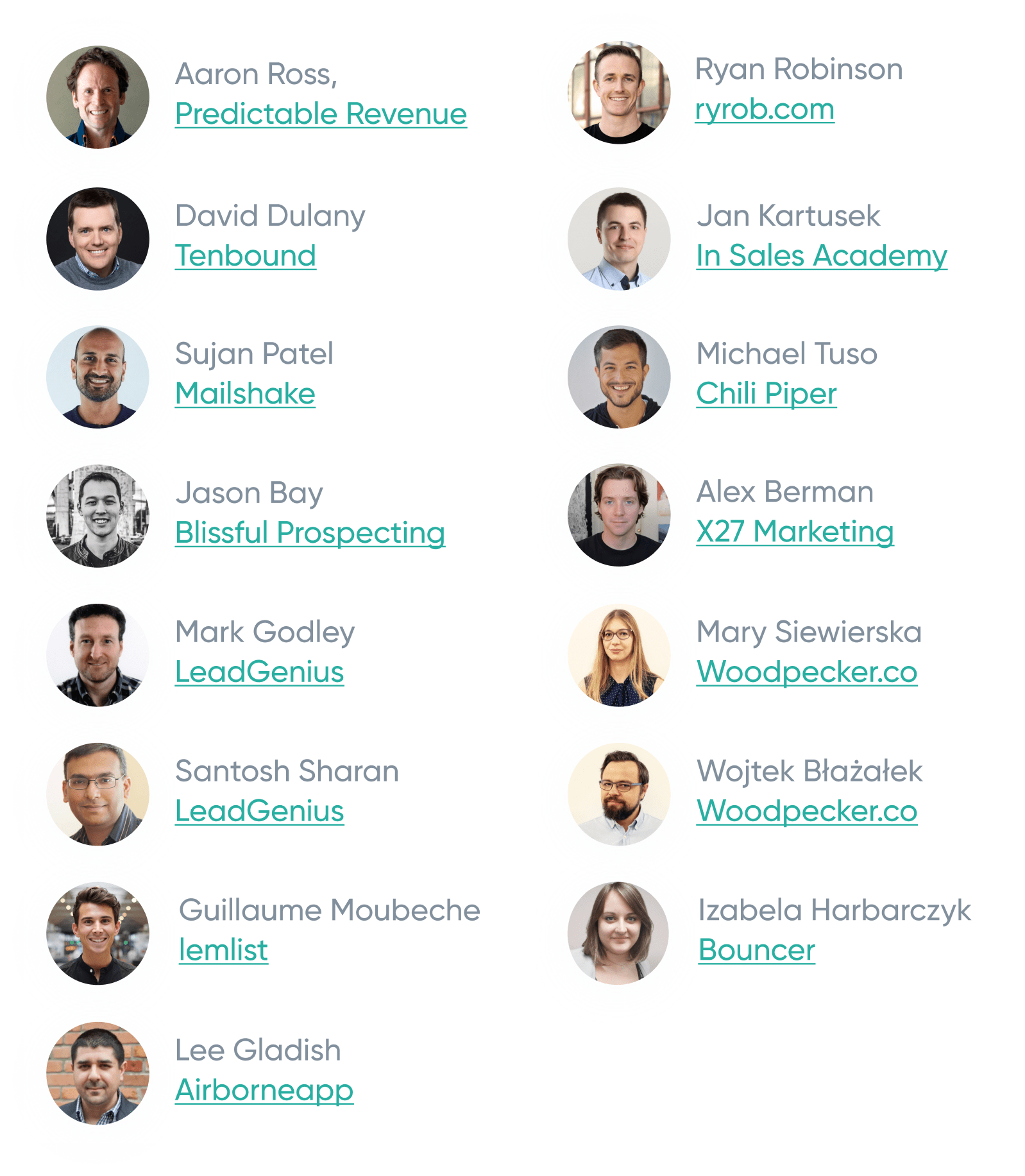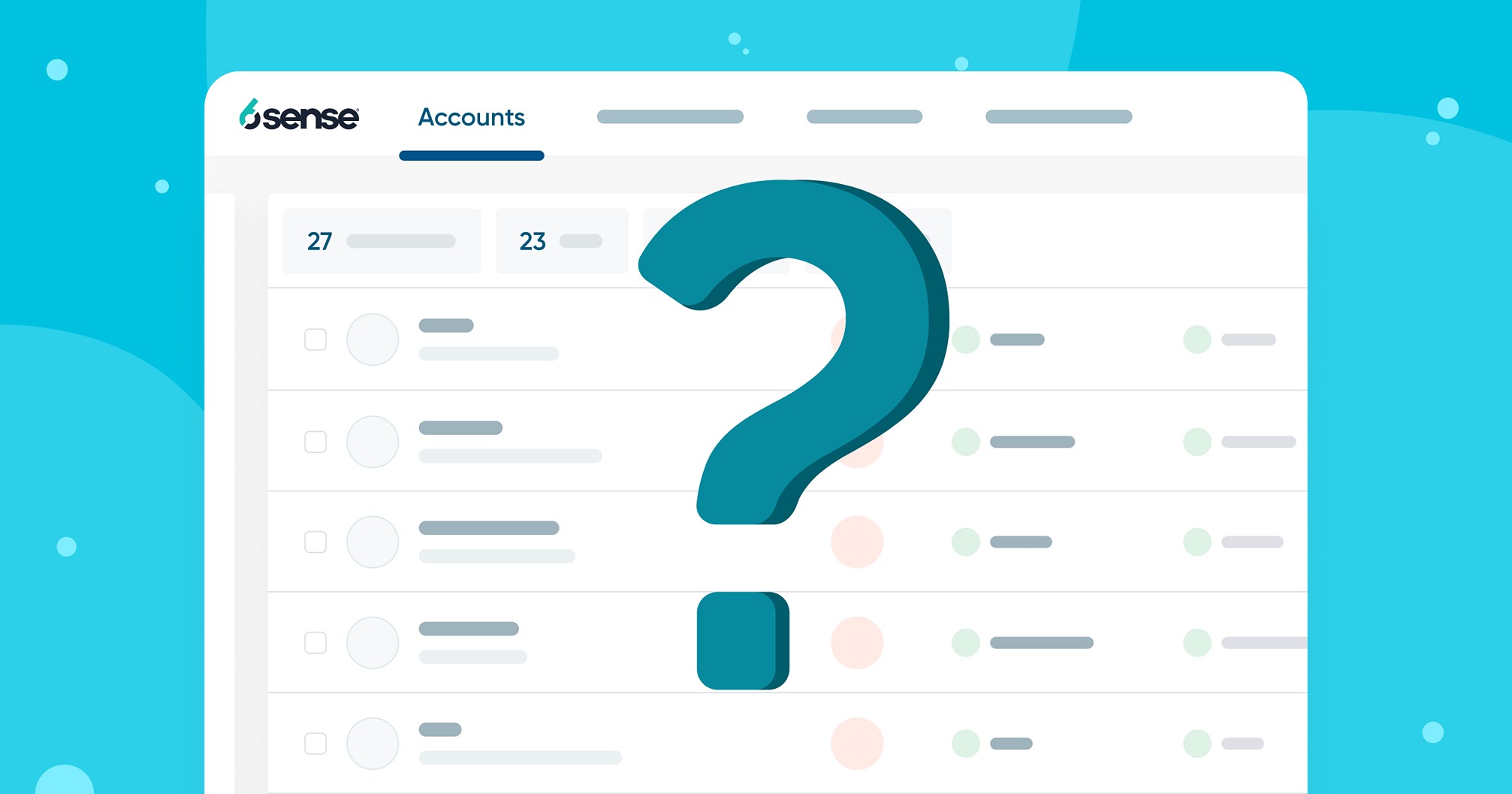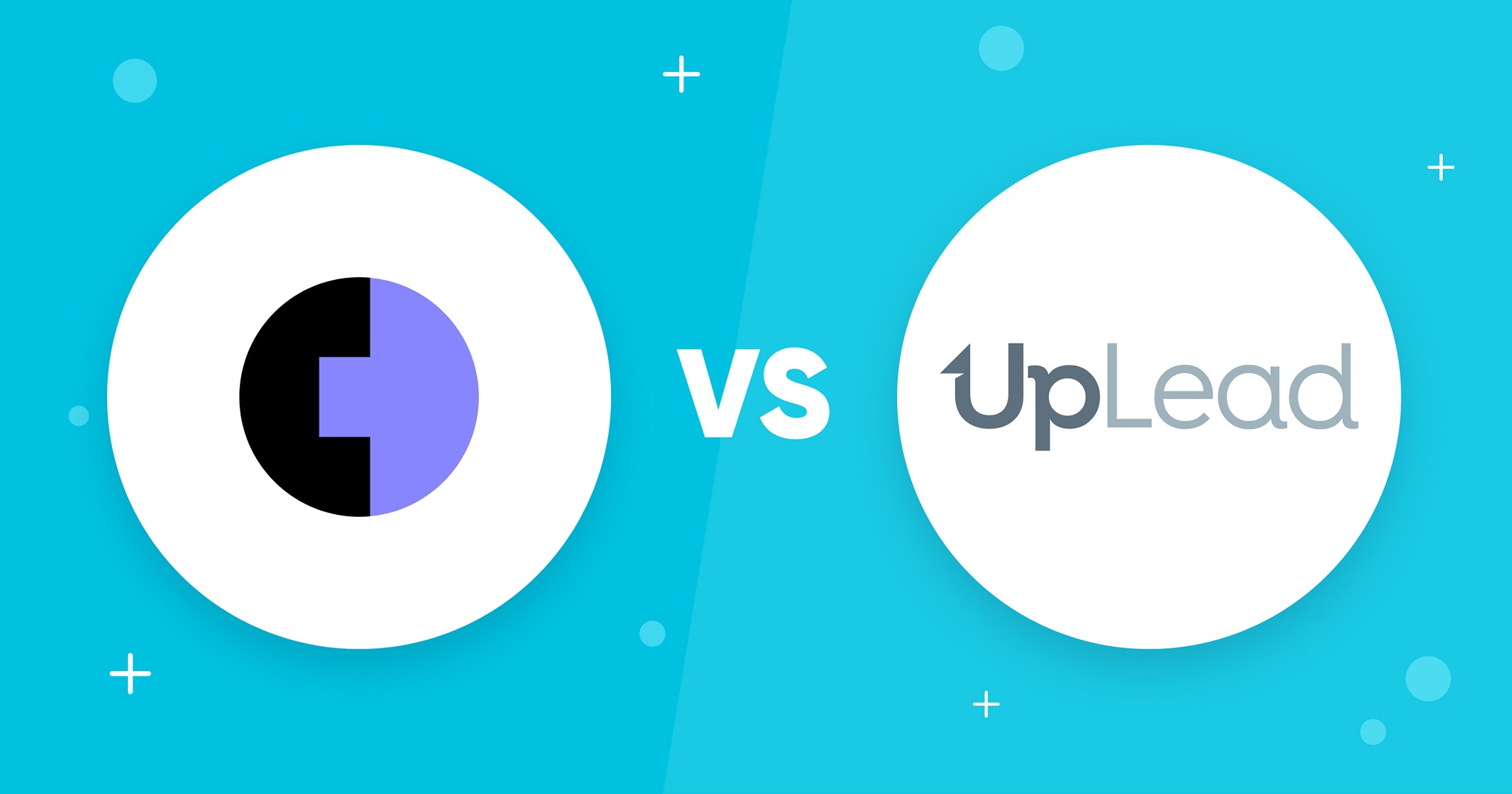When done right, having a good cold email outreach strategy is a great way to generate new leads. This way, you can reach many potential customers and generate tons of qualified leads at a very low cost.
However, most people avoid it thinking it’ll be spam. Other people do it and end up with terrible ROI because of a failed strategy. After all, with the average worker receiving 121 emails per day, avoiding their spam folder is not enough. If you want results, you need to get them to open your cold email and engage with it.
So, is cold emailing spam? How can you create your own effective cold email outreach campaign?
In the following article, you’ll learn everything you need to know about cold emails.
What Is a Cold Email?
Before discussing how to kickstart your cold email campaign, let’s define “cold email.”
This is fairly straightforward: a cold email is an email you send to a prospect or lead you haven’t previously communicated with.
Do you know how some companies do cold calling? A cold email is essentially the same thing – it’s just that you’re reaching out via email (instead of over the phone).
Now, you might be wondering… do cold emails count as spam? Is it even a good idea to cold email prospects?
You’ll be glad to hear that cold emails are not spam. The most significant difference is that spammers send the same unpersonalized email to thousands or tens of thousands of people. However, with cold emails, you’re customizing your emails to the specific prospects you’re trying to reach out to.
That said, cold emails can get trapped by spam filters. We’ll address this in a later chapter and teach you some tips and tricks to ensure that the email deliverability of your cold outreach is high (and that your emails don’t get flagged as spam).
For now, let’s move on to Chapter 1.1, where we discuss the CAN-Spam Act and teach you how to craft cold emails that are compliant with it.
Understanding the CAN-Spam Act
In a nutshell, the Federal Trade Commission’s CAN-SPAM Act details the requirements for commercial messages and specifies what you should or shouldn’t do when sending cold emails.
Here are the CAN-Spam’s requirements, as set out by the FTC:
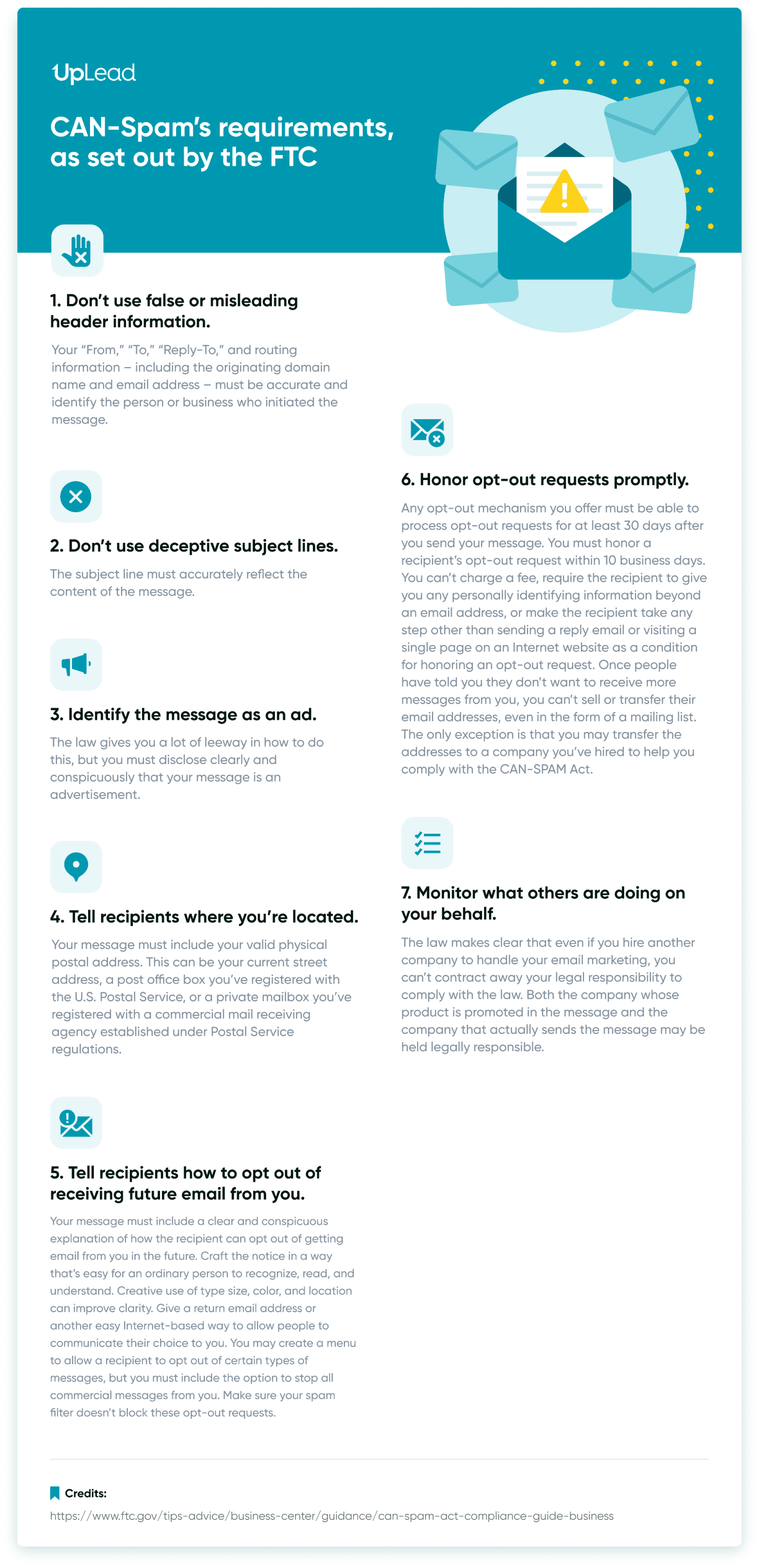
Here’s how you may comply with the requirements in the context of cold emails:
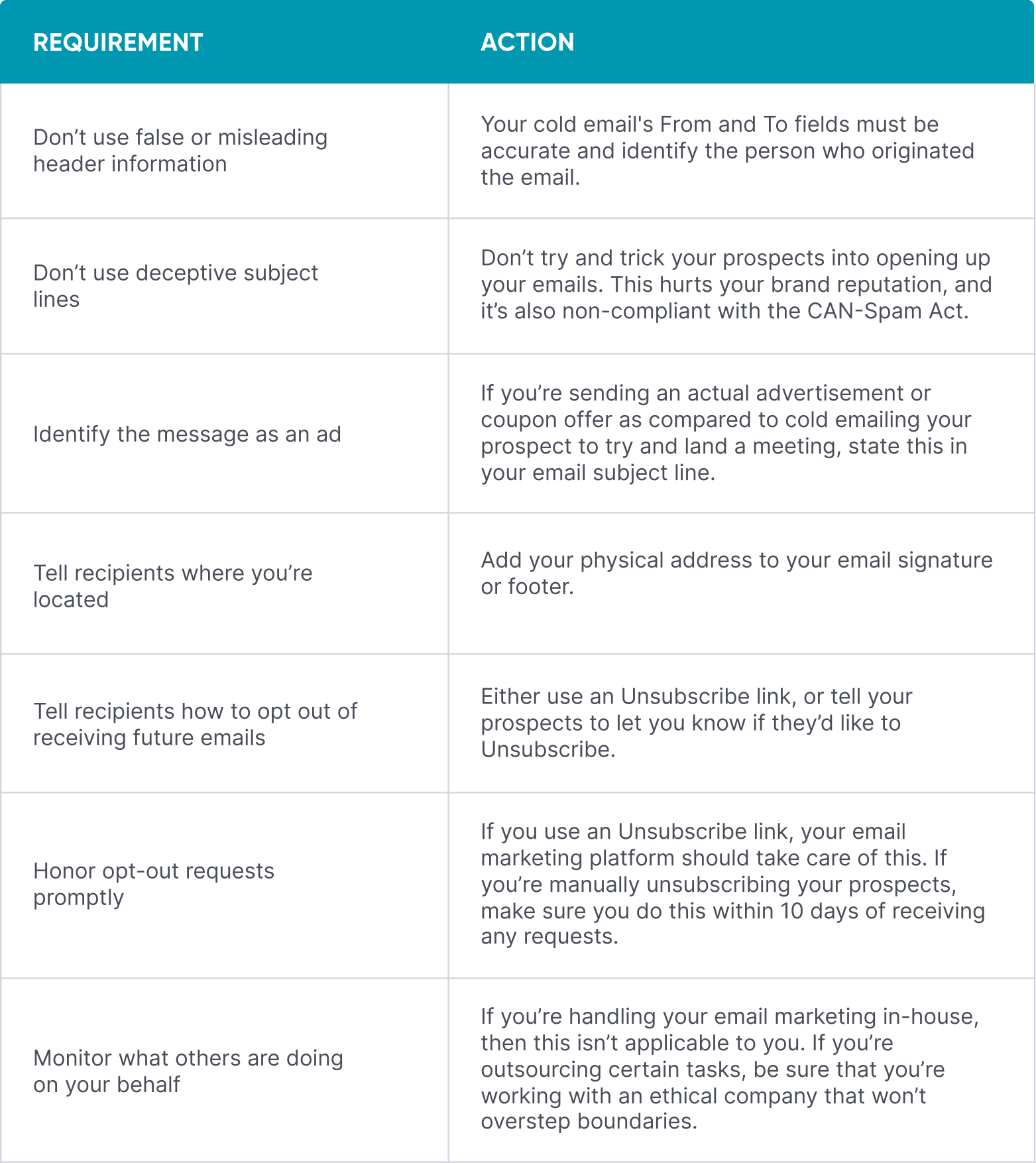
Over to you! Here’s a recap of how you can craft cold emails that are compliant with the CAN-Spam Act:
- Don’t use false or misleading header information
- Don’t use deceptive subject lines
- If your cold email contains an ad or coupon, state this in the subject line
- Add your physical address to your cold email signature
- Provide an easy way of unsubscribing from your emails
- Ensure that prospects who Unsubscribe are removed from your list within 10 days
- Ensure that any marketing agencies that you’ve hired are complying with the CAN-Spam
Examples of deceptive cold email subject lines:
Subject line: RE: Important News
Email copy: Newsflash – our AI chatbot tool is now on sale! Sign up for your first month at 20% off…
Why this cold email is deceptive: By using “RE:” in the subject line, you’re tricking your subscriber into thinking that this email thread contains some sort of correspondence between you and them. Not cool!
Subject line: Your company sucks
Email copy: Chances are, you receive angry emails from frustrated customers from time to time. Regardless of whether these customers are in the right or wrong, you don’t want them to take to social media to vent about your company, because this will generate the wrong kind of buzz from you. That’s where our customer feedback tool comes in…
Why this cold email is deceptive: This email subject line makes it seem like you’re a customer writing in with a complaint, when this isn’t the case. This misleads the subscriber, and goes against the CAN-Spam act.
Coming Up With an Ideal Customer Persona
Mark Godley @ LeadGenius
When putting together a cold email campaign, the very first thing you should do is to come up with an ideal customer persona or buyer persona. Basically, this persona represents your ideal customer – one who’s likely to spend big bucks with you!
Now, don’t make the mistake of skipping this step. Once you’ve established your customer persona, you can rely on this to determine which prospects are worth reaching out to with your cold email outreach (and which are probably a lost cause).
There are plenty of great guides on how to create a customer persona online, but to get you started, here are some things you can do:
- Analyze your closed deals in your CRM. What similarities are there in company types? Size? The profile of the buyer?
- Do a deep-dive on your customers with the highest Customer Lifetime Value (CLV). Again, identify similarities in company types and buyer profiles.
- Sit down with your customers with whom you’ve established a good working relationship, and ask them about their goals and challenges at work.
At the most basic level, you should have plenty of demographic data and firmographic data to work with.
For instance, you might identify that the ideal customer for your cold email outreach is between 30 and 45 years of age, holds a managerial position in the marketing department, and works in a company that has over US$1,000,000 in annual turnover.
That’s a good start… but it’s not enough.
The LeadGenius team has been cold emailing for a long time, and in our experience, it’s insufficient to rely on demographic and firmographic data when you want to evaluate whether a prospect is open to having a buying conversation. In your cold email outreach, you should also be looking at buying signals.
What are these buying signals? These are timing-related signals, such as business events, news, and anything that you can use to determine which prospects will be receptive to your cold email campaign.
At LeadGenius, our buying signals include:
- If a decision-maker has recently bought a product that complements our product
- If someone has recently been promoted or hired, and they manage a budget at their new position
- If a company starts investing heavily in a specific area that’s relevant to our product, suggesting that they might be making this a key focus of their strategy
- If a company secures either a Series B or C, or if a company goes public
- If a company gets an industry award or accolade
- If a former customer moves to another company that isn’t using our products
- IIf a company starts collaborating or working with another company, who is an existing client of ours
Over to you! Here’s how you can come up with an ideal customer persona and get started with your cold email campaign:
- Talk to your reps, pull out data from your CRM and interview your existing customers to identify what your ideal customer looks like. Make sure you’re not just looking at firmographic and demographic data, but also buying signals.
- Figure out where these buying signals might be found in the public record. Job postings, LinkedIn and news aggregation sites are always a good bet.
- Feeling ambitious? Talk to your tech team about setting up a crawler to automatically scrape and extract this information from websites to use with your cold email outreach.
- If you’re running a small startup and you don’t have any techies, there are plenty of online scraping tools that you can use as well. Alternatively, check out B2B data companies who are
- aggregating this type of information, and will allow you to access it in exchange for a small fee.
Case Study
Some time back, I was working in a SaaS company, and one of my responsibilities was to fine-tune our sales and marketing strategies.
After some investigating, I realized that the way we were doing things at this company didn’t quite make sense. Our sales reps spent more than 50% of their working hours conversing with folks who would never buy. While these prospects did fill in a form on our website to indicate their interest in our product, the fact remained that they didn’t fit our ideal customer persona, which meant that our reps were barking up the wrong tree.
Once this came to light, I decided that the best call was to delete 90% of the existing contacts from our database and start from scratch again. To be completely honest, my heart skipped a beat as I pressed the delete button in our CRM, but I knew that there was no justifying the huge waste of time and energy that our sales team was spending on these low-quality leads.
After that, my team and I assembled a team to build our in-house prospecting machine. On our team, we had a data manager, five data wranglers who were based overseas, someone who took care of sales operations and a project manager who coordinated all the details for us. We took six months and many man-hours to finish our prospecting machine, but it was worth our while. The results speak for themselves:
- Opportunities in our sales pipeline: 228% increase
- Dollars in our pipeline: 294% increase
- Net new opportunities (calculated per month): 1,663% increase
- Net new dollars (calculated per month): 1,120% increase
- Booking revenue: 91% increase
- Average sales cycle: 7 months decrease
The cherry on top of the cake? We did this using 30% fewer sales reps and improved our customer satisfaction levels. (More specifically, our number of booked deals that had gotten canceled in the previous six months fell by 100%.)
If there’s one takeaway that you get out of this case study, let this be it: always choose quality over quantity when it comes to prospects and leads. Instead of chatting up a hundred non-qualified prospects who won’t convert, focus your efforts on a handful of ideal customers who are a good fit for your company!
Finding Your Prospect’s Email Address
Alex Berman @ X27 marketing:
Now that you have sorted out your ideal customer persona, the next step for your cold email outreach is to identify the people you want to reach out to, and find their email addresses.
Identifying potential prospects for your cold email outreach is pretty straightforward. You research companies and individuals that might be a good fit for your offering, make sure they fit into your ideal customer persona, then decide who you want to reach out to.
Once you’ve done that, the next part of the equation is finding your prospects’ email addresses. There are several tools that you can use here, including UpLead.
Using UpLead to find your prospect’s email address
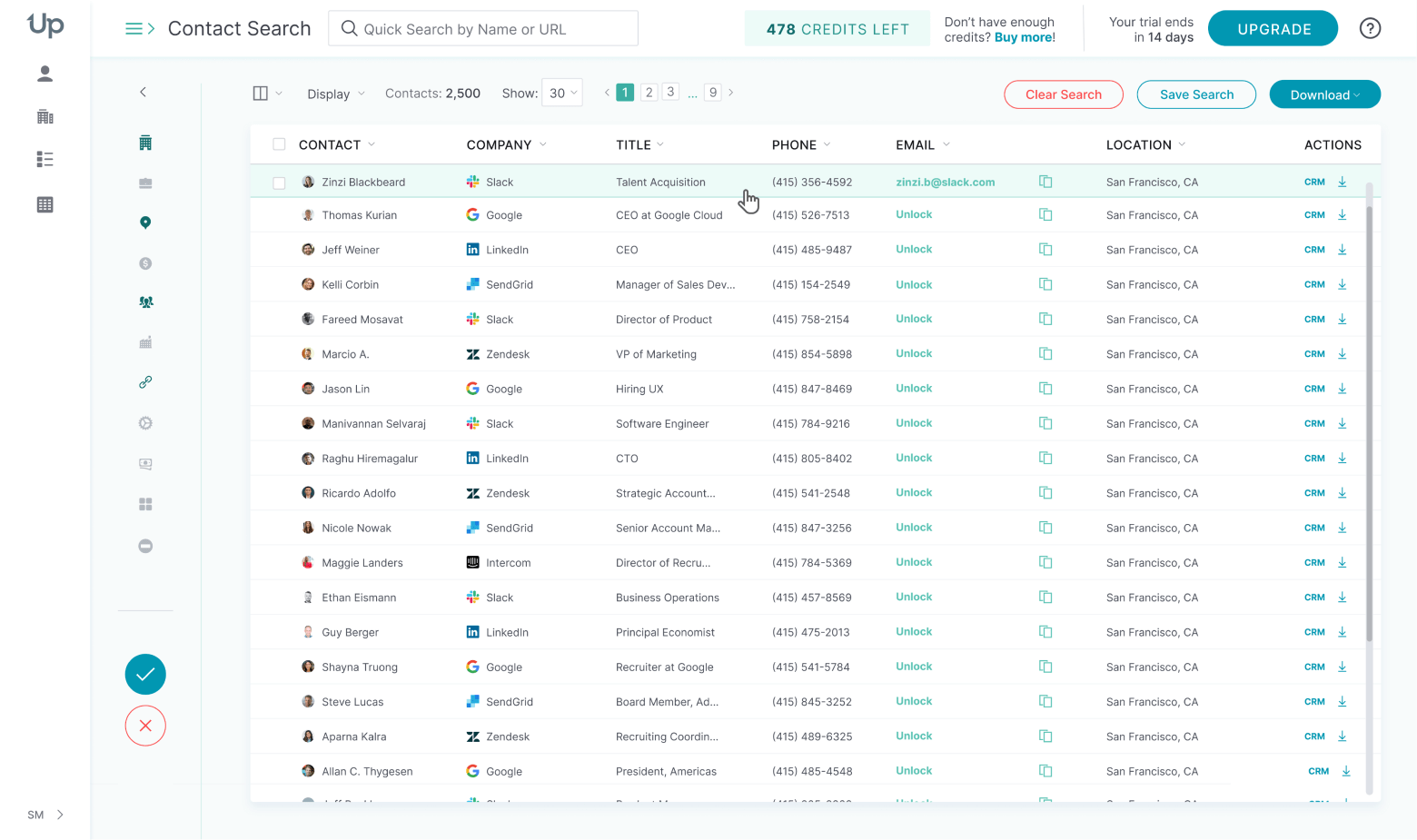
UpLead is a lead generation platform that allows you to build targeted prospecting lists and identify the email addresses of your potential customers.
Once you log into UpLead’s dashboard, you’ll get access to the tool’s database of over 54 million contacts in 200+ countries worldwide. You can comb through the database using 50+ criteria, including industry category, job title, geographic location, job function, and more.
Lead generation doesn’t have to be all that painful. With UpLead, you can easily connect with high-quality prospects and leads to grow your company.
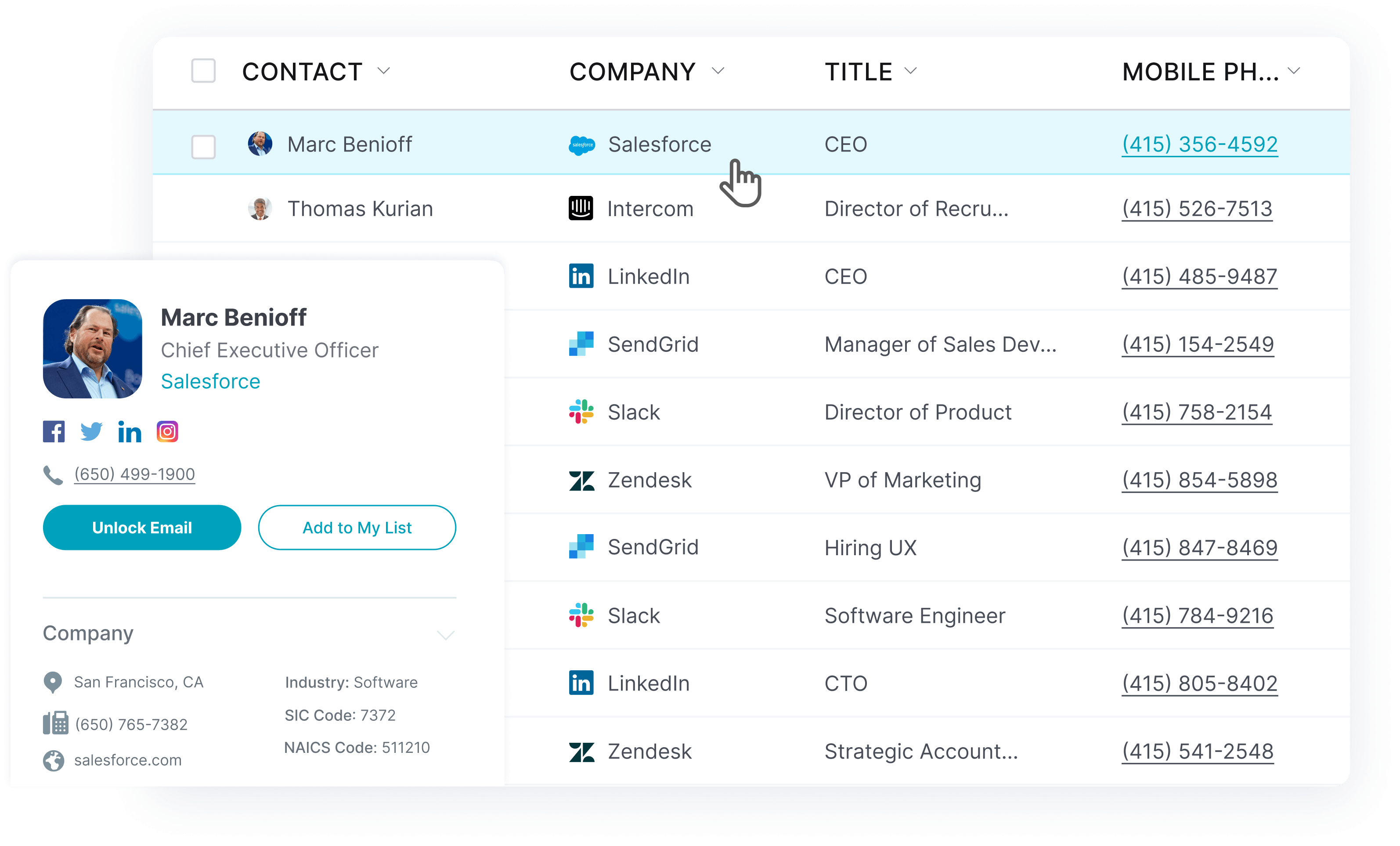
Once you’ve decided which prospects you want to reach out to in your cold email outreach, simply unlock their email address with a click of a button. For better accuracy, UpLead verifies its email addresses in real time before sharing them with you.
What if you’re trying to reach out to a prospect from a small company, and you can’t find any information on them using UpLead? In that case, your best bet is to look at the company’s social media pages and try and glean some information from there.
- LinkedIn: Look up the company’s LinkedIn page. LinkedIn will let you view the profiles of people who have specified that they work at a particular company, so you might just be able to find the founder or owner of the company here.
- Company website: Look at the testimonial or review page on the company’s website. Again, reviewers might mention the name of the business owner here.
- Facebook: Look at the “About” section and check if the name or email of the business owner is listed there. Also: if the page isn’t getting much traction, but you see that there’s someone who consistently likes every single post, that might just be the owner of the company.
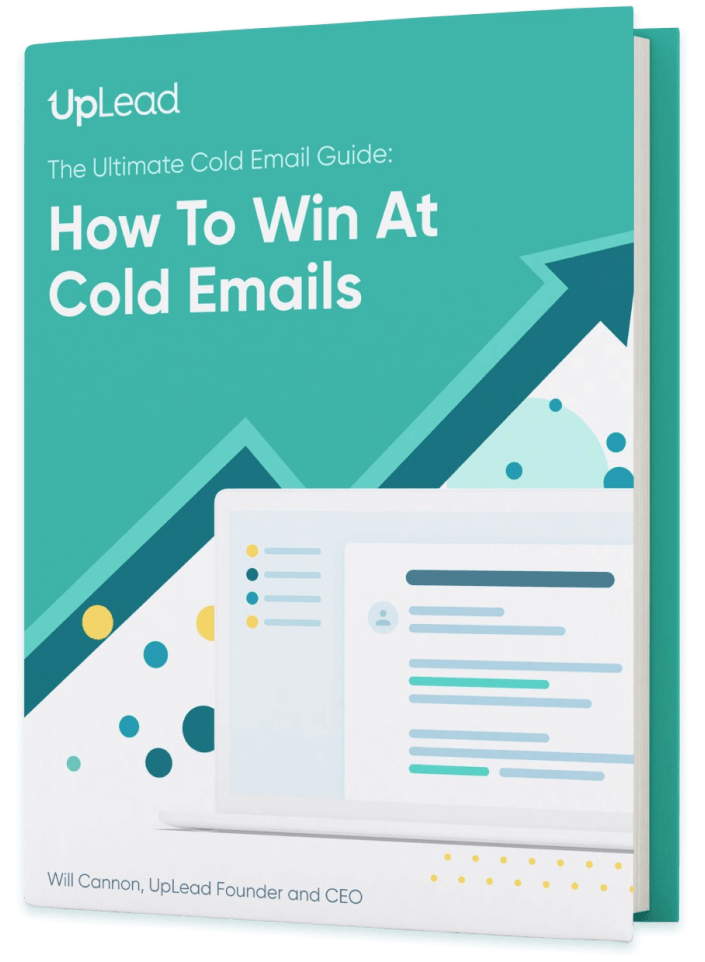
I agree to receive emails from UpLead, and can unsubscribe at any time.
Michael Tuso @ Chili Piper:
UpLead aside, there are a plethora of other similar tools in the market. In researching these tools, marketers often get overwhelmed trying to decide which tool to choose.
To help you out, I’ll walk you through a few things to consider and answer commonly asked questions such as:
- How many tools should you purchase?
- How do you figure out which tools to use?
- How do you maximize your results with these tools?
How many tools should you purchase?
If you have the budget and bandwidth, I recommend using at least two, but probably three to four tools. Keep in mind that the data accuracy differs from account to account, and how each tool collects and verifies its data is different as well.
Now, I know that subscribing to, say, four different email finder tools can significantly increase your monthly burn. That said, this is an area that you shouldn’t skimp on. If you try and hack this process together, there’s a high chance that you’ll have to compromise on your data accuracy, and without that, you have nothing.
How do you figure out which tools to use?
Here’s what you do: decide on your goals and identify the gaps in your workflow, then hone in on your ideal tool(s) based on that.
Now, keep in mind that not all tools have the same strengths. Some are better at enrichment. Others are much better for allowing reps to move quickly in adding prospects to cadences… and on it goes. You don’t want a one-size-fits-all solution here; instead, find something that’s laser-targeted to your company’s needs.
Also, as a general rule of thumb, you’ll want to use a tool that has a large enough chunk of your Total Addressable Market (TAM), so that the majority of the emails in their database will be relevant to you. On top of that, make sure the company is confident in their product and can promise a high data accuracy.
How do you maximize your results with these tools?
To maximize your results when using an email finder tool, keep track of the tool’s actual data accuracy to make sure you’re getting what you paid for. For instance, if you’re using a tool that guarantees 95% accuracy but you’re seeing bounce rates of 15%, reach out to their support team and ask them for a fix, or switch to another tool altogether.
Verifying your email list
Izabela @ Bouncer
Email verification, in a nutshell, is the process of validating email addresses to ensure that these addresses are real.
Before you set up your official cold email campaign and start sending out those emails, it’s important to verify the emails you have on your list. The idea is to “spring clean” your list to only consist of verified emails.
What happens if you don’t verify your emails before sending out cold emails? Assuming you’re using a trustworthy email finder tool and this tool’s database is accurate and up-to-date, then there’s no harm done. For those of you using UpLead, this tool also has an email verification built in, meaning you’re all set.
Lead generation doesn’t have to be all that painful. With UpLead, you can easily connect with high-quality prospects and leads to grow your company.

Suppose your email list happens to contain many outdated and invalid email addresses, on the other hand. In that case, this will increase your number of email bounces and hurt your email deliverability. In serious cases, your domain may even be banned from sending emails moving forward.
The good news is that you don’t need to go to the trouble of manually verifying your email addresses. Plenty of plug-and-play tools will do the heavy lifting for you: all you have to do is upload your email list to their platform and then download a verification report once the emails are processed.
Here are a few tools to check out:
BriteVerify
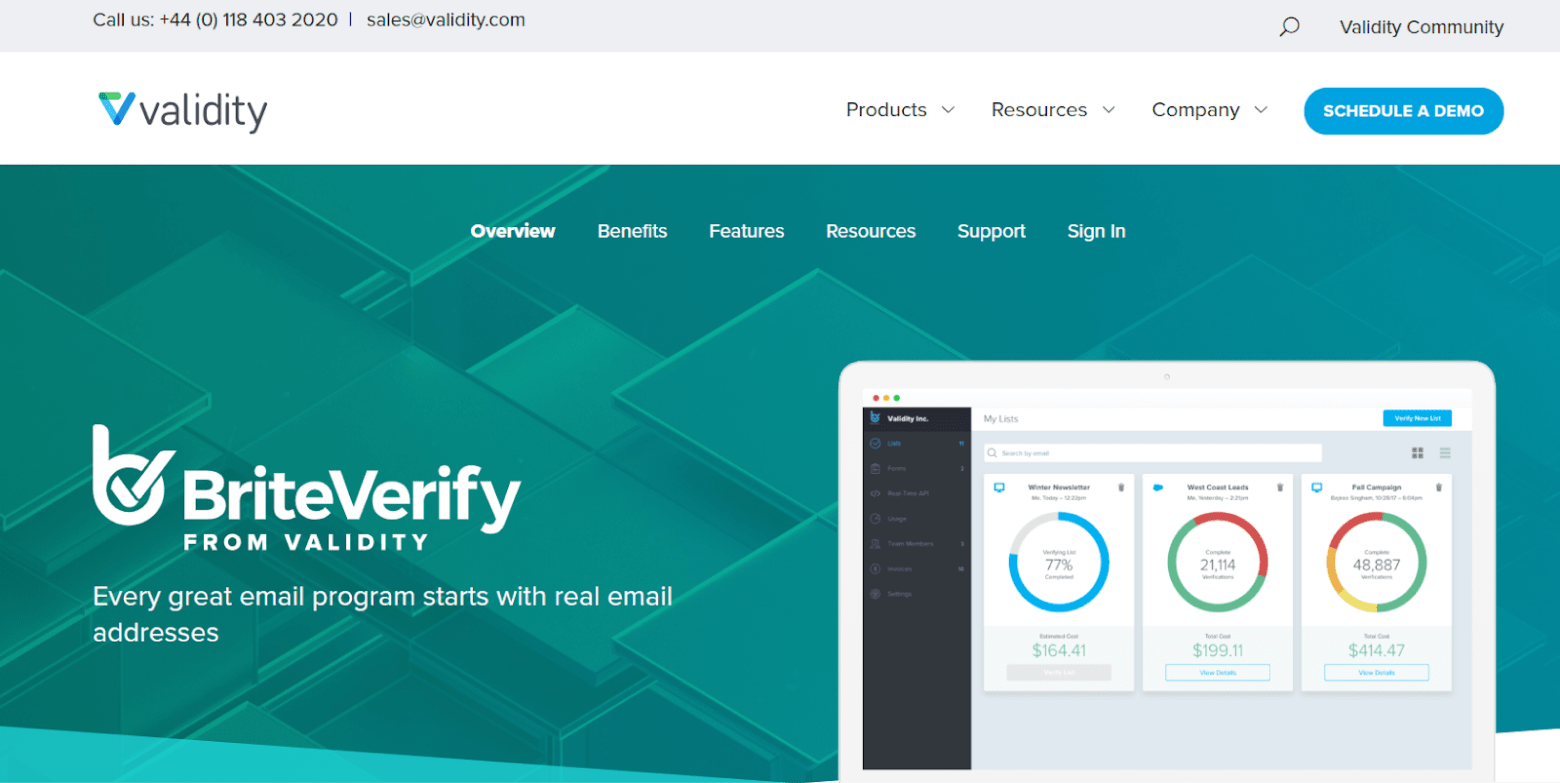
BriteVerify is a popular email verification tool that is used by businesses from across the globe. On average, the tool intercepts more than 1.5 million invalid email addresses every 24 hours, allowing businesses to improve the quality of their lists.
Bouncer
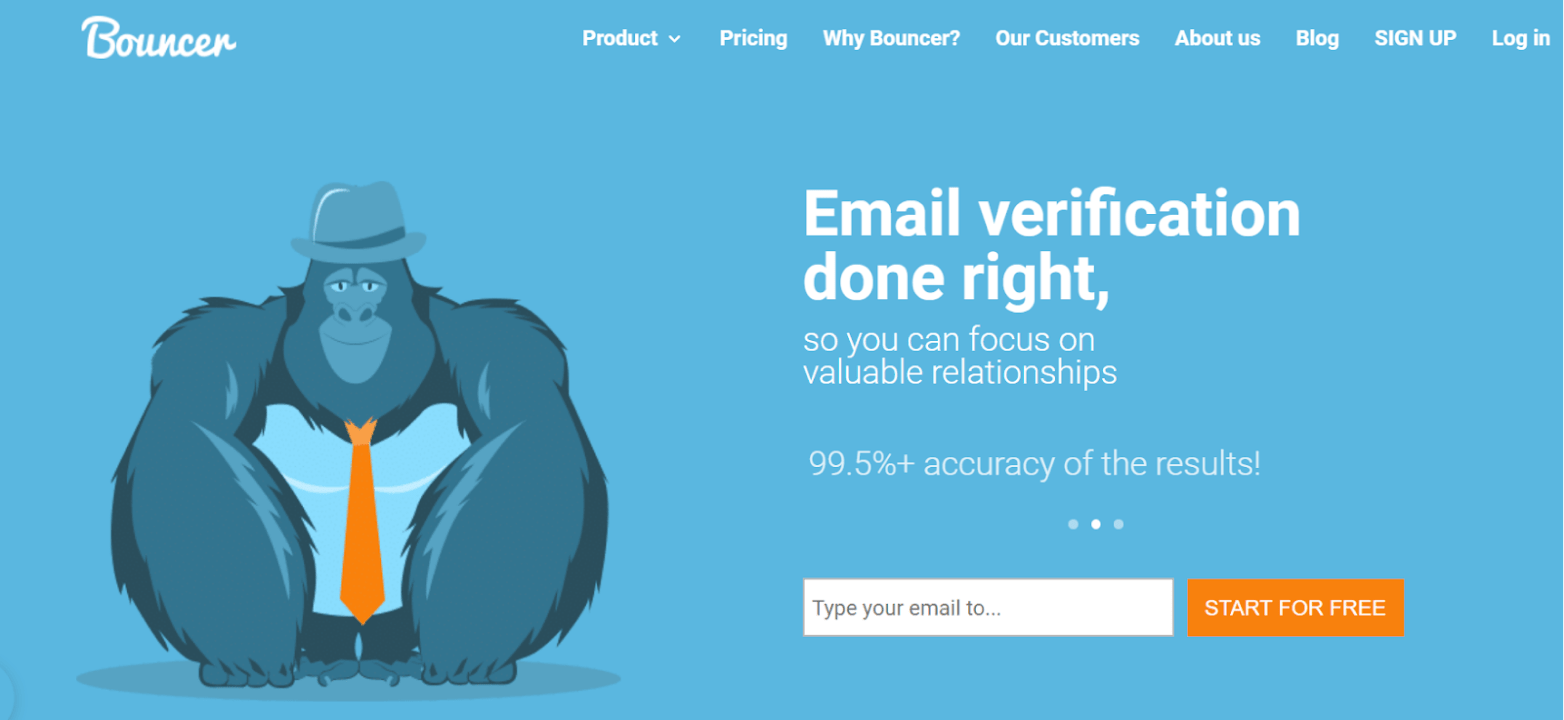
Bouncer is an email verification tool that guarantees 99.5%+ accurate results. With Bouncer, you can check email addresses for syntax errors, identify and filter out disposable emails, and learn which email addresses are likely to bounce (and are not safe to send to).
UpLead
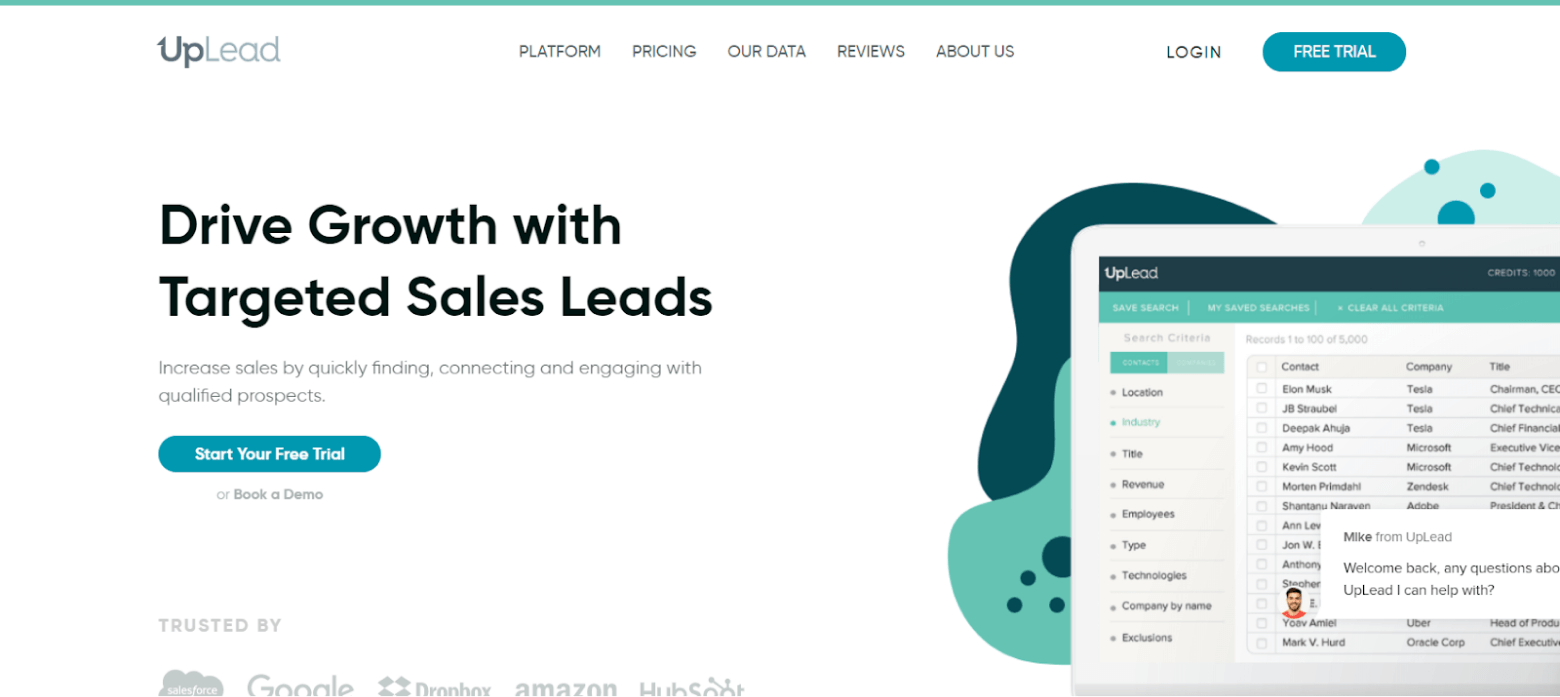
While UpLead is primarily a lead generation tool, it also provides real-time email verification as an add-on feature. Just upload a CSV file of your subscribers’ email addresses, and UpLead will filter this and identify which emails are Valid, Risky, and Invalid:
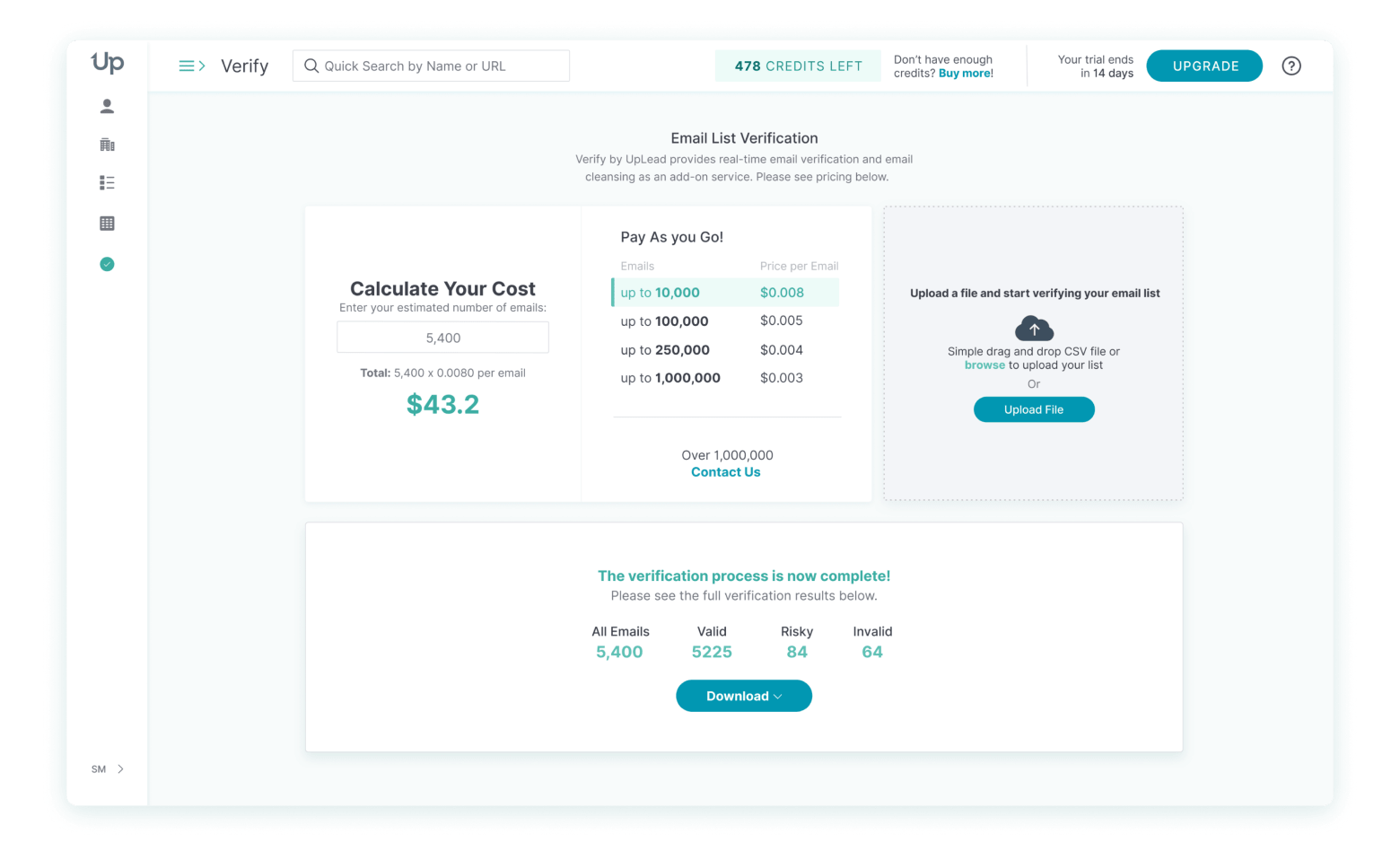
BriteVerify, Bouncer and UpLead aside, you can choose from plenty of other email verification tools. Shopping around for a tool that suits you best? Here are some things to keep in mind when evaluating different tools:
- Security and privacy. Where does the company store your data? What measures does it take to keep your data safe? Is the company GDPR compliant?
- User-friendliness. Most email verification tools provide free trials, so try out different tools and see which is the easiest and most intuitive to use.
- Level of support. What support channels do they offer? How quickly do they respond?
- Reviews. Instead of looking at the company’s testimonial page (which will naturally be biased), search for them on Capterra to see what people have to say about using their product/tool.
What are email bounces?
Bounces are emails that were sent out to the recipients but could not be delivered for some reason. These are categorized into two buckets – soft and hard bounces.
Soft bounces are temporary delivery failures, and they commonly occur when the recipient’s inbox is full, or the message size is too large. Because soft bounces don’t indicate that the address is inactive or invalid, so they do not significantly impact sender reputation (unlike hard bounces).
Hard bounces, on the other hand, are permanent delivery failures. A hard bounce may occur for various reasons: the email address might not exist or no longer be active, or the recipient’s server might have blocked emails from your domain.
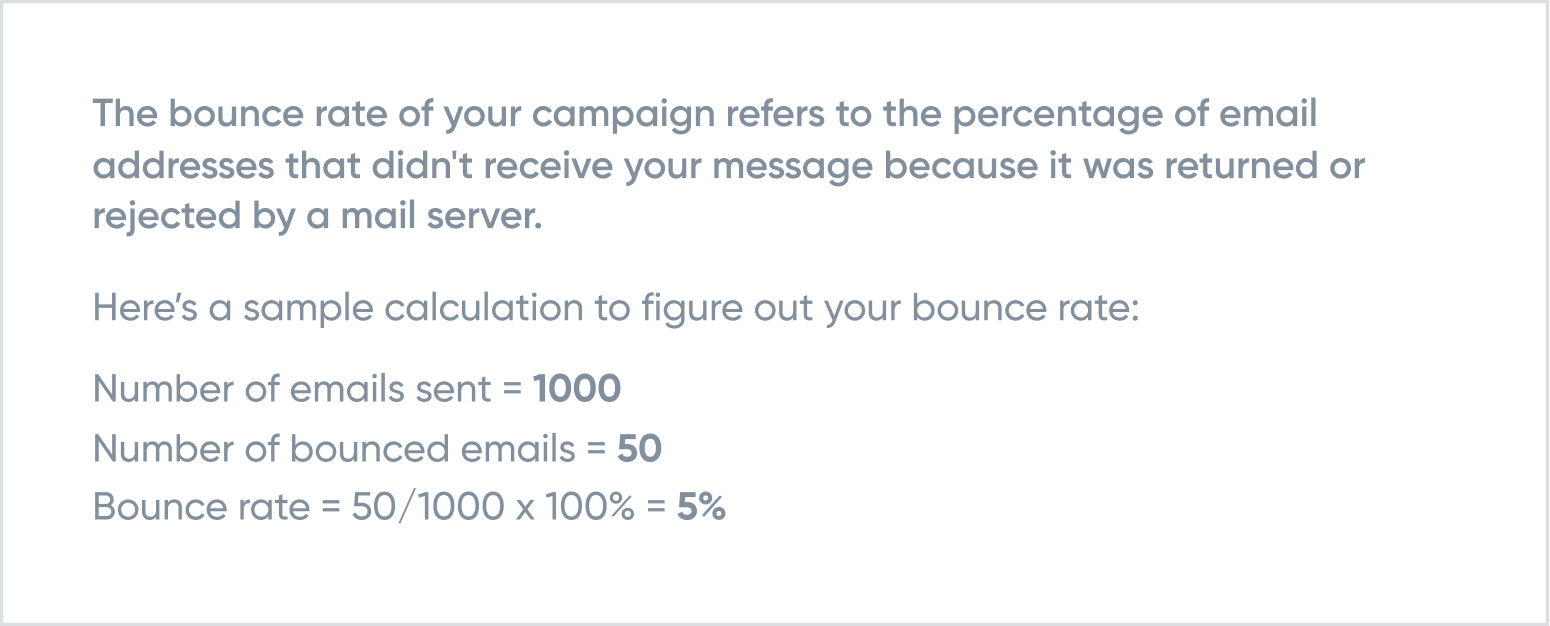
Email validation response codes
When you upload your email list to an email verification tool, you’ll get your results back in the form of email validation response codes such as “Valid”, “Invalid”, “Accept All”, or “Unknown”. Read on to find out what these mean and where you go from there.
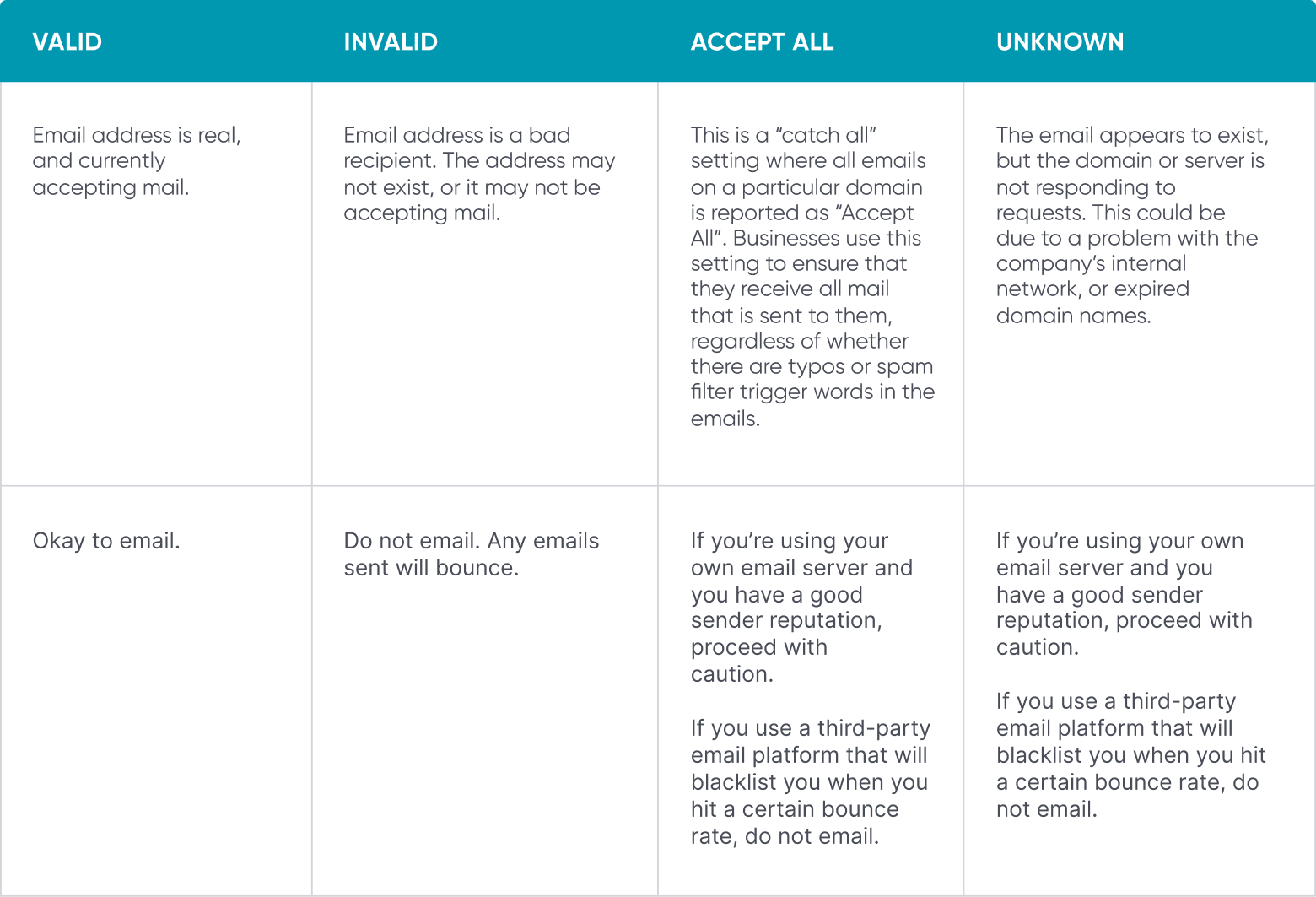
What is the sender’s reputation?
Sender reputation is a score that the Internet Service Provider (ISP) ISP assigns to each domain from which the sender sends emails. The higher your score, the more likely an ISP will place your email into the recipient’s inbox.
If your score is low, the ISP might send your emails to the recipient’s spam folder. Alternatively, you may also find your emails getting placed in the “Promotions” tab of a Gmail email account instead of the “Primary” tab
For best results, verify your emails as close to your campaign launch date as possible. If you clean your email list a month before the actual send out, there’s a high risk that some of the previously valid emails would have since become invalid. After all, statistics show that 23% of all email addresses become obsolete every 12 months!
Over to you! Here’s a quick recap of how you can verify the addresses in your email lists:
- Upload your lists into an email verification tool.
- Do this as close to your campaign launch date as possible. If your campaign is pushed back, conduct a second round of verification to weed out any email addresses that might have become invalid in the interim time period.
Email Segmentation: Segmenting To Make Your Email Relevant
Mary Siewierska @ Woodpecker.co
Segmentation is important for pretty much every email campaign, but it’s especially important for cold email campaigns.
Now, the idea of relevancy comes into play here. If you’re cold-emailing someone who doesn’t know you, your email needs to be hyper-relevant to them, or it’s headed straight for the “Trash” folder.
That’s where segmentation comes in. Segmenting your email list and crafting customized emails for each segment allows you to deliver content that truly resonates.
Here’s a quick breakdown of how to segment your email list
Step 1: Group your prospects into buckets based on their commonalities
Step 2: Create different segments in your email marketing platform using these buckets
Step 3: Identify a common denominator that you can build your email around
Step 1: Group your prospects into buckets based on their commonalities
Firstly, identify common features among your prospects, and group your prospects into buckets based on these features.
For instance, say everyone in your list of prospects holds a managerial position in a marketing department. In this step, you may choose to group the marketing managers in one bucket, the directors in another bucket, and the CMOs in yet another bucket.
Step 2: Create different segments in your email marketing platform using these buckets
Next, log into your email marketing platform and create different segments based on the above buckets. The next time you craft a cold email, you’ll be able to choose the specific segment (managers, directors, or CMOs) you want to send the email to.
Step 3: Identify a common denominator that you can build your email around
Finally, put on your thinking cap and identify common denominators among the people within each segment.
Yes, I know you’ve just done something similar in Step 1, but think of this as a more nuanced version where you’re taking your prospects’ needs, wants, goals, ambitions and challenges into consideration.
For instance, if you’re looking at a segment of new marketing managers (ie people who have recently been promoted from marketing executives to managers), the common denominator among these folks might be that they’re eager to prove themselves to the team.
Bearing this in mind, you might craft your email in a way that addresses this desire.
If you’re addressing CMOs, however, the common denominator might be that they’re concerned with hitting their targets and keeping the company’s shareholders happy. Again, you can tailor your email to address this desire.
Differentiating between prospects’ wants vs. needs
Aaron Ross @ Predictable Revenue
When creating segments, remember that you’ll find it significantly easier to sell to your prospects if you reach out to those most likely to “need” you.
If you’re not 100% sure how to distinguish between a “need” and a “want”, look at it from a consumer’s point of view. You need toilet paper, but you want fancy 5-ply toilet paper that your guests will swoon over.
In the B2B world, the same thing goes. Each and every company has products/services that they need, as compared to products/services that are nice-to-have (but they can live without).
For example, say your company produces an inventory management tool that businesses can use to streamline their operations.
For Person A, an eCommerce startup founder who’s in their first year of business, this tool might not be a necessity. If you’re talking to Person B who owns a bigger and more established
eCommerce company, though, chances are that they have a lot more issues with SKUs and inventory management to deal with, and this means they’ll see your tool as a necessity.
On the flip side, say you’re operating a financial consulting business, and you outsource Virtual CFOs to companies.
In this scenario, it would make sense to reach out to Person A – assuming they work with a small team, they might need additional resources and expertise when it comes to their finances. Person B, however, might already have an in-house CFO and financial department, which means they won’t deem your service as a necessity.
Catering to specific niches
Aaron Ross @ Predictable Revenue
As a general rule of thumb, the more niche you get with your segmentation, the easier it is to get your foot in the door. Again, this boils back to the idea of reaching out to your prospects in a way that’s relevant to them.
Picture this: you’re stuck in traffic on your way home from work, and you’re starving. On this particular day, you have a craving for spaghetti. Near your house, there’s a renowned Italian restaurant that’s earned rave reviews for its authentic dishes.
The Italian restaurant aside, your other option is a new diner that’s a short drive away. They also offer spaghetti and other food such as hamburgers, fish, and steak. So, do you take the risk on the new restaurant that seems to do everything… or do you eat at the place that you know serves excellent spaghetti?
Now, think of this in a business context: do customers want to buy a product that does everything, or do they want to buy a product that does the thing they need well?
Of course, it’s the latter. Don’t build and sell a confusing mishmash. Even if your product/service is amazingly versatile and caters to a wide range of use cases, make sure your segments are well-defined, so that you can hone in on the one use case that’s most relevant to each segment.
Over to you! Here’s how you can segment your email list before crafting your cold email campaign:
- Group your prospects into buckets based on their commonalities. Make sure these buckets (which are essentially your segments) view your product/service as a “need” instead of a “nice-to-have”, and drill down to specific niches instead of making your segments too broad.
- Create different segments in your email marketing platform using these buckets.
- Identify a common denominator that you can build your email around.
Building Rapport Before You Reach Out
Michael Tuso @ Chili Piper
So you’ve created your ideal customer personas, found your prospects’ email addresses, and defined your segments to better tailor your pitch. There’s one last step to take before you write your cold email… and that’s to build rapport!
Here’s the thing: if you approach cold emails the traditional way, and fire off an email to your prospect without building rapport, you’re starting from ground zero.
Your prospect doesn’t know you from Adam, and even if you craft the most compelling, charismatic email, there’s a high chance that they’ll ignore your email or delete it immediately.
When you take the time to build rapport first, on the other hand, this changes things.
Maybe your prospect now recognizes you as the guy who’s responded to him a few times on Twitter. Maybe they remember the InMail that you sent him on LinkedIn. Even if they find your name familiar without really recalling who you are… that might be all you need to get your foot in the door.
Convinced that it’s worth your time to build rapport? Here are a few channels, strategies and methods that work the best for us at Chili Piper:
- Social media
- In-person events
- Doing something for your prospect
- Asking for your prospect’s advice
Social Media
Social media is a great way to get in touch with prospects and stay relevant to their world (or at minimum, get them to recognize your name).
If your prospect is highly active on LinkedIn, for instance, you can endorse your prospect’s skills, engage with their posts, send an InMail saying hi, or share something of value to them.
For example, say I want to reach out to Brian Dean from Backlinko. I might share one of his LinkedIn posts on my own feed and tag a bunch of friends/colleagues in it…
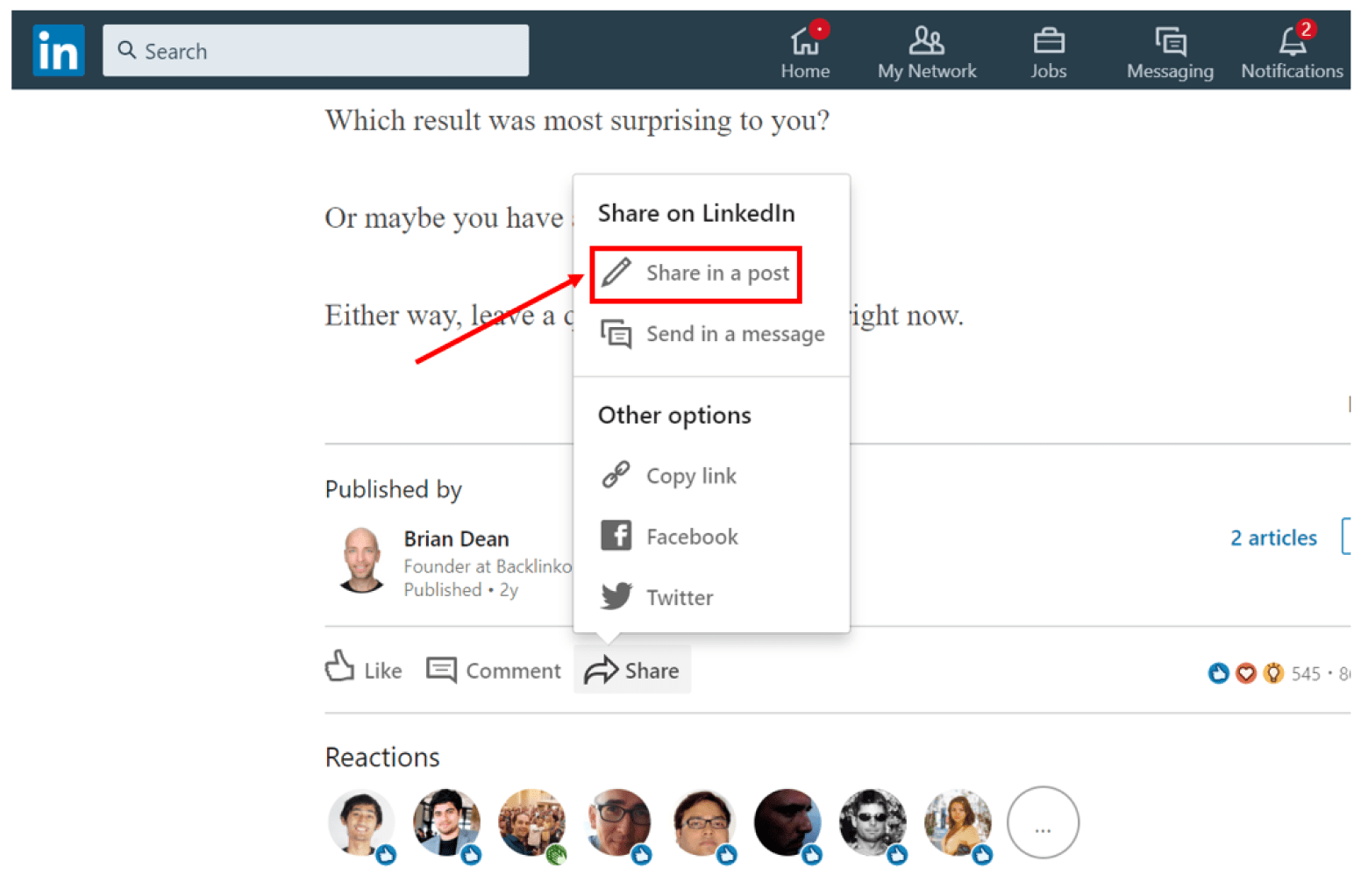
Then reach out to Brian in an InMail, thanking him for the insightful post and telling him that my colleagues found it really useful.
LinkedIn aside, you can also connect with your prospect on Facebook or Twitter. The technique you’d use is similar: engage with your prospect’s posts, keeping in mind that a Comment or Share is much more impactful than a Like:
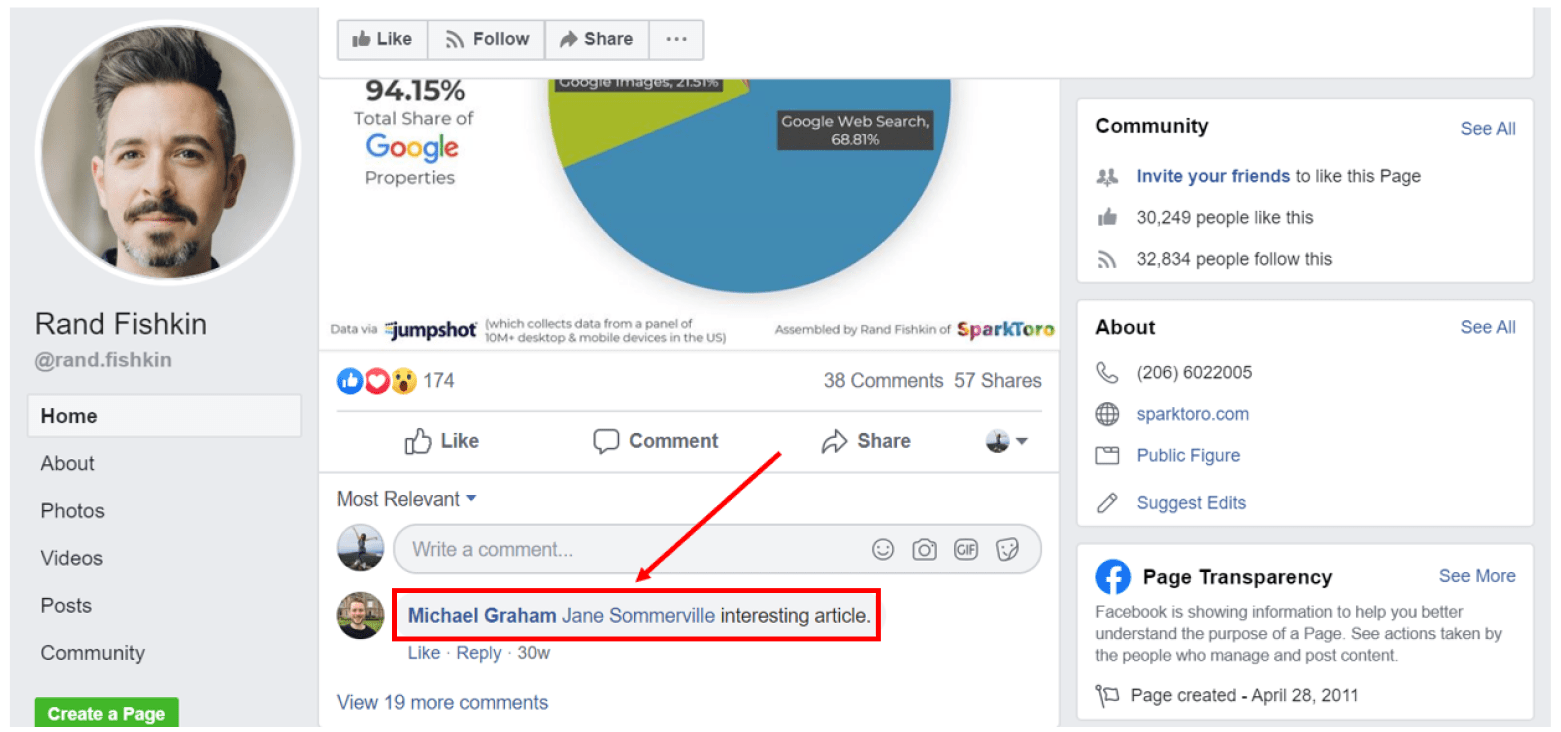
If your prospect hasn’t completely privatized their Facebook profile, you might also see the Groups they’ve joined. You can then join the same groups and engage with their posts within that group.
In-person events.
You can also build rapport through in-person events such as your company’s hosted conferences, external seminars, workshops, meetups, etc. In the best case scenario, you’d get to pitch to a potential customer during an event, and they’d agree to meet with you immediately after.
That said, things rarely move this fast in real life, and it’s fine if you don’t nail any meetings right off the bat. Just keep networking and connecting with your prospects so that they’ll recognize your name when your cold email lands in their inbox.
Doing something for your prospect
Heard of the concept of reciprocity? Basically, when you do something nice for your prospect, they’re likely to want to return the favor.
So: introduce your prospects to someone within your network. Send them a personalized gift (I recommend Sendoso for this). Share a case study that’s relevant to their current situation, and can help them achieve their goals.
Asking for your prospect’s advice.
Everyone wants to feel that they have reached a point in their career where others perceive them as an expert – that’s why it’s so flattering when someone asks for your advice.
While this is an easy way to start a conversation and get to know your prospect, make sure you’ve done your homework! If your prospect is an expert at SEO marketing and you’re asking them about social media, you may come across as inauthentic.
Over to you! Here’s a recap on how to build rapport before reaching out:
- Engage your prospect on social media
- Connect with your prospect via in-person events
- Do something nice for your prospect: send them a personalized gift, introduce them to a valuable contact, etc.
- Ask for your prospect’s advice
How to Write a Cold Email: The REPLY Method
Jason Bay @ Blissful Prospecting
Here’s what most marketers do when crafting their first ever cold email campaign: they sit down, Google “cold email templates”, then pick a template and plug in information about their company.
Personally, I’m not a fan of that approach.
Yes, templates are helpful and can give you inspiration about how to pitch to your prospect in your cold email. That said, you want to experiment with different copies and formats, and figure out what works best for you.
At Blissful Prospecting, we rely on five building blocks to craft powerful, effective cold email campaigns. We call these building blocks the REPLY Method:
- Results. Prospects expect to see relevant results you’ve created for similar companies with similar challenges. Focus on the results you can create for them.
- Empathy. Prospects want to feel understood. They expect that you know about their job, their responsibilities, and the challenges they’re having. Lead with your prospect’s challenges.
- Personalization. Prospects are inundated with terrible outreach these days. They expect personalized communication that shows the outreach was intended for them. Show prospects your outreach was purposeful.
- Laser-Focus. Prospects deal with more distractions than ever daily. They expect brief, succinct communication. Keep it short and sweet.
- You. Prospects don’t care about you, your product/service, or your company. Make your prospects the hero.
Let’s see the REPLY Method in action:
Results
Your goal here is to get your prospect’s attention.
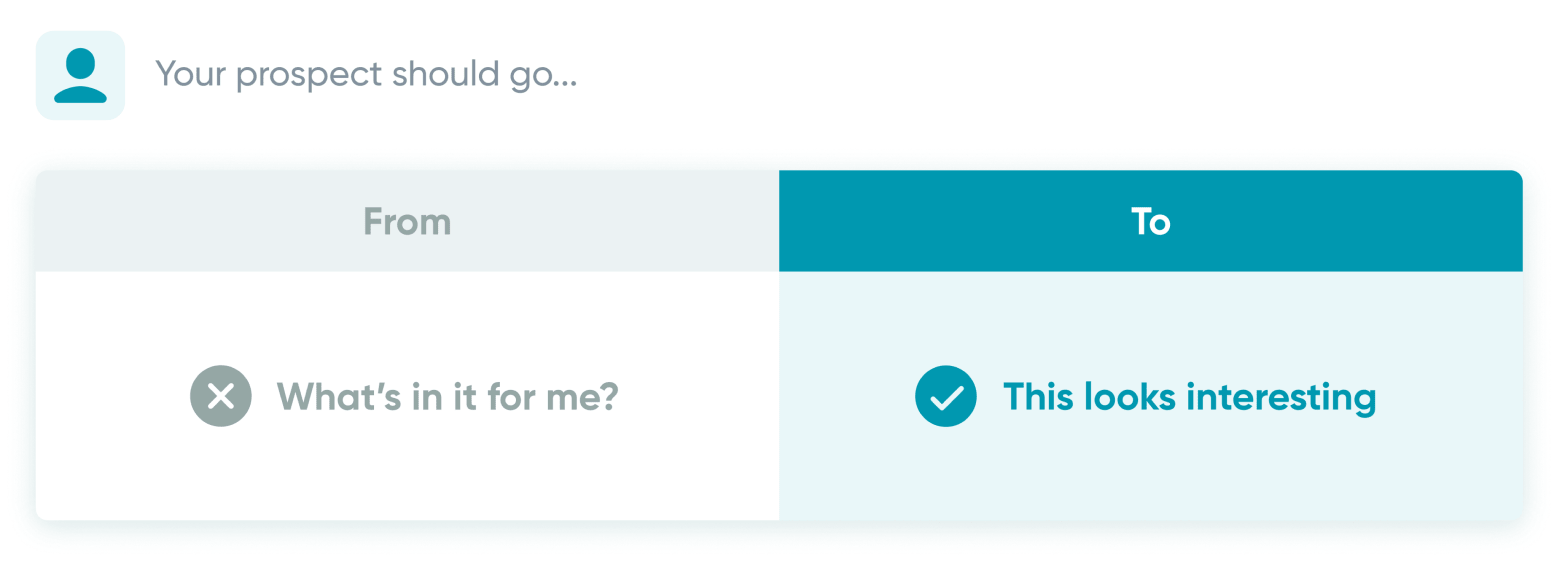
Remember: Prospects don’t care about the features of your product. Or how great your company is. They care about the results. How can you make their job easier? How can you help them grow their business?
Here’s an example:
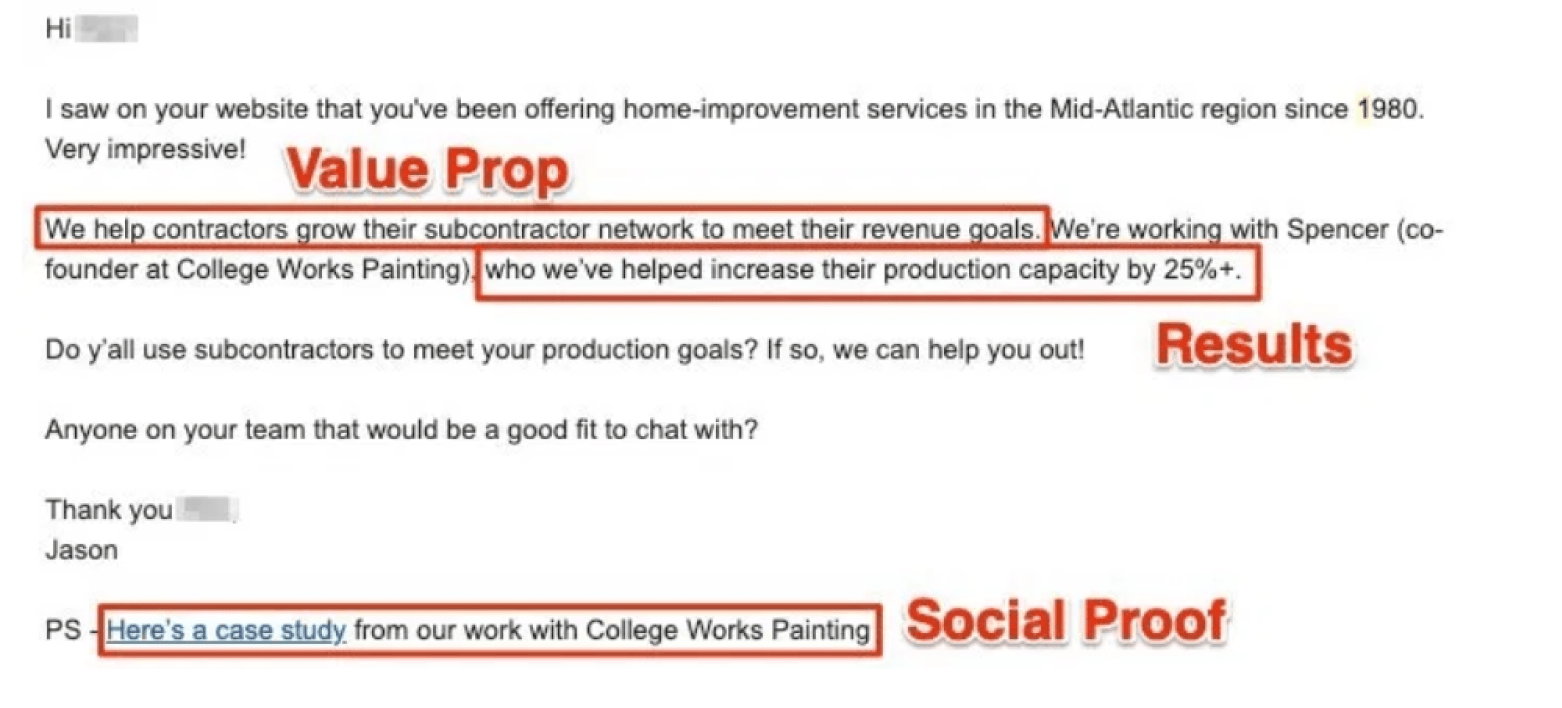
Over to you! Here’s how you can focus on the results when crafting your cold email campaign:
- Don’t prospect to make a sale. Prospect to start a conversation.
- Use case studies your prospect can relate to within their industry.
- Share stories about similar companies you’ve helped. Share specific numbers (key metrics, ROI, etc) if possible.
Empathy
Your goal here is to show the prospect you’re one of them.
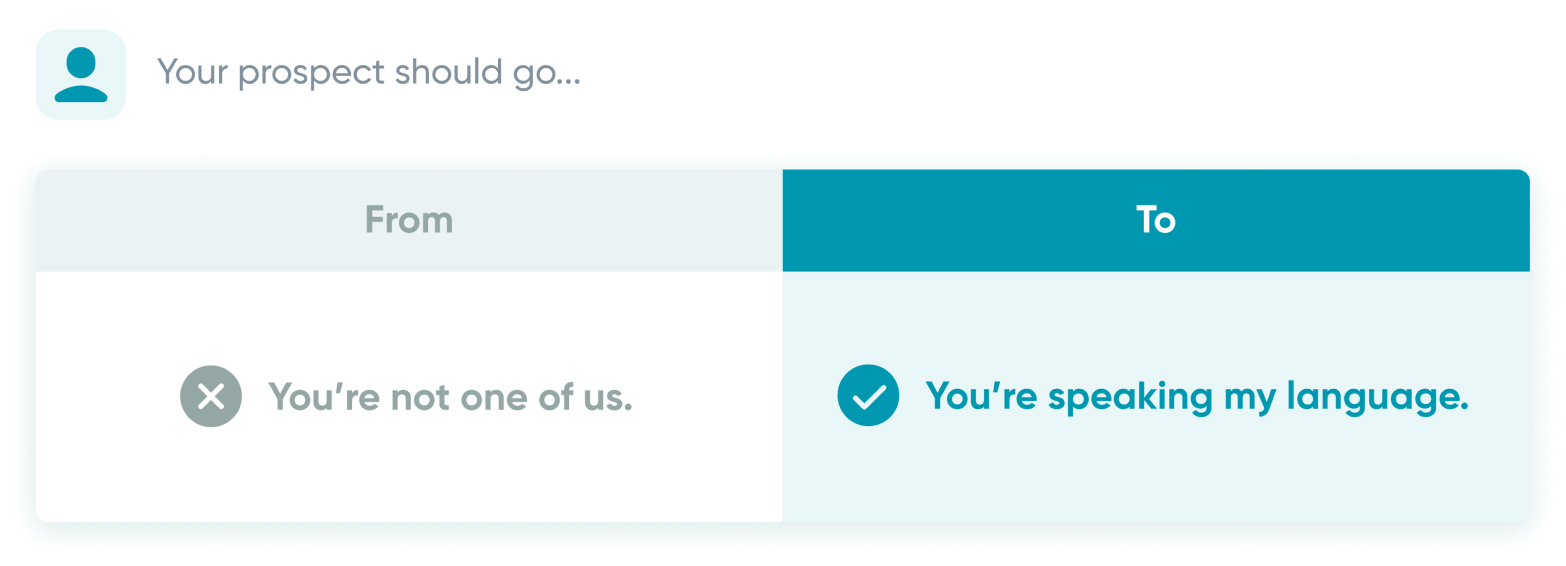
There’s a lot of confusion on exactly what empathy is in sales. It doesn’t mean that if a prospect is feeling frustrated, you should also feel frustrated.
Instead, it’s about showing the prospect you know what it’s like to walk in their shoes. You know what they might be frustrated or challenged with related to how you can help them.
Here’s an example
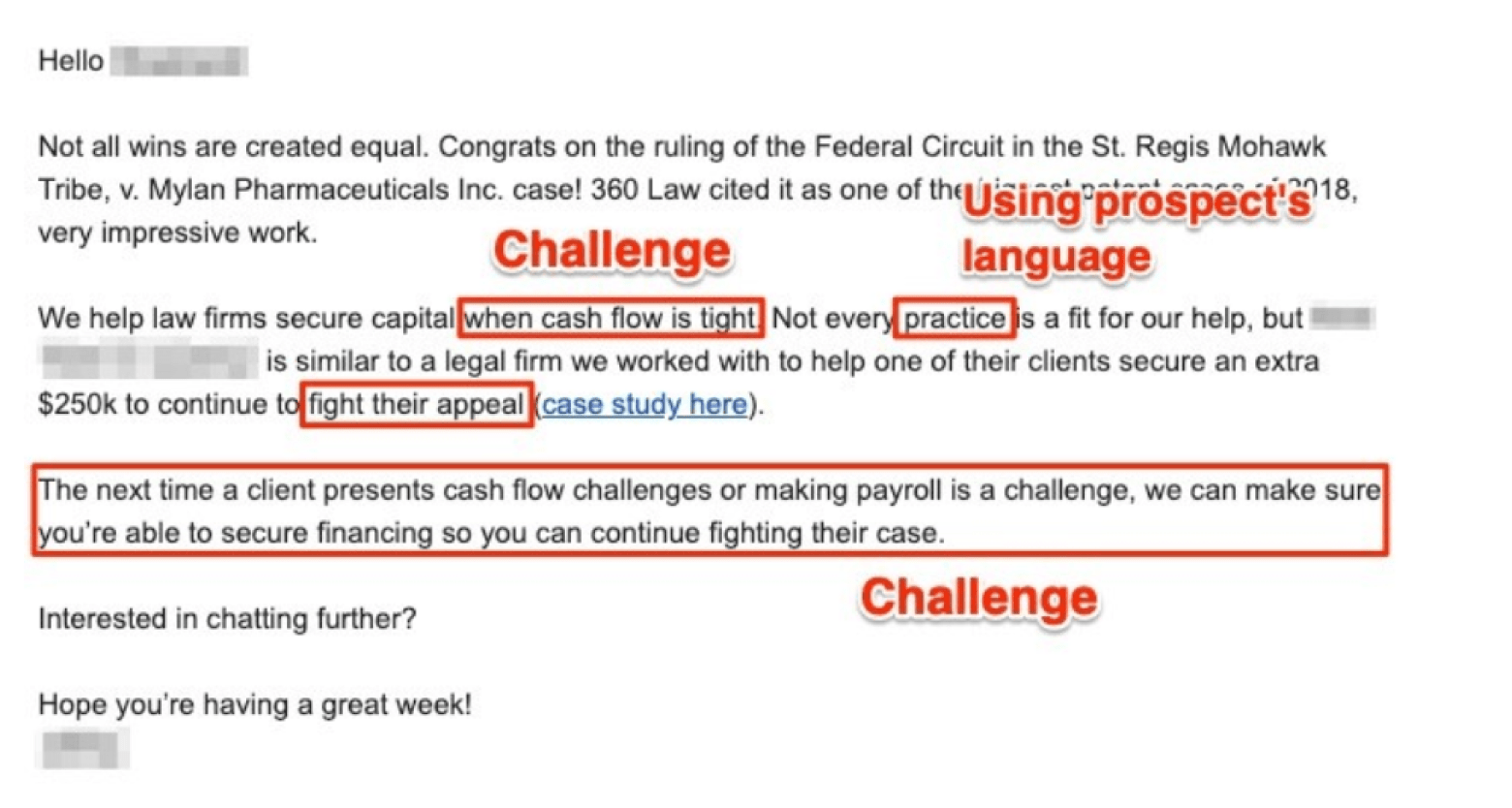
Over to you! Here’s how you can empathize with your prospect and build rapport with them:
- Lead with your prospect’s pain and frustrations related to how you can help them.
- If you’re unsure about your prospect’s challenges, interview them.
- Use language in your emails that prospects relate to and understand.
Personalization
The goal here is to show you’re not a spammer and that your outreach was intentional.
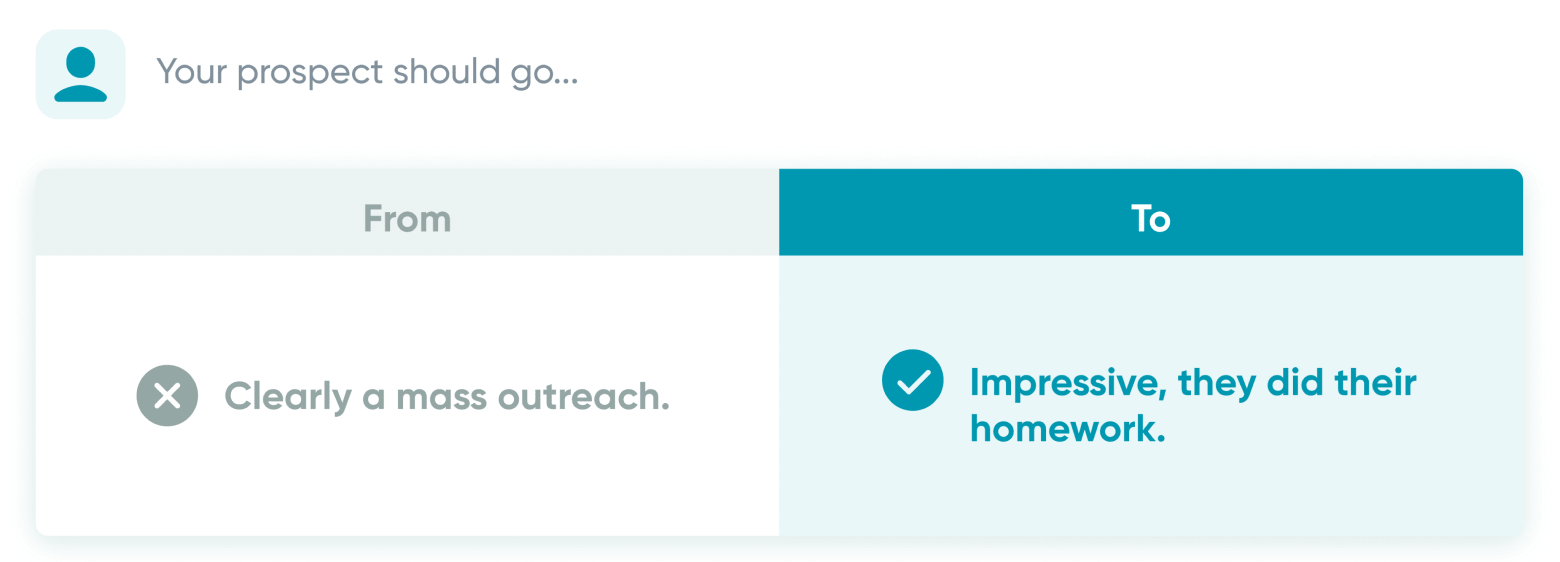
Just about anyone can send mass email outreach for a few dollars each month.
This creates a lot of clutter in everyone’s inboxes.
You need to show the prospect you did your research and that your email was meant for them. Not an email list.
Here’s an example:
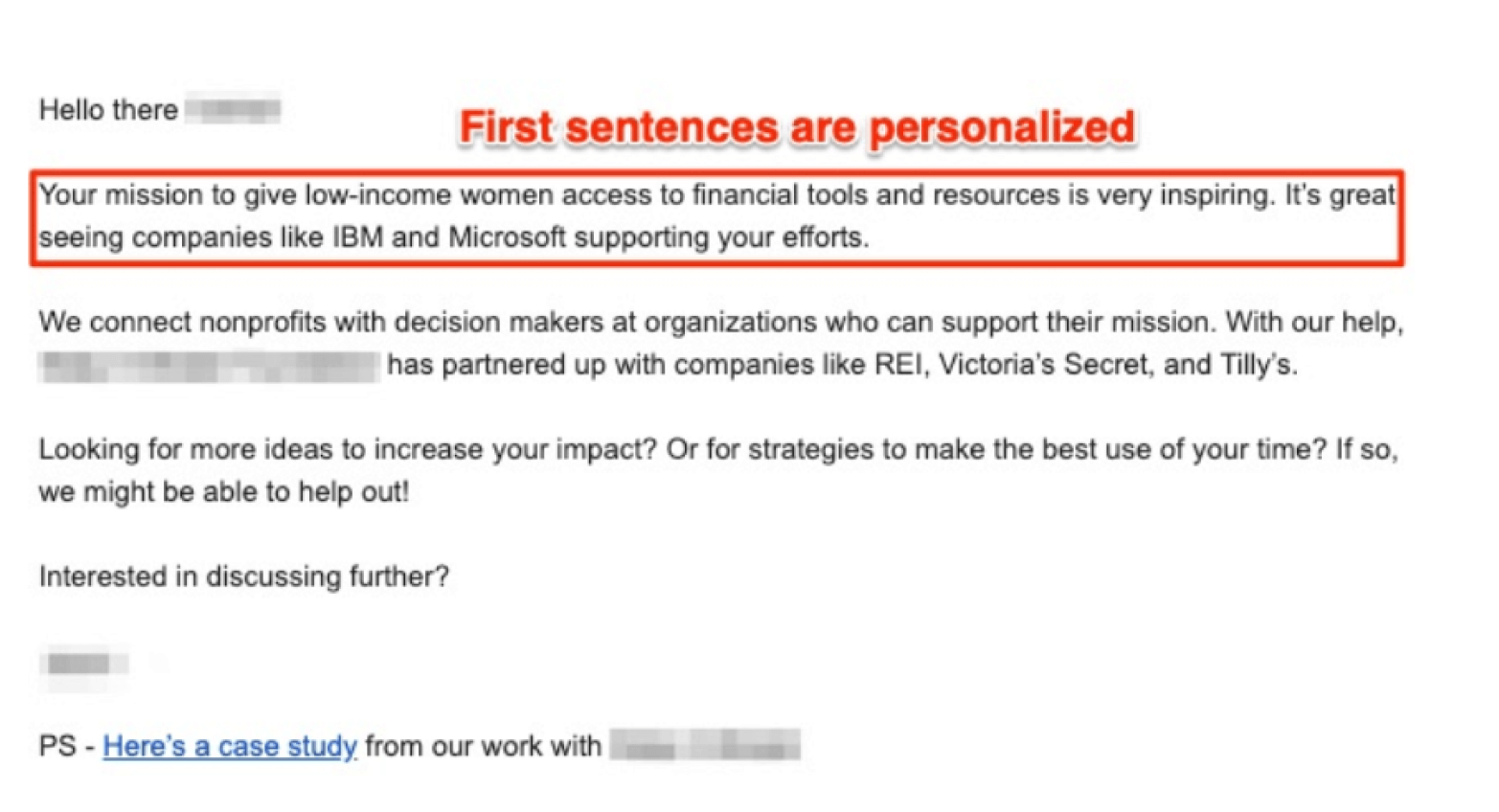
Over to you! Here’s how you can personalize your email when crafting your cold email campaign:
- Don’t send the same message to everyone. Segment your outreach by persona, like we talked about in the previous chapters.
- Give your prospect context into why your solution fits them well. Tailor your messaging
- Use 1-to-1 videos to further personalize your emails.
Laser-Focus
Your goal here is to get to the point and get your prospect interested in the shortest amount of time possible.
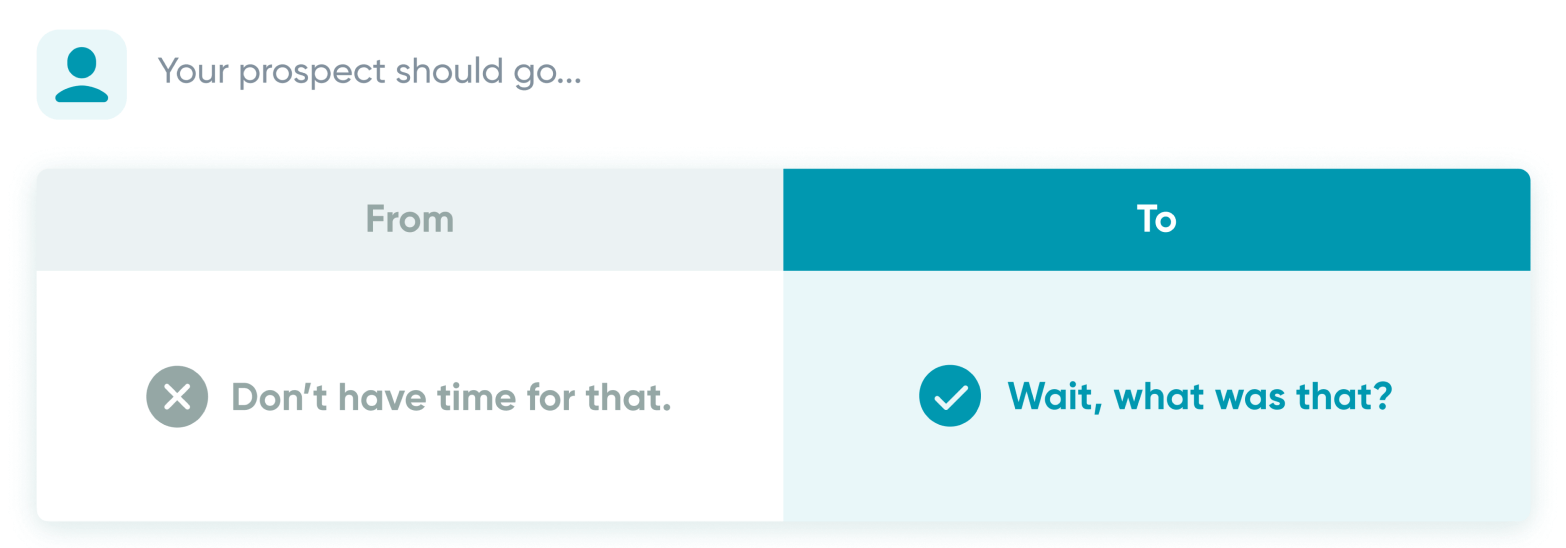
Everyone’s busy. When was the last time you read an email with more than a few sentences? Especially if it was from someone you don’t know?
Prospects are the same way. Keep it short, sweet, and to the point.
Here’s an example:
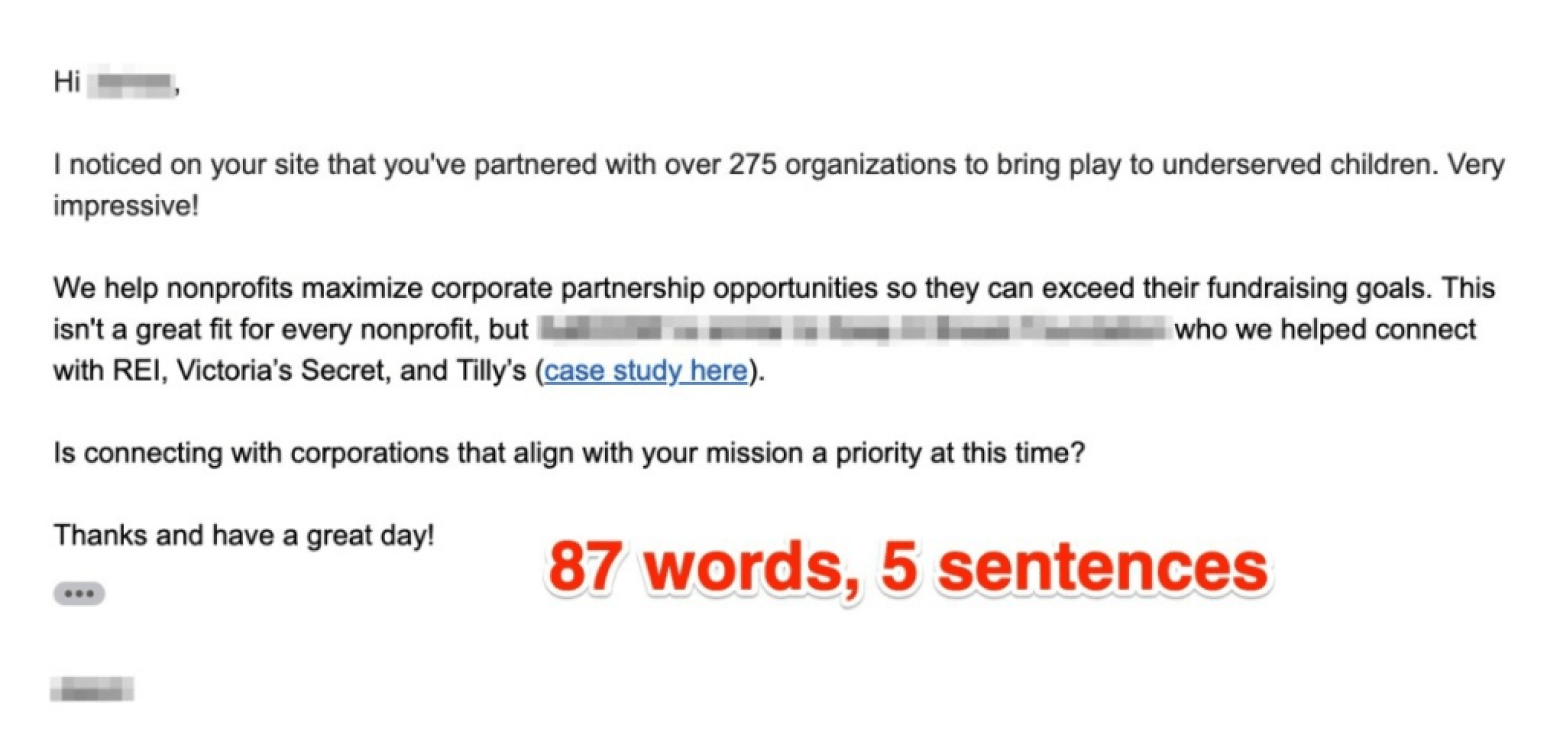
Your email copy aside, your Call-to-Action (CTA) also needs to be laser-focused.
In the example above, it’s clear that I want the prospect to reply and answer my question: “Is connecting with corporations that align with your mission a priority at this time?”
If you don’t use any CTAs, you end your email on a weak note, and this doesn’t motivate your prospects to respond to your email.
If you pepper your email with multiple CTAs, you’ll get replies that are all over the place – some prospects may comply with CTA 1, but not go through with CTA 2, some might do the opposite, and the majority will likely not act at all.
With this in mind, make sure you use just one CTA, and state this clearly in your cold email.
Over to you! Here’s how you ensure that your cold emails are laser-focused:
- Use less than 120 words or three to five sentences for your emails.
- Use one Call-to-Action (CTA) and be clear with your ask.
- Go through your email copy, and evaluate every sentence: does it help the prospect see the results you can help them create, empathize with them, or provide the context through personalization? If not, get rid of it.
You
With the last building block of the REPLY method, the goal is to make the prospect the hero.
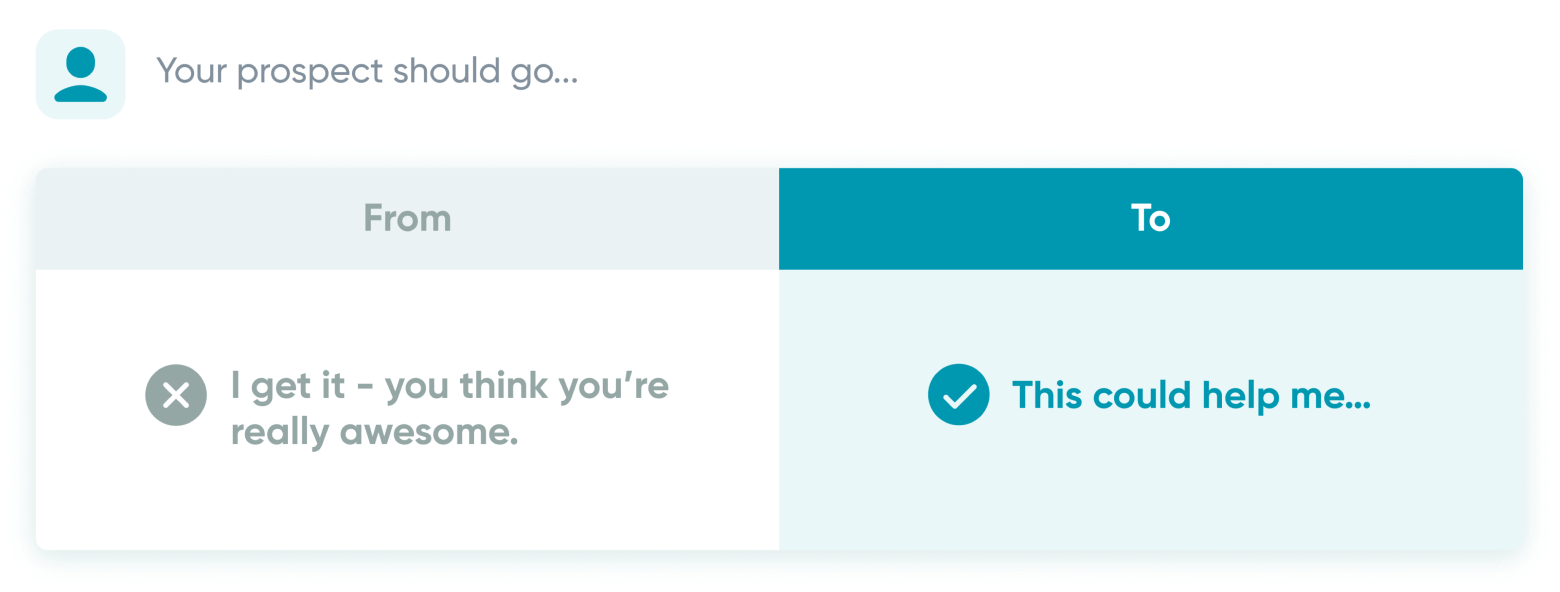
Talking about how awesome you or your company is doesn’t work, plain and simple. Instead of making your solution the hero, make the prospect the hero. Talk about how you can help the prospect win, not how great your solution is.
Here’s an example:
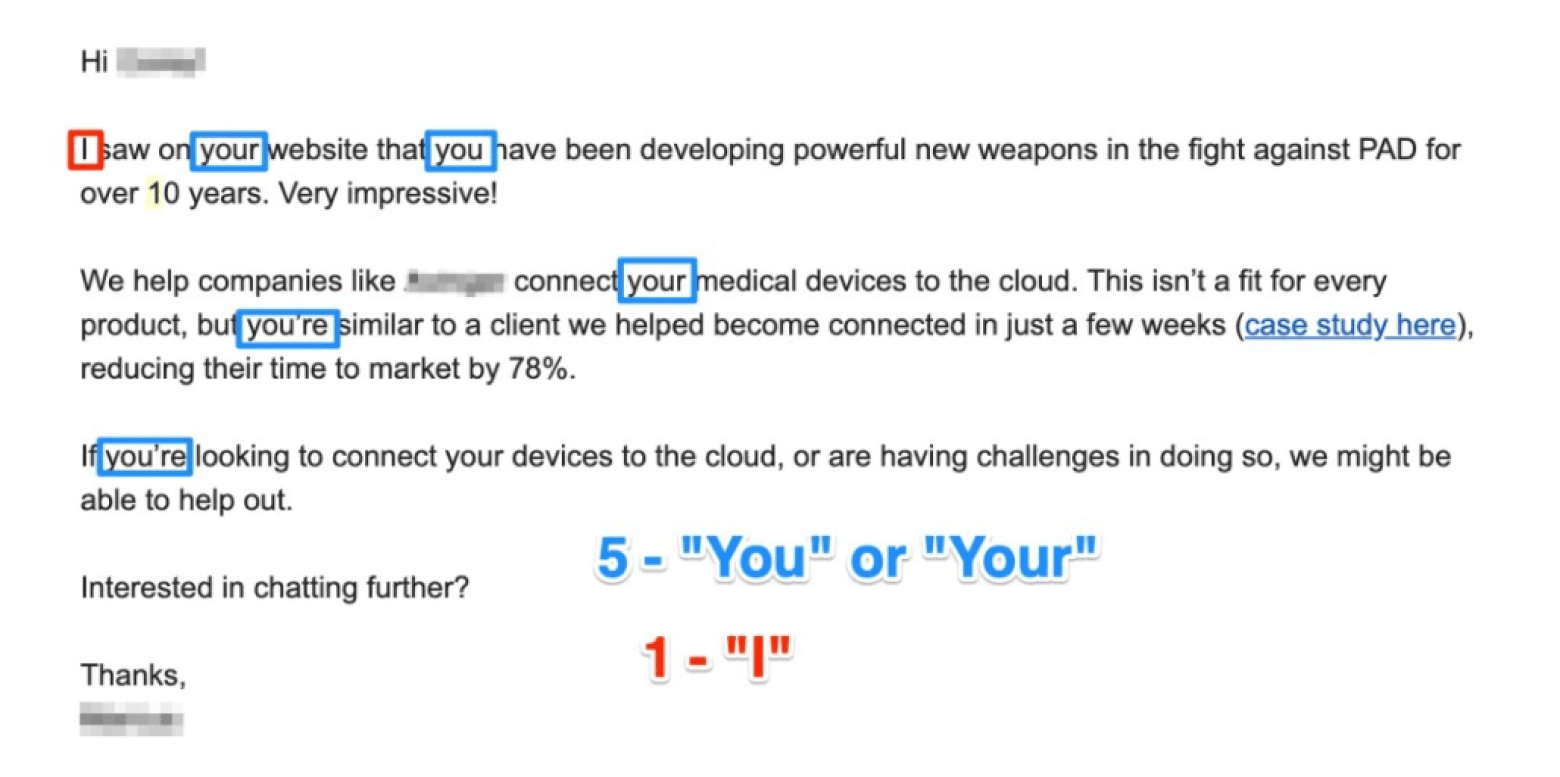
Over to you! Here’s how you prioritize your prospect in your cold email:
- No one wants to be Alfred. They want to be Batman. Make it about the prospect.
- Use “you” and “your” more than you use “I.”
- Tell (even better, show) the prospect what’s in it for them.
The Art of the Cold Email Subject Line
Sujan Patel @ Mailshake
Now that you know how to structure your cold email using the REPLY method, let’s delve into another important component of cold emails – subject lines.
Why are subject lines such a big deal?
Well, studies show that 47% of email recipients decide whether to open their emails based on the subject line alone, which means that your subject line can make or break your entire cold email campaign.
In this chapter, I’ll walk you through several tips that you can use to optimize your subject lines:
- Keep subject lines short
- Use a casual tone
- Reference deals in subject lines
- Personalize subject lines
- A/B test subject lines
Keep subject lines short
Lengthy subject lines on emails are a no-no. Instead, your subject lines should be short, snappy, and readable on any device.
How short is short? Different email clients display varying subject character lengths – while Android (480 x 320px) only reveals 27 characters on its portrait screen, Gmail on browser allows for 70 characters.
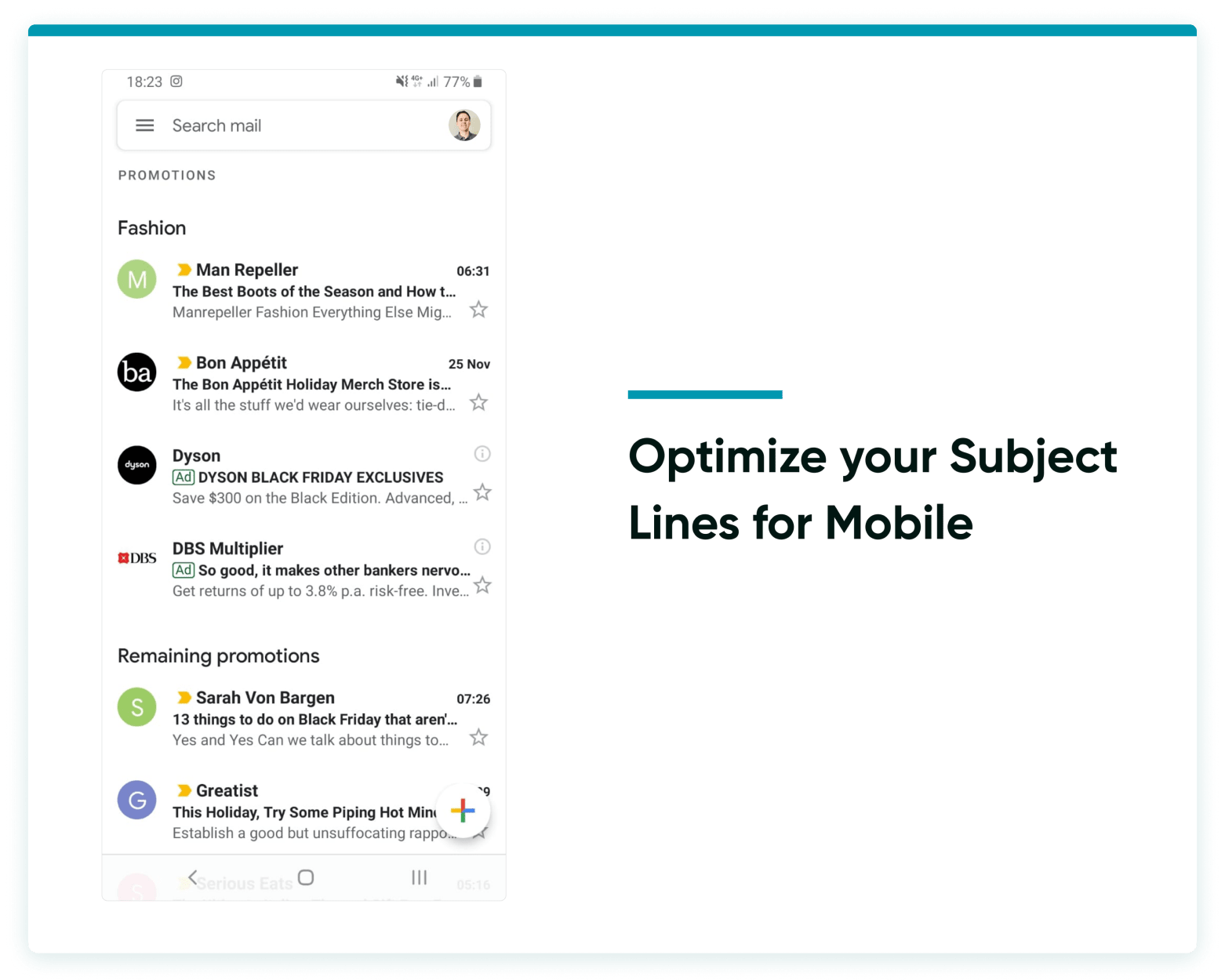
If you don’t want to go through the hassle of customizing your subject line for different email platforms, just aim to get your subject line as short as possible.
Use a casual tone
For some folks, using a casual tone on cold emails may feel counter-intuitive. But if you want your subject line to stand out amongst an avalanche of sales emails, you’ve got to switch it up, and humanize your emails.
More specifically, I recommend using the same tone you would when communicating with a close friend. You want to be warm, informal, and perhaps even humorous.
If your company isn’t too strict on brand guidelines and allows you to experiment, try sending out cold emails with subject lines that are exclusively in lowercase. Some marketers also like to use emojis to spice up their emails.
Here’s how CoSchedule combines these two techniques (lowercase and emojis) to come up with a casual, human-sounding subject line that resonates with their audience:
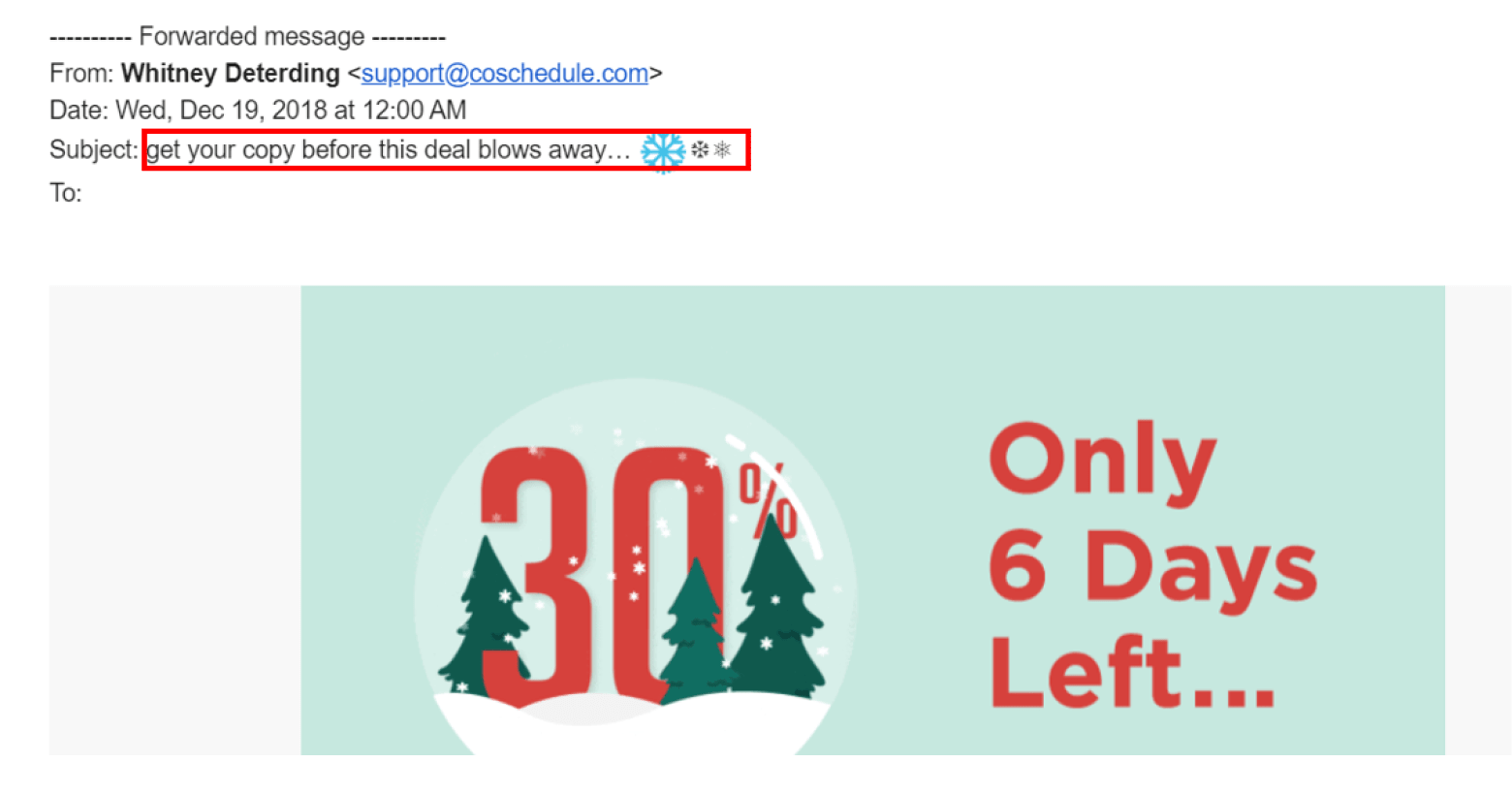
Reference deals in subject lines
Offering deals or discounts within your email? Don’t hide them – make them your headline. There’s nothing like a monetary incentive to trigger an open.
To add an element of urgency, also share the timeframe in which your deal is available, like how Cogsworth does here:
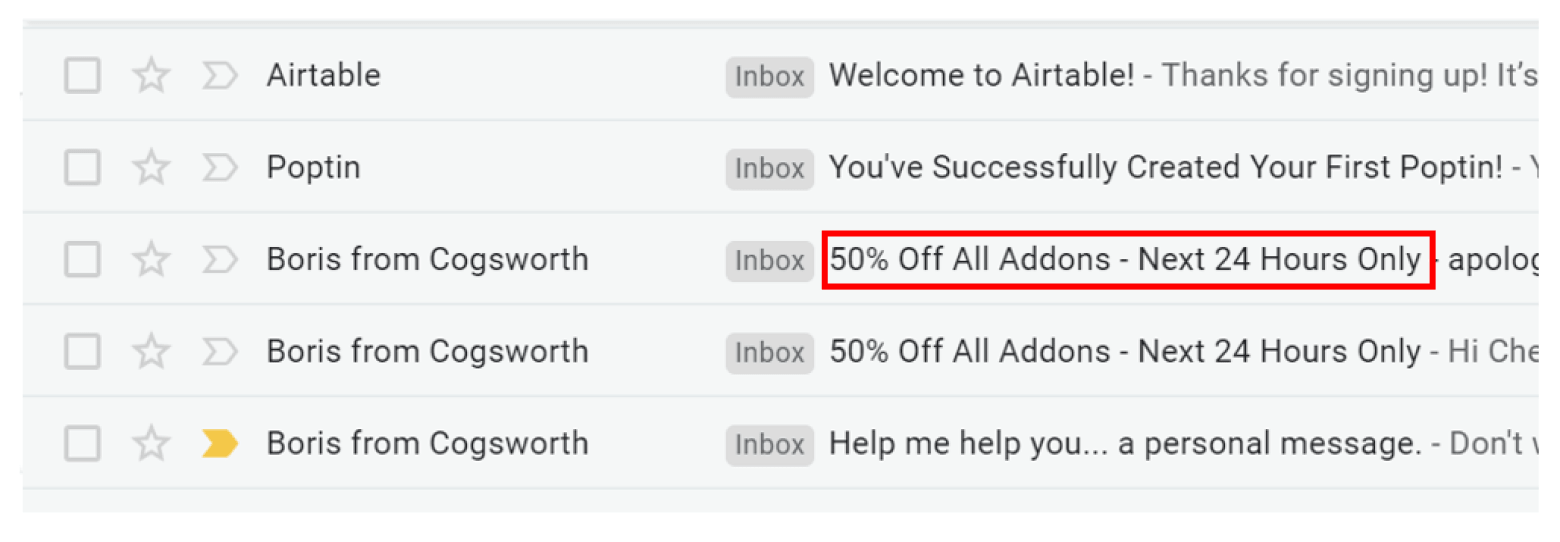
60% of millennials say that they make a purchase after experiencing FOMO, most often within 24 hours – which is why this tactic is great for boosting conversion rates.
A word of warning: while this is a powerful tactic that can help you improve your email metrics, it can easily backfire on you as well.
More specifically, if you frame your deal or offer in a misleading way, or you’re less than honest to your prospects, these prospects will catch on. When this happens, they’ll no longer trust you and your company, and you can kiss your chances of closing a deal goodbye. So always be honest and upfront!
Personalize subject lines
The numbers don’t lie: personalizing your subject lines can boost open rates by up to 50%.
This is fairly straightforward: you just use your prospect’s name in the cold email that you send to them…
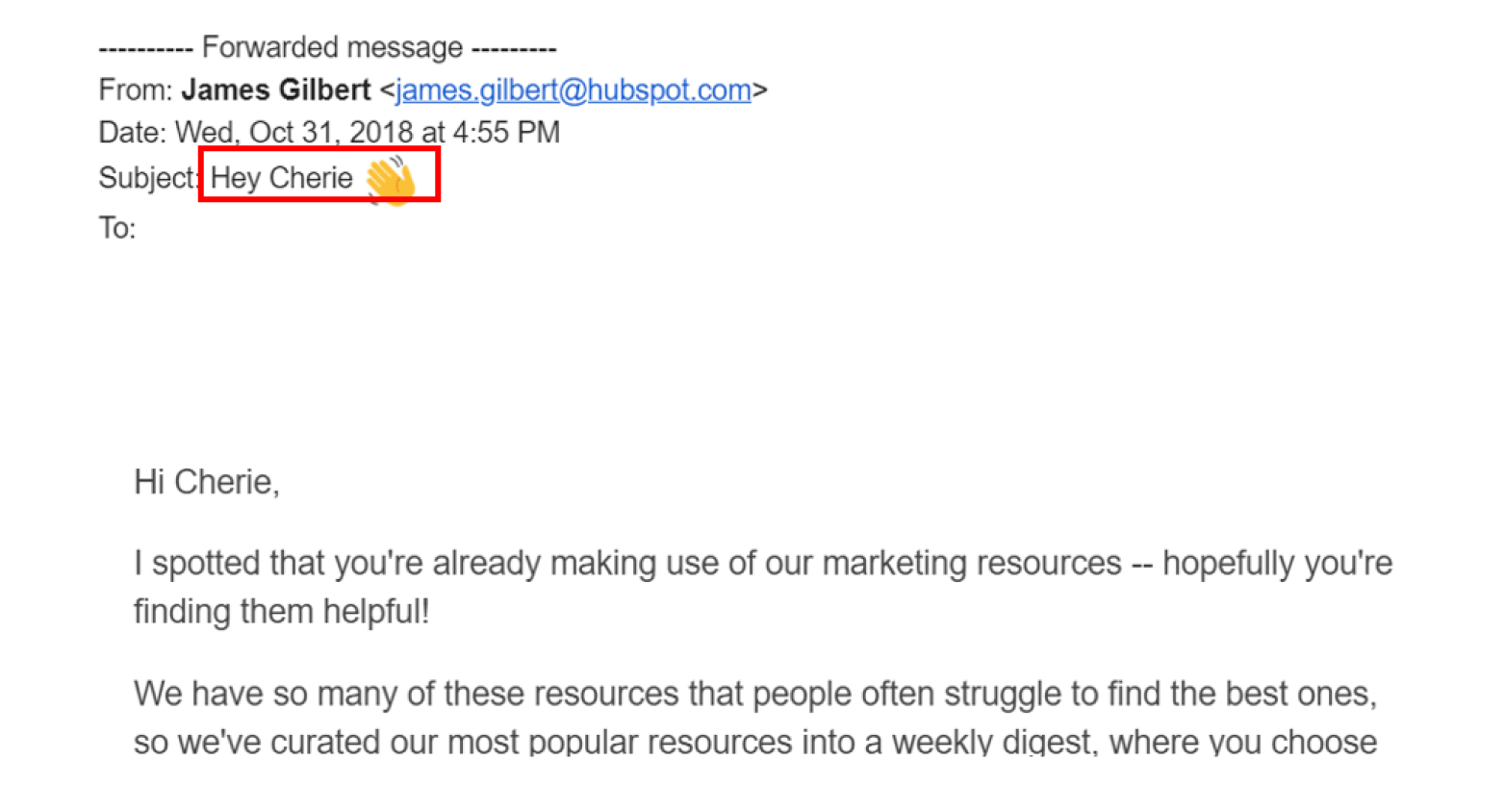
This is a low-hanging fruit that you should definitely tap on: it should be easy enough to set this up, regardless of what email marketing platform you’re using, and emails that include the first name of the recipient in the subject line have a higher click-through rate than those that don’t.
For more on personalization, skip ahead to Chapter 9: Personalizing Your Cold Emails.
A/B test subject lines
Finally, don’t take everything you read online (including this article!) as the gospel truth. Every brand’s audience is different – so certain types of subject lines might work for another company, but might generate poor results for you. To determine if a particular best practice or tactic works for you, go ahead and A/B test your subject lines.
For example, if you’re thinking about including emoji in your subject line, test two subject lines – one with an emoji and one without. Alternatively, write a humorous subject line and test it alongside a more straight-laced version.
Many email marketing tools have native A/B testing functionality. Otherwise, you can do a “pre-post test” by creating a spreadsheet to track the metrics generated by each version of the subject line. At the end of a set period of time, look at which triggered the most opens, click-throughs, or replies, and there you have your answer. Adapt and repeat.
For more on A/B testing, skip ahead to Chapter 15: A/B Testing to Improve Your Campaigns.
Over to you! Here’s how you craft engaging and effective subject lines:
- to you! Here’s how you craft engaging and effective subject lines:
- Keep subject lines short. Use <27 characters, if you can manage it.
- Use a casual tone. Consider using lowercase text and emojis to further humanize your tone.
- Reference deals in subject lines to add urgency.
- Personalize subject lines by adding your prospect’s name (or their company name, or other details).
- A/B test subject lines to improve your subject lines over time.
Mastering Cold Email Intro Lines
Guillaume @ lemlist
Alex Berman @ X27 marketing:
If you’re sending out a cold email, and you utilize that standard intro line – “I’m FirstName from CompanyName, and we produce a tool that does X, Y and Z” – that will guarantee you a quick send-off to the trash folder.
So, how can you write intro lines that are sophisticated and compelling enough to capture your prospects’ attention? Here’s a step-by-step guide:
Keep tabs on cold emails sent by other companies
Don’t jump right into brainstorming and coming up with intro lines for your own cold email campaigns. Instead, survey the market to see what kind of intro lines other companies (especially your competitors!) are using, and learn from them. When you chance upon a cold email that you like, save it in your inbox.
When you’ve got a bunch of these emails, sit down to dissect them and figure out what makes them so effective.
Know your prospect like the back of your hand
Next, do your due diligence so that you understand your prospects well. Make sure you’re well-informed about what they like, how they speak, what they’re about, and the challenges they’re facing. All this information gives you context.
Craft your intro lines
Finally, start coming up with a few intro lines that you can use in your cold email campaign. If you’d like some inspiration, the approach that we take at X27 Marketing is to go to our prospect’s LinkedIn profile and find something we can use to connect.
This could be a new promotion, a recent project they’ve pulled off, a conference they’ve attended, etc. Whatever it is, that becomes the first line of our cold email.
For instance, let’s say you want to reach out to a prospect from Apple, and you see that they, like you, went to Social Media Marketing World (a marketing conference!) last year. You might approach them with this intro line:
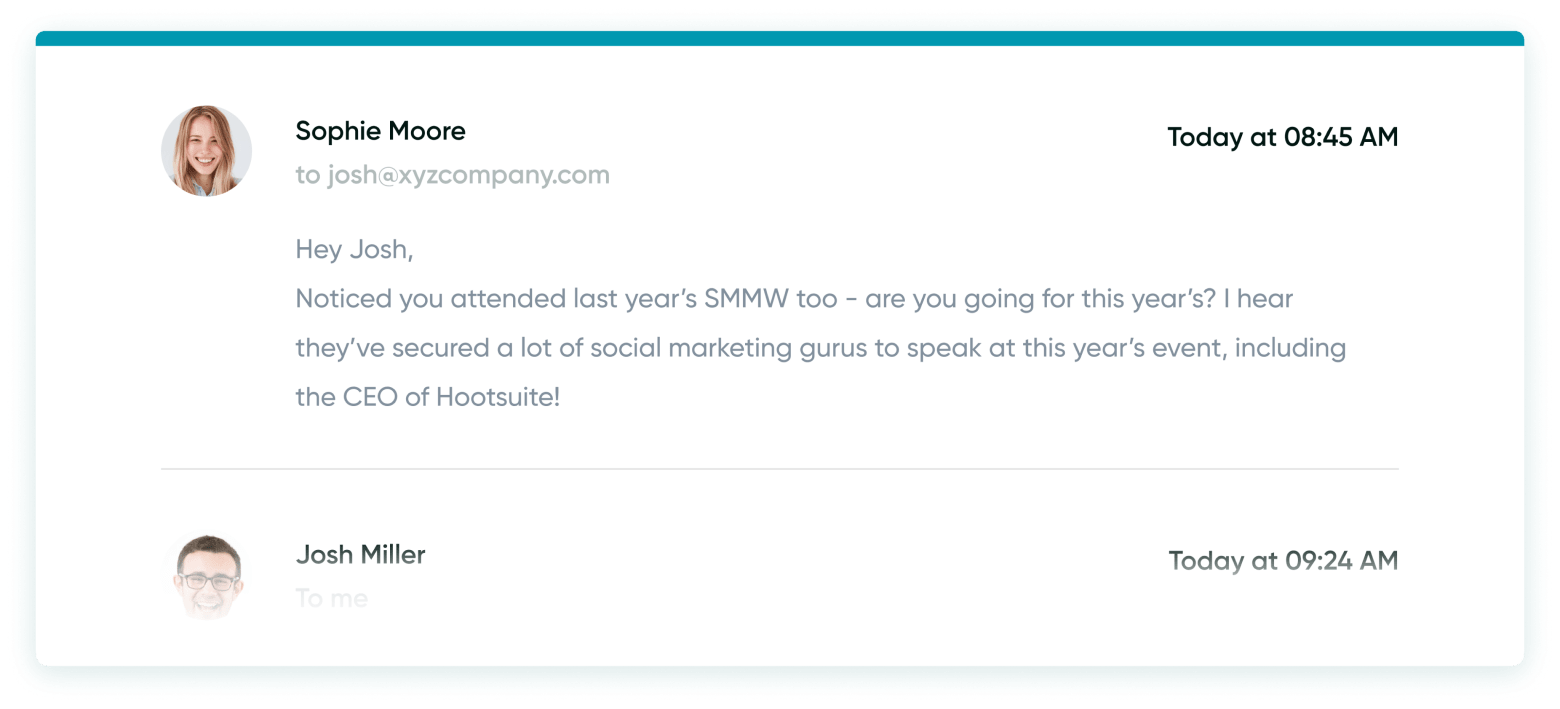
Many elements of the REPLY method also come into play here, namely Empathy, Personalization, Laser-Focus, and You.
Firstly, you want to be empathetic and talk to your prospect like they’re a friend of yours. Get on the same wavelength as your prospect, so you can relate to them (and vice-versa), and make the conversation about your prospect rather than about you.
Next, personalization is key when you’re crafting cold email intro lines. At x27, we made the call to customize the first line of every cold email we sent out, increasing our open rate by a whopping 10x to 15x.
Last but not least, be focused with your intro line! Don’t ramble on and on – just get to the point, and then move on. Long chunks of text will put off your prospects and reduce the chances of them reading your entire email.
Over to you! Here’s a quick recap of how you can master those cold email intro lines:
- Survey the market to see what intro lines other companies use in their cold emails.
- Save any cold emails with great intro lines, and dissect those intro lines to figure out what it is that makes them work.
- Do your homework and get to know your prospect well.
- Craft your cold intro lines, making sure they’re empathetic, personalized, focused on your prospect, and not too rambly.
Personalizing Your Cold Email
Santosh Sharan @ LeadGenius
Personalization has always been important, but it’s all the more so in this digital era. Your prospects’ attention spans are growing increasingly short, yet they keep getting bombarded by a growing pile of promotions and emails – something has to give.
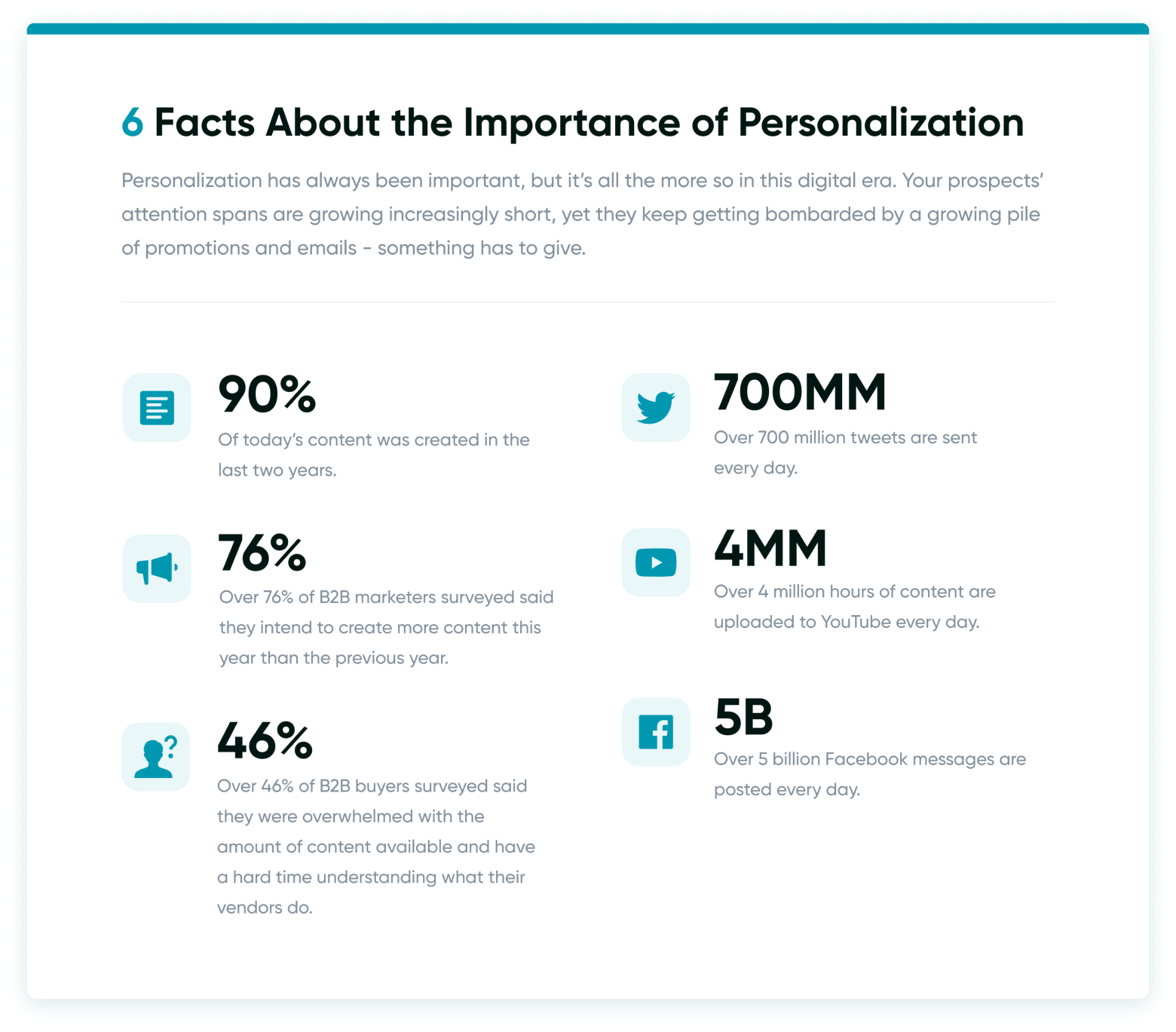
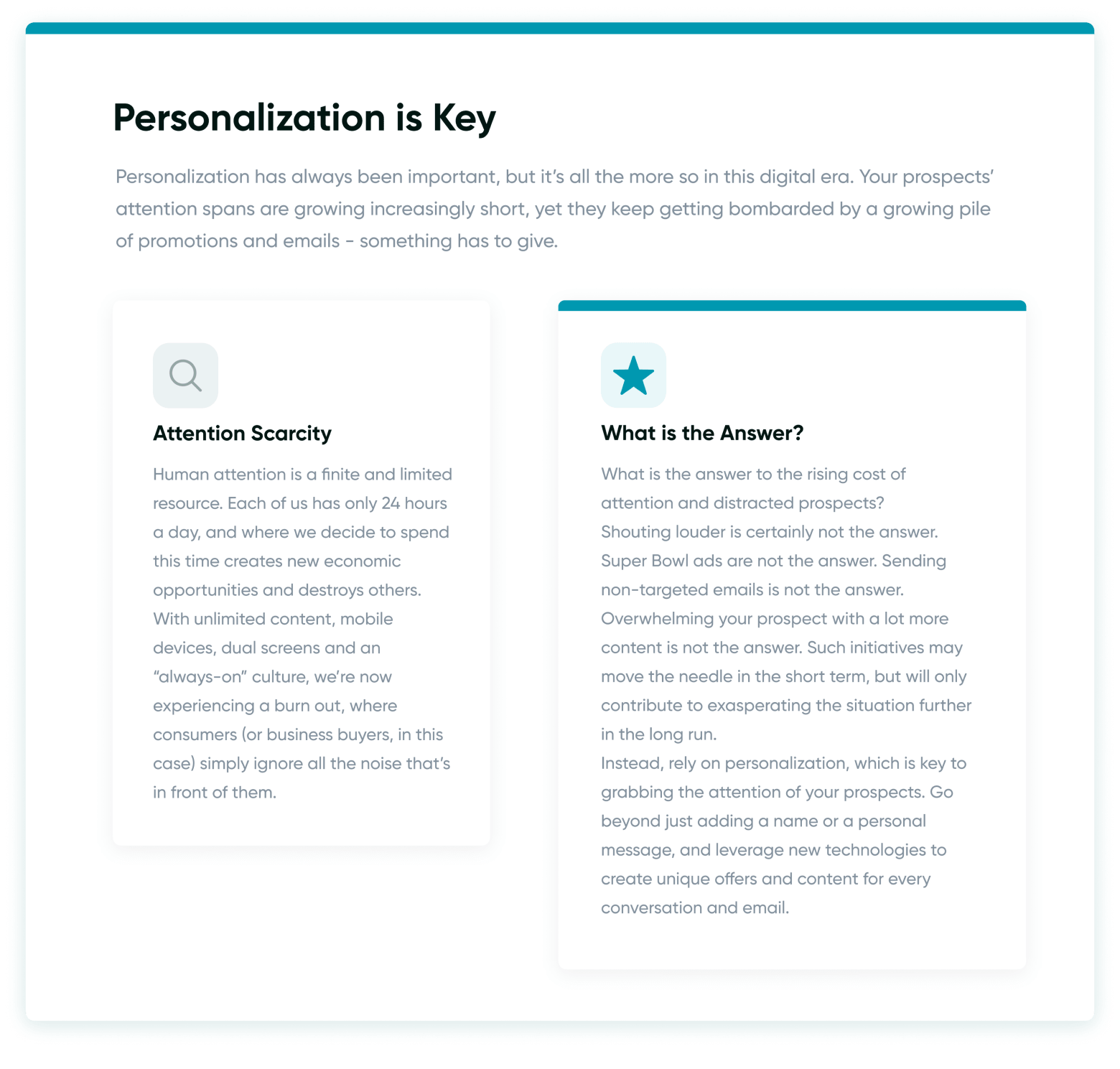
Lee Gladish @ Airborneapp
One of the biggest complaints about cold email is that it seems so… cold. However, the good news is it doesn’t have to be this way.
If you want to send emails that get enthusiastic responses, the most effective method is personalization. Just as a tailored suit is worth more than one purchased off-the-rack, a truly personalized email is worth a thousand carbon copy emails.
At the most basic level, you can personalize an email by referencing details that are unique to your prospects, such as their name, their job title, and the company they work for. For example, instead of sending the following email…
Dear Sir/Madam,
You may be interested in our new product
You could personalize the same message with their details:
Hi Brad,
As the Office Manager at Acme Solutions, you may be interested in our new product…
However, even though this personalization is an improvement, this still isn’t a great cold email. Using a prospect’s first name may have been enough to get someone’s attention a few years ago, but this has become exceedingly common today and less effective as a result. As email marketers, we need to step up our game.
There are many ways to do this, including personalizing based on recent activity. For instance:
“I loved your post on {post topic}. Super insightful!”
A word of warning: while this acts as proof that you’ve done some research, it can easily come off as insincere, which will do you more harm than good. If you do want to personalize your email based on a prospect’s online content, here are some tips to keep in mind:
#1: Reference something recent and relevant
Complimenting their post on the state of the industry, published last week = good. Complimenting personal vacation snaps from five years ago = bad (and creepy).
#2: Engage with and share their content before you email them
Actively engaging with their content will make your compliment more sincere, as well as making your email less cold.
#3: Share your personal takeaway from their content
By including your favorite part of their content and how it’s changed your perspective, you’re showing that you’ve engaged with their post in a meaningful way.
#4: Look at company changes (on tozp of blog posts and social media activity)
When you’re looking for recent activity, don’t limit it to blog posts and social media activity. While compliments can be nice, focusing on recent company changes can bring better results, especially if it’s relevant to the product/service you’re offering.
For example, if you see the prospect’s company has just relocated, that will be on their mind, making it an ideal topic for personalization.
Guillaume @ lemlist
Now that you have a rough idea of how to go about personalizing your emails, let’s take a deep dive into the five levels of personalization you can apply to your campaigns.
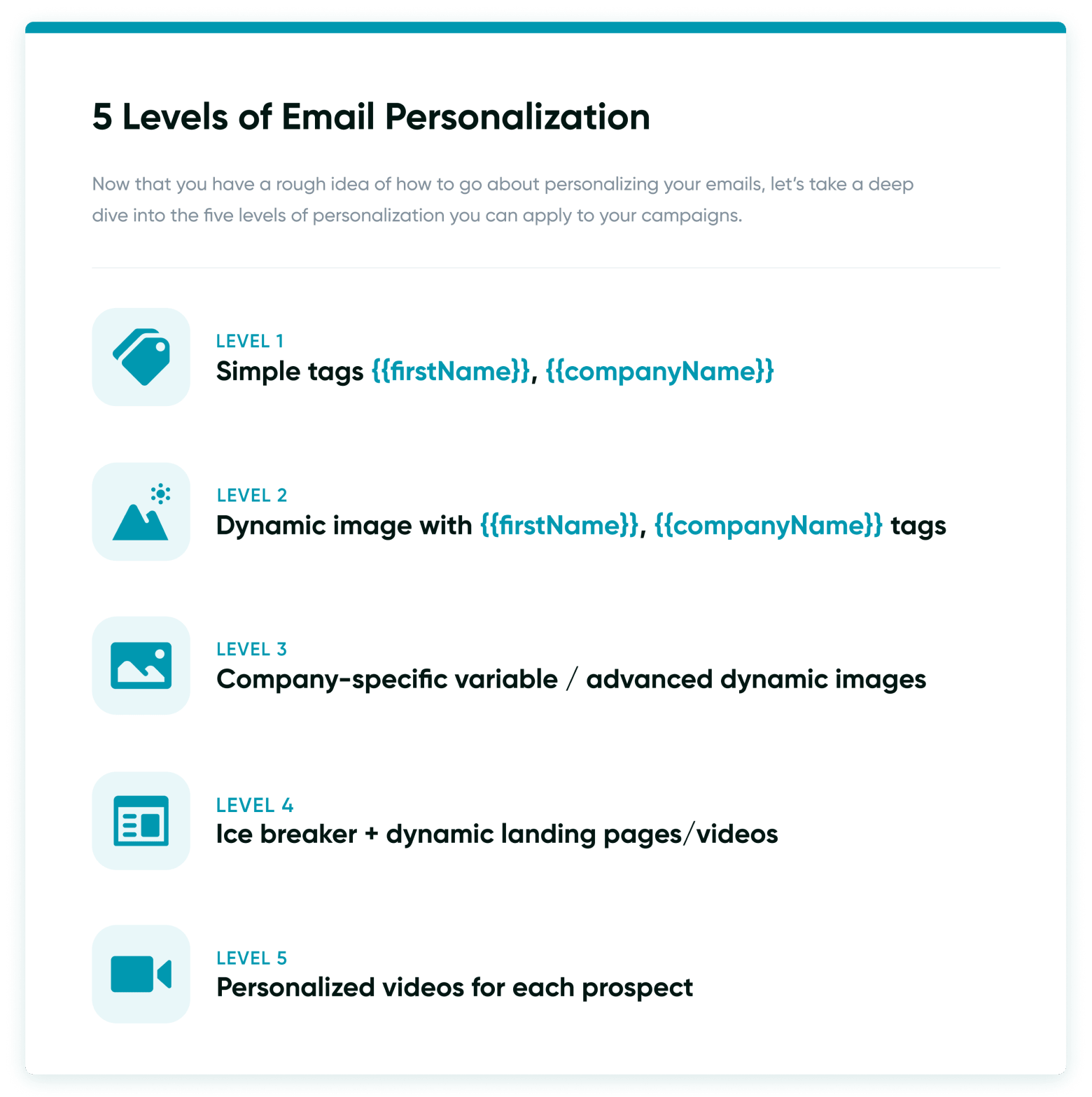
Here’s some context: some time back, our team at lemlist conducted a study where we analyzed 50 million cold emails sent to 10,000+ users all over the world.
In this study, we categorized the cold emails according to the five personalization levels you see above and identified some interesting insights that we’ll share with you in this section. Let’s jump right in!
Level 1: Using {{firstName}} and {{companyName}} tags
As you probably know, most folks doing cold emailing use these simple personalization tricks. Unfortunately, they don’t work that well anymore.
Here’s a classic example:

Personally, I don’t recommend this approach if you’re serious about cold emailing. You’ll get poor results, and end up wasting your time.
Level 2: Dynamic image with tags
With this level of personalization, you include a personalized image, which helps to humanize your email and pique your prospect’s interest. Check it out:
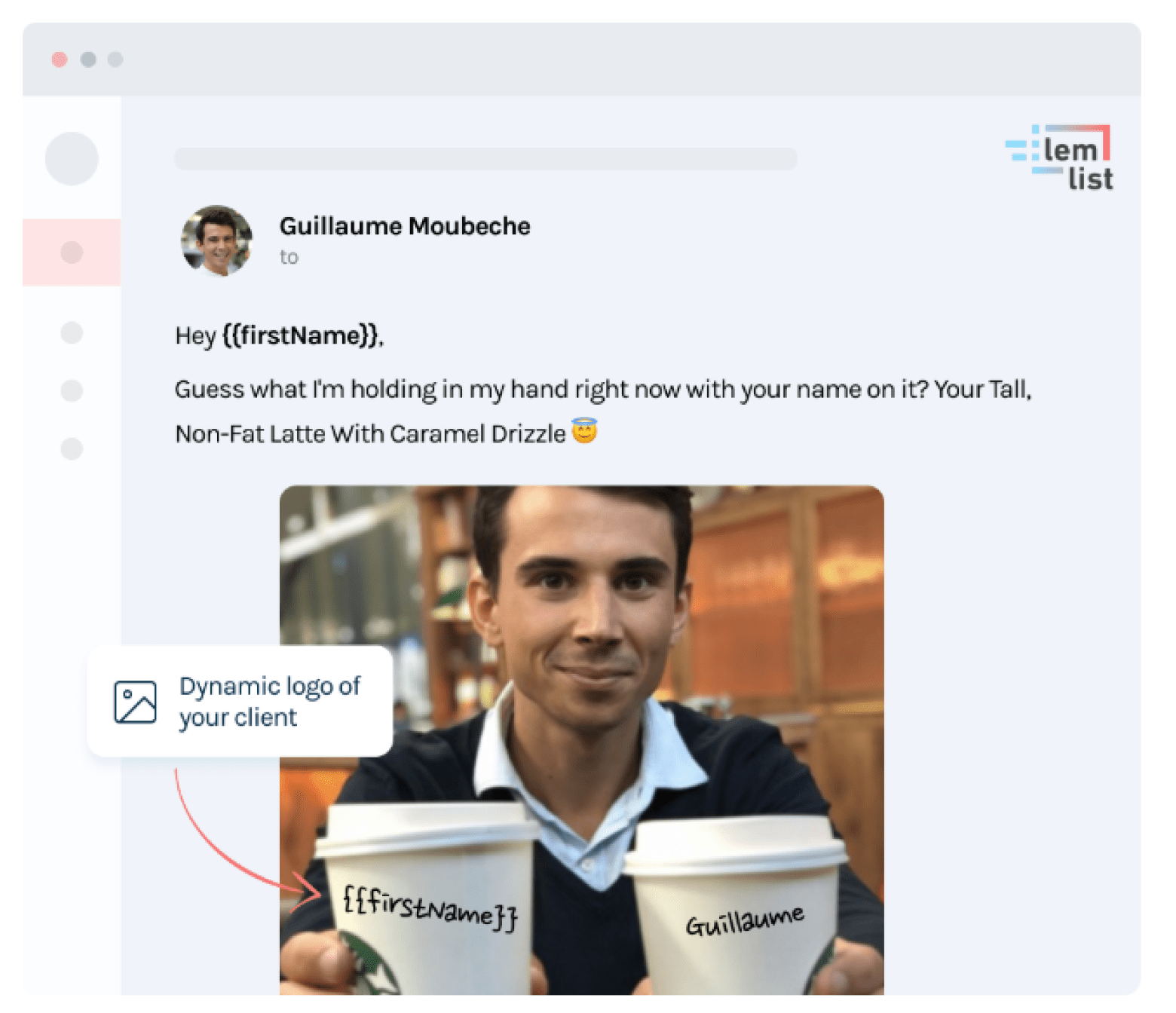
Level 3: Company-specific variables / advanced dynamic images
If you’re targeting larger enterprise accounts, you will have to reach out to several decision-makers within the same company. These decision-makers are often busy folks who don’t have time for cold emails, so it’s all the more important for you to personalize your outreach and make it highly relevant to them.
I recommend you do this by adding company-specific variables into your email, and using advanced dynamic images. Here’s an example:
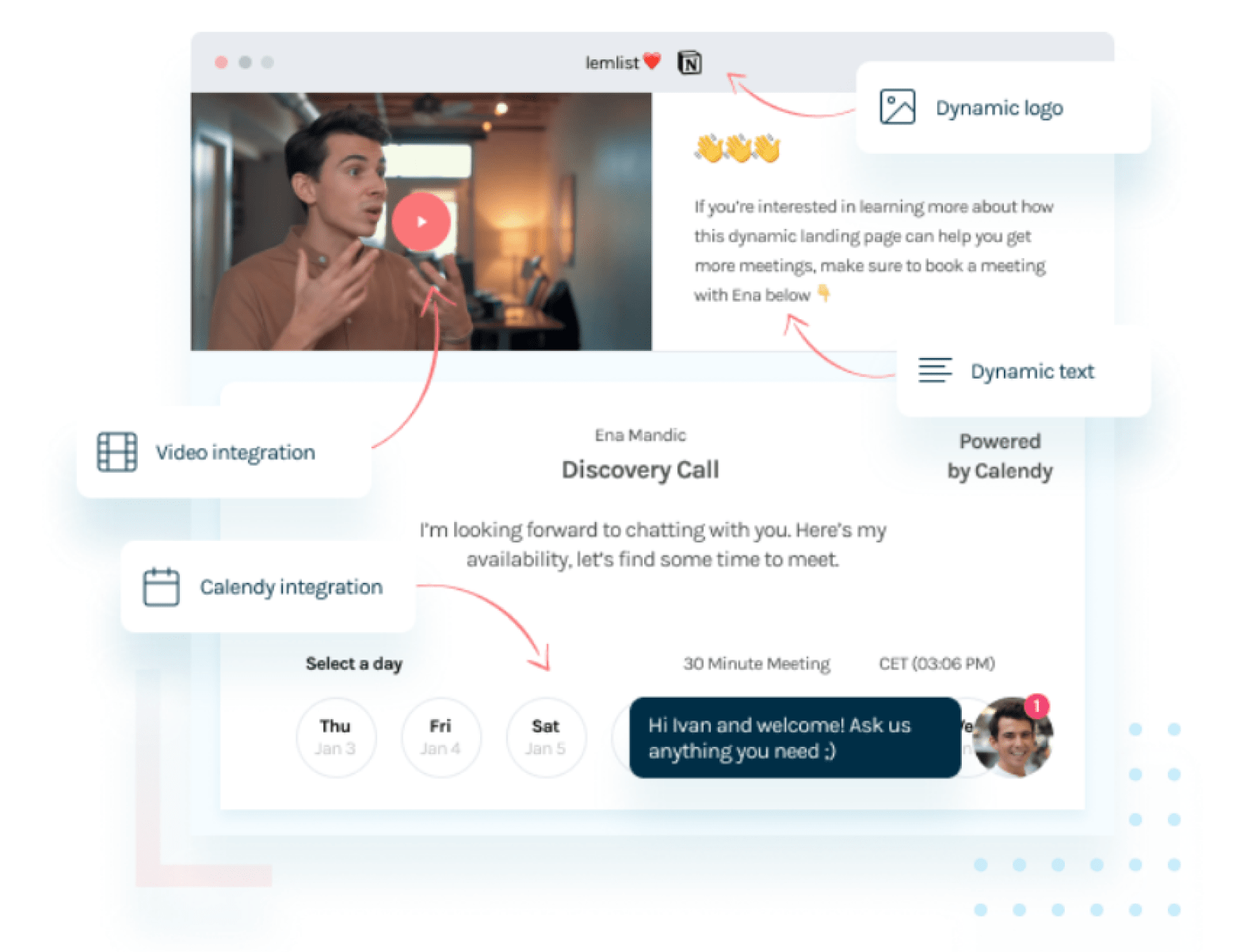
Level 4: Ice breaker + dynamic landing pages/videos
If you really want to impress, use a combination of an icebreaker and dynamic landing page/video. Your ice breaker is essentially dynamic text that’s customized to each prospect you’re reaching out to, and your dynamic landing page should contain whatever you need to “hook” your prospect.

Note that the dynamic text in the screenshot above (“If you’re interested in learning more about how…”) contains placeholder text, and should be personalized to your prospect.
Level 5: Personalized videos for each prospect
For those who want to go all out with their cold email campaign, I recommend going with personalized videos.
Obviously, these take a lot more time and effort to create (as compared to inserting a simple {{firstName}} tag and calling it a day). That said, this may also work out to your favor:
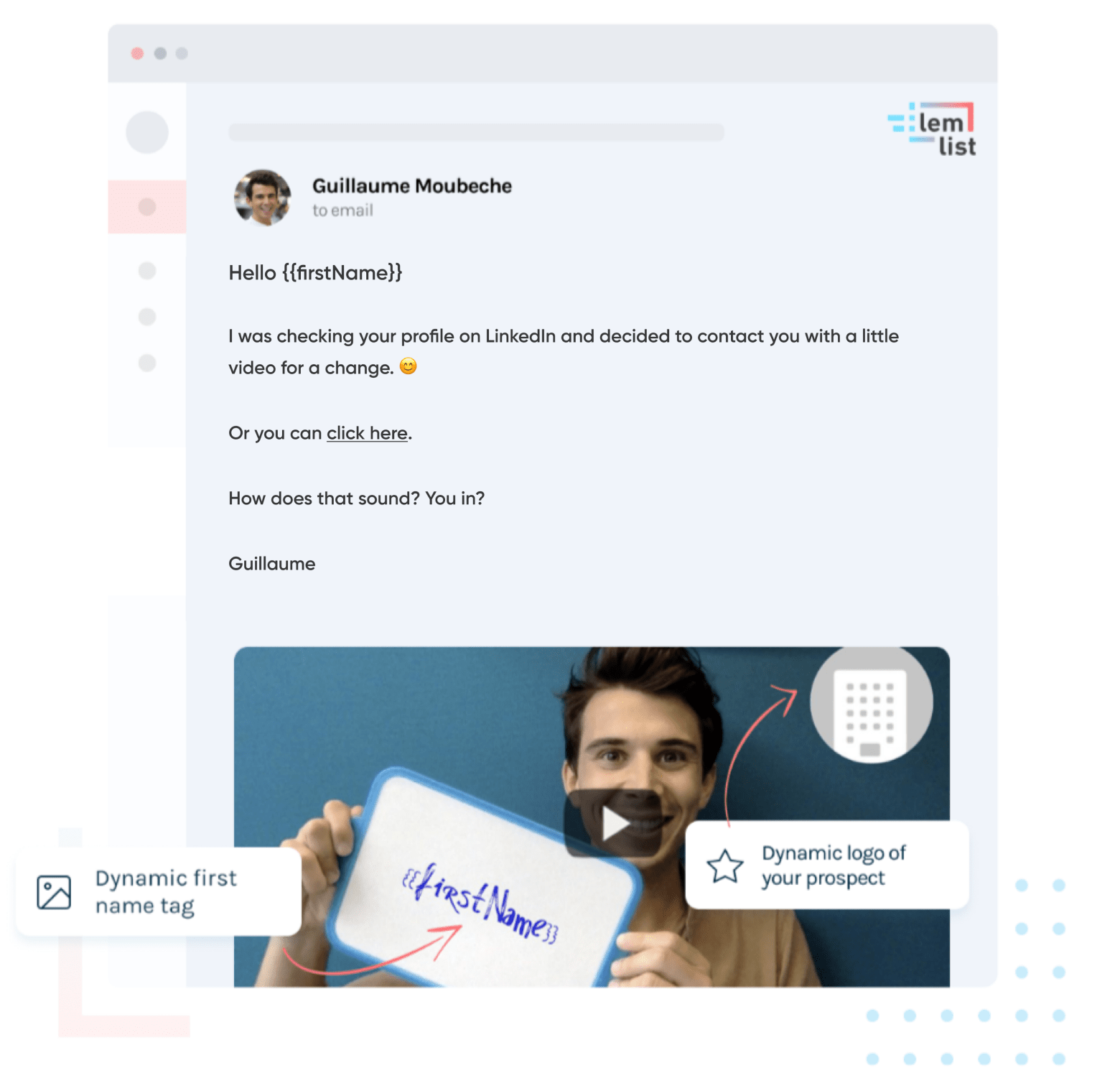
Now that you’re up to speed on the five levels of personalization, here’s the next question: how do you decide which level to use? Should you always aim to hit level five?
As a general rule of thumb, always adapt your level of personalization to the potential ROI that you can get from your prospect. At lemlist, we like to split our prospects into what we call “tiers”:
1. Tier 1: Most valuable customers who bring in the most revenue.
2. Tier 2: Customers with medium-sized accounts.
3. Tier 3: Customers with low lifetime value
From here, it’ll be easy for you to craft your email strategy (and decide how far you want to go with personalization). For tier 1 customers, go ahead and pull out all the stops – they’re worth the time and energy you spent on creating personalized videos and landing pages.
For tier 2 customers, you’ll still want to put effort into personalization, but it’s not necessary to go the extra mile. Finally, for tier 3 customers, it makes sense to rely largely on automation, so that you can allocate more time to high-value prospects.
Over to you! Here’s how you can personalize your cold emails more effectively:
- Understand that in this day and age, personalization is no longer a “nice-to-have”. It’s now a “must-have”.
- Split your prospects into tiers, based on how much ROI they can potentially bring you.
- Decide on which level of personalization you want to invest in with each tier.
- Create your personalized videos and landing pages (if any). Try Instapage to build landing pages, and Loom and Vidyard for producing videos.
- Set up your email campaigns and start sending out those cold emails!
Improving Your Email Deliverability
Guillaume @ lemlist
Wojciech @ Woodpecker.co
For the uninitiated, email deliverability refers to the ability of an email to land into your prospect’s inbox. Generally, the higher your email deliverability, the more email opens you get. After all, if your email never makes it to your prospect’s inbox, there’s no way they can open it!
If you’re wondering what’s the average email deliverability rate, this actually differs across the globe. This infographic says it all:
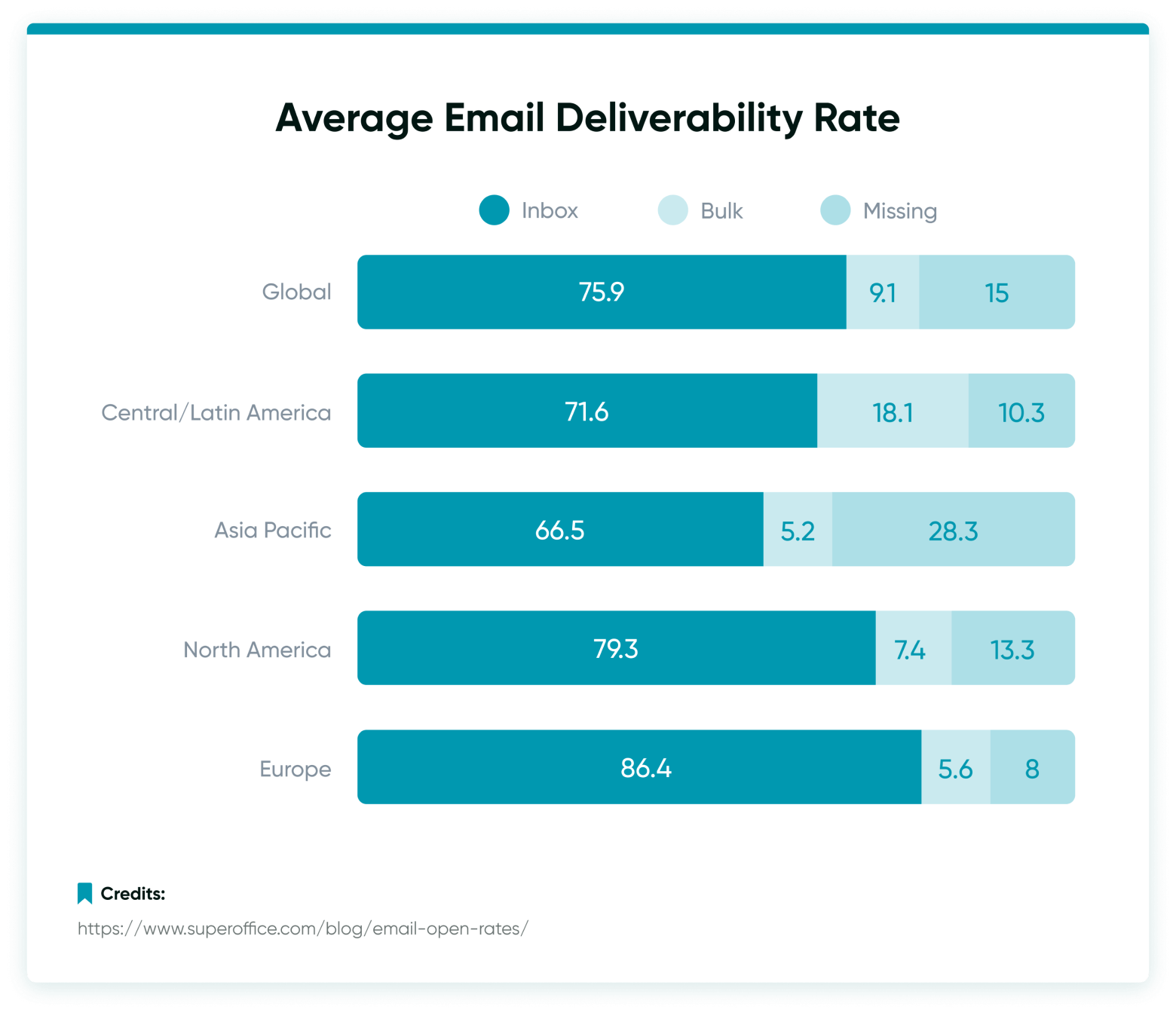
Regardless of whether your current deliverability is higher or lower than your region’s average, it’s good practice to keep optimizing for deliverability, so that you can improve the effectiveness of your cold email campaigns. Here are the seven key pillars that impact deliverability:
- Tech setup
- Domain warmth
- Bounce rate and complaint rate
- Volume and consistency
- Email copy
- HTML
- Spam test
Read on to learn what you can do to improve deliverability in the context of each pillar.
Tech Setup
Where your tech setup is concerned, the first thing to do is to set up SPF, DKIM and DMARC.
Think of SPF and DKIM as ID cards for an online domain – they tell email servers that a specific email address is associated with a specific domain, and let email servers know you’re a real person
Sender Policy Framework (SPF) and DomainKeys Identified Mail (DKIM) are email authentication methods designed to detect forging sender addresses during the delivery of the email. SPF uses path-based authentication while DKIM uses an identity-based authentication.
Setting up SPF
When you set up SPF, this ensures that all applications that send emails on your behalf are included in your SPF. First, you’ll have to check your current SPF using Google Apps Toolbox.
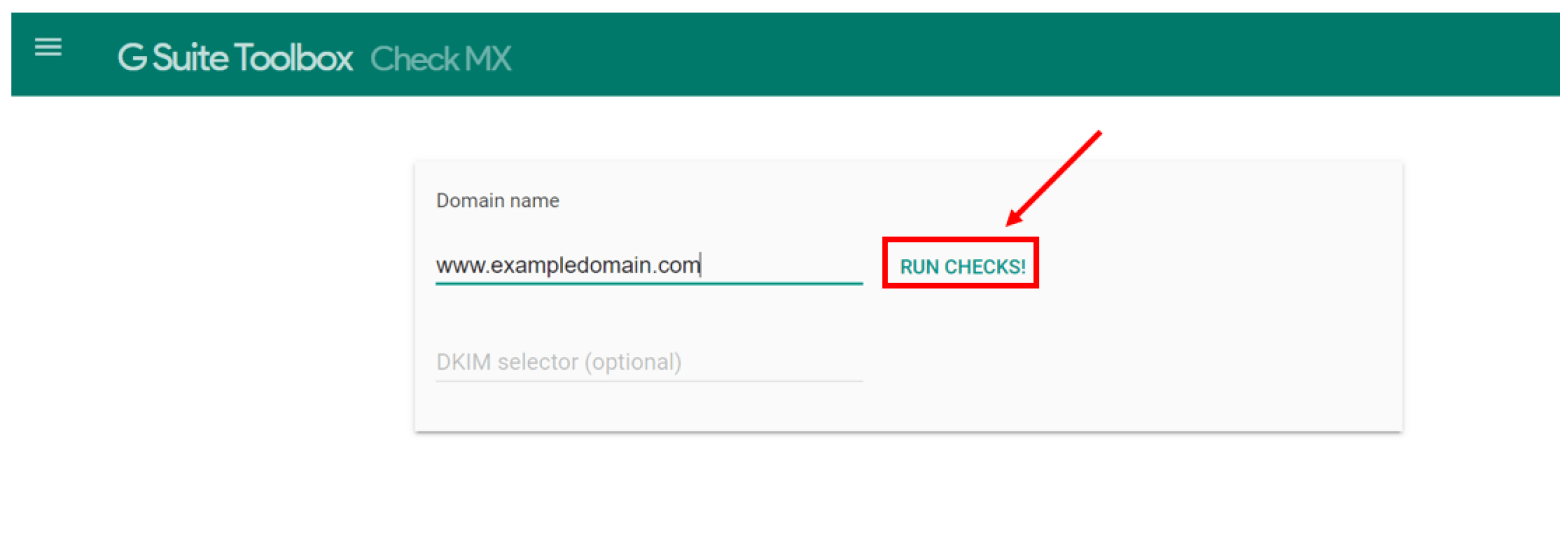
Setting up SPF ensures that all applications that send emails on your behalf are included in your SPF. First, you’ll have to check your current SPF using Google Apps Toolbox.
Assuming that your SPF isn’t set up yet, you’ll need to go to the administrative console of your domain and add in a specific line of text. The instructions on how to do this differs based on which domain host you’re using, so I’ve compiled a list of the most common domain hosts and how to set up SPF using these hosts below:
Setting up DKIM
To set up DKIM, you use a private key to encrypt the header in all outgoing emails that are sent from your domain. You’ll then generate a public key and place this within your domain’s DNS records. Using the public key, these servers can then verify that your emails are coming from you, instead of a third-party that’s spoofing your domain.
Again, how you should set up DKIM is dependent on which domain host you’re using:
SPF and DKIM aside, there’s also DMARC, which is a protocol that uses SPF and DKIM to determine whether an email message is authentic. When you set up DMARC, unauthenticated individuals will not be able to send emails from your domain. By viewing your DMARC reports, you can also identify who is sending mail from your domain, and ensure that your domain is not being misused.
DMARC stands for “Domain-based Message Authentication, Reporting & Conformance.” Today, all major Internet Service Providers (ISPs) do a DMARC check before accepting an incoming message or email, in order to identify if the sender’s domain name is consistent with the details listed under the “From:” header in their email.
To learn how to set up DMARC, follow this guide by MXToolbox.
If this all sounds like Greek to you, don’t worry! You can always forward this guide to your IT person, and get them to assist you with setup.
Domain warmth
What’s the difference between a warm and cold domain? Simply put, a warm domain is an established domain from which emails have been sent for quite some time. A cold domain is a brand new domain from which no email has been sent yet. Ideally, you should always warm up your domain before kicking off your official cold email campaign.
Why is this the case? When you set up a new domain, this starts off as a cold domain by default. Because there’s no sending history tagged to your account, your domain host doesn’t know whether you’re a spammer. As a result, if you start sending large volumes of emails right off the bat, your domain host is likely to block you.
When planning out the details of your cold email campaign, make sure to add two to three months to your timeline to account for your domain warming. Here’s a step-by-step guide on how to warm up your domain:
Step 1: Send out a few emails every day
First, make a list of people that you can email to warm up your domain. Note that you should not be sending any cold emails here – instead, you want to send messages to email addresses that you know already exist.
For instance, you might email your existing customers to check in on them, or reach out to your business partners to make sure everything’s going well. You can also use an email warm-up service to warm up your inbox automatically. (some of them are free). By doing this, you’ll experience 100% deliverability with the first few emails that you send from your inbox, which helps you build up your sender reputation.
Step 2: Use conversational language in your emails
In previous chapters, we talked about how humanizing your tone will make your prospects more receptive of your cold email. That aside, doing this also makes you seem more legitimate in the eyes of your domain host.
To do this, simply write in a conversational tone, like how you’d address a friend.
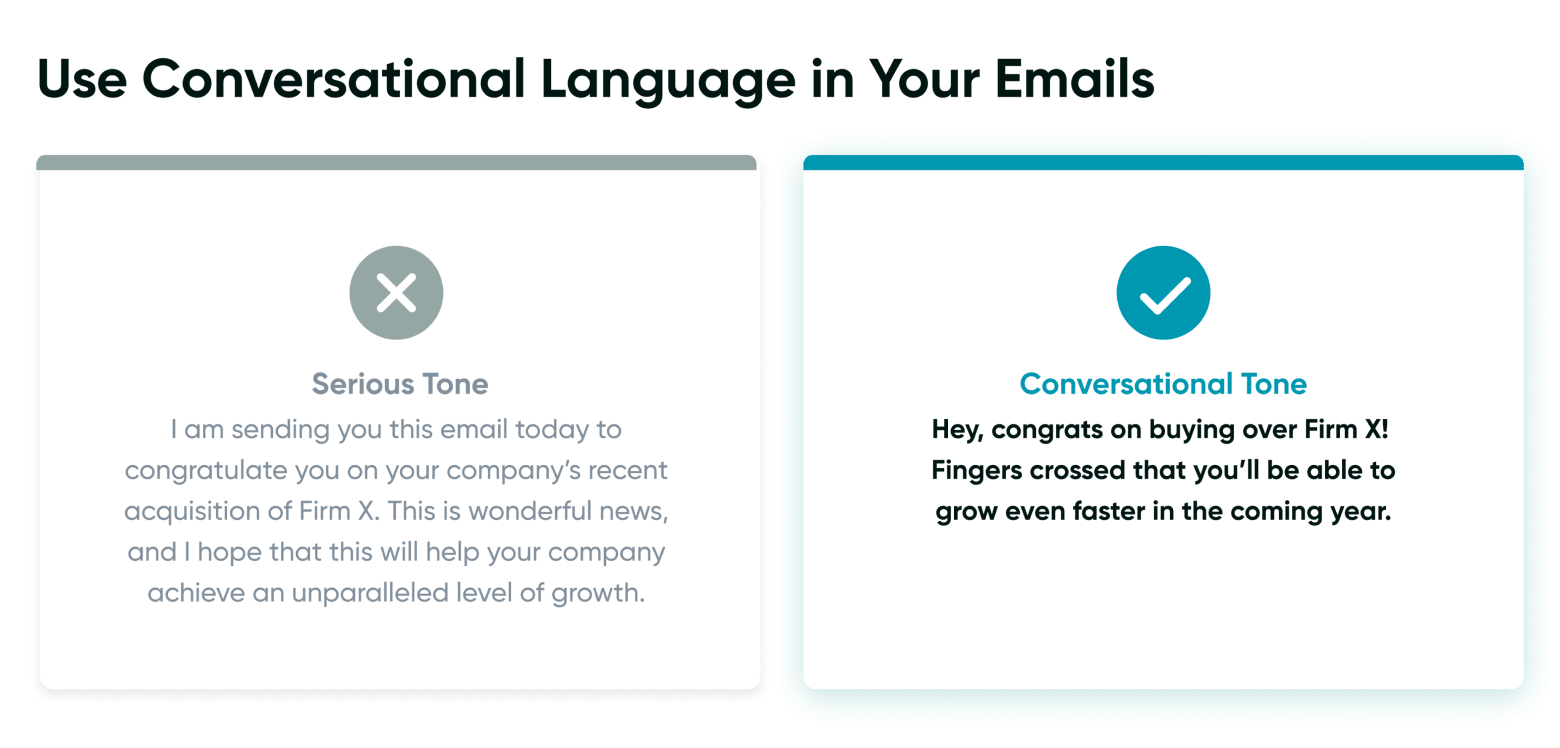
Step 3: Send and receive replies to build your email threads
To encourage the people you’ve emailed to reply to you, end your email by asking them a question or asking for their feedback or something. Once you’ve sent out a couple of emails from your inbox, continue communicating with the initial people you emailed and build your email threads.
Remember, a typical mailbox isn’t just used to send emails – it should also receive emails and send replies to the emails that it receives.
Bounce rate and complaint rate
We’ve discussed email bounces and bounce rates in detail, so we won’t be dwelling too much on this. That aside, your complaint rate also tells you how many people are actively moving your emails into the spam folder.
Now, what’s tricky is that there aren’t any tools that businesses can use to measure their complaint rate. The only thing you can do is to use MXToolbox and similar software to see whether or not you’ve been blacklisted. Bearing this in mind, it’s all the more important for you to segment your email list properly and personalize your emails in your cold email campaign.
Volume consistency
Ideally, you should be sending a consistent volume of emails on a day-to-day basis. If you send 10 emails a day and 500 emails the next, this may hurt your deliverability score.
Also consider the timing of your emails – if you want to send 200 emails within one day, you should space out your emails and send out a smaller batch every few hours. Sending out all 200 emails at the exact same time will, again, make your account look suspicious.
Email copy
If your email consists of many words commonly found in spam emails, then it might trigger your prospect’s spam filter. When this happens, your email will either fail to be delivered, or it’ll land in your prospect’s spam folder. Here’s a chart of common trigger words to avoid:
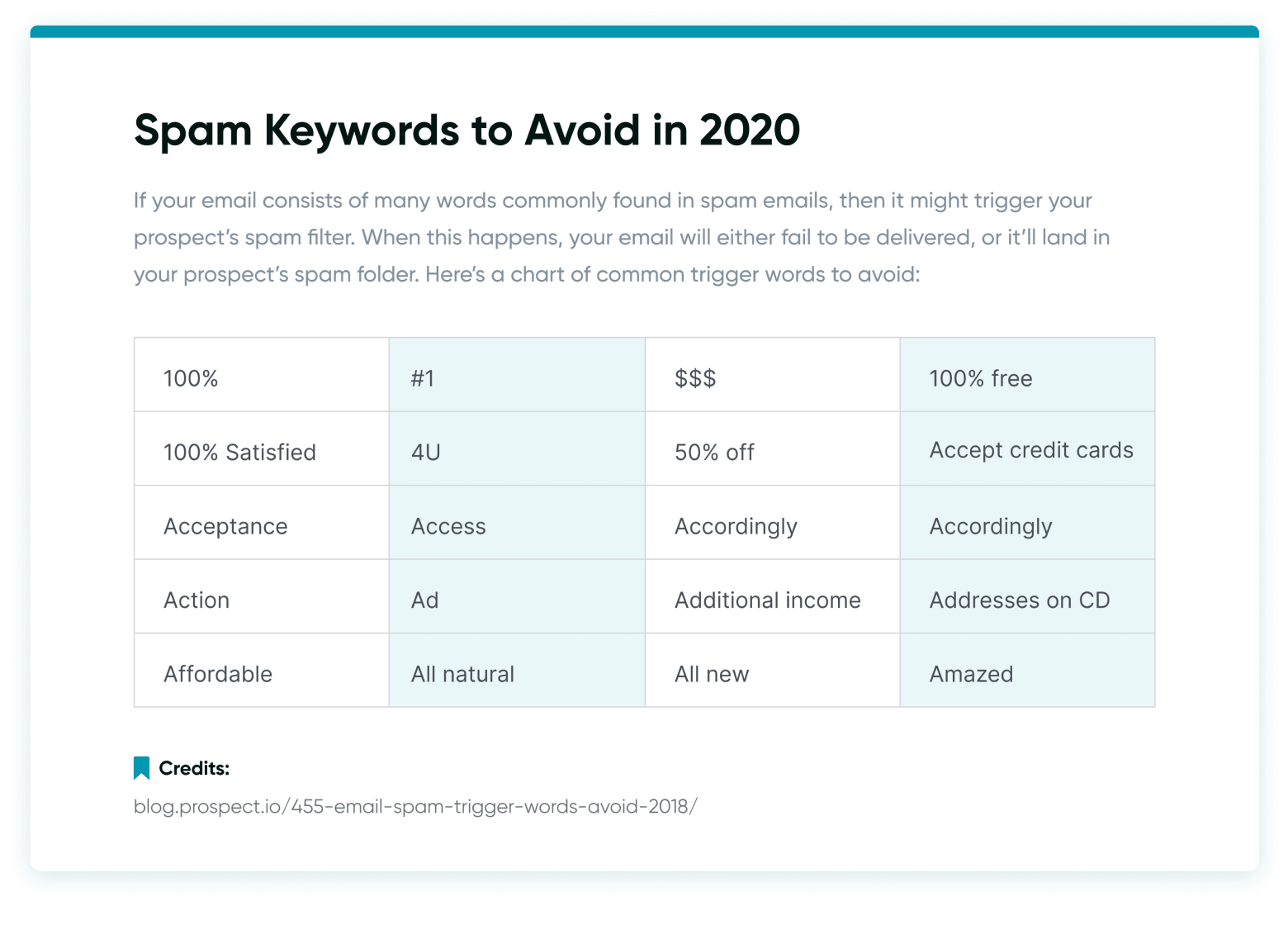
Download a Full List of Spam Keywords To Avoid Here
HTML
Email copy aside, the usage of HTML in your emails (to be specific, the usage of excessive HTML) also affects email deliverability. This means you don’t want to have your entire email consist of a single graphic, with no text:
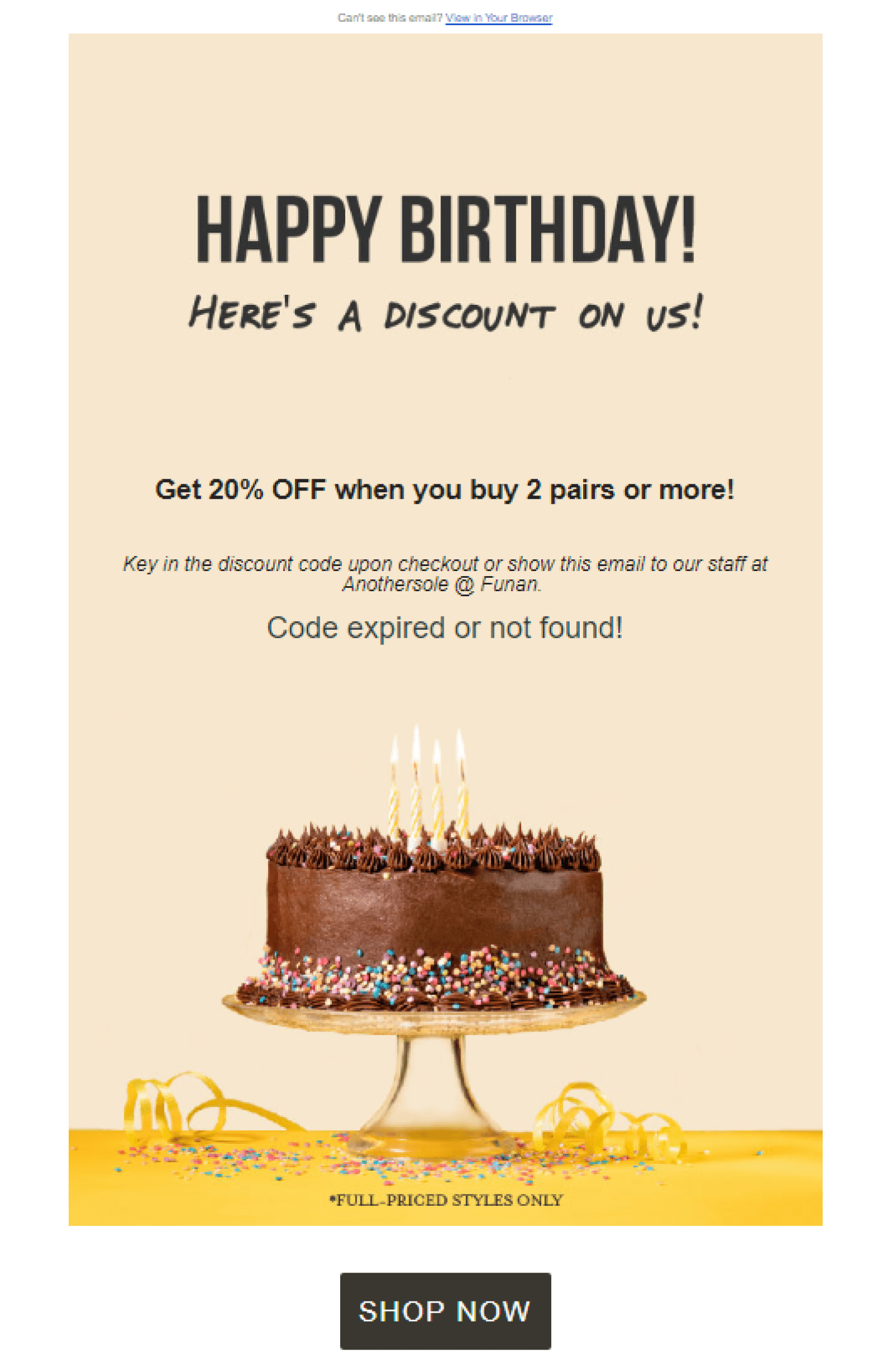
Running in the same vein, also avoid using multiple fonts, adding too many colors or putting too many links in your copy.
Spam test
Finally, the last thing you can do to improve your deliverability is to spam test your emails using Mail-tester.
To do this, just send your email to the address listed on Mail-tester’s website, and it’ll generate a report with information about your SPF & DKIM configuration, email server IP, potential blacklisting, and more. The higher your score, the less likely your email will be flagged as spam. Mail-tester also provides actionable tips to tell you how to improve your score.
Over to you! Here’s a recap on how to improve your email deliverability:
- Take care of the technical elements by setting up SPF, DKIM and DMARC.
- Warm up your domain by sending out messages to email addresses that you know exist. Try and have sustained conversations instead of sending once-off messages.
- Keep your bounce rate and complaint rate low. Check MXToolbox to make sure you haven’t been blacklisted.
- Send a consistent volume of emails everyday. Send out your emails over a few hours rather than having everything go out at the same exact time.
- In your email copy, avoid using words that may trigger spam filters.
- Minimize the use of HTML in your emails. Don’t use too many pictures, add too many colors, or include too many links.
- Spam test your cold email using Mail-tester before scheduling it to go live.
Setting up a Second Domain for Your Cold Emails
Wojtek Błażałek @ Woodpecker.co
Assuming you’re only sending a couple of emails and/or your prospects respond well to your emails, then it’s perfectly fine to do it from your main domain. (This is the same domain that you use to host your company website and email your customers and business partners).
But more often than not, marketers scale their cold email campaigns to send hundreds (or even thousands) of emails per day. When this happens, this leads to a host of problems, including your email engagement rate dropping, your emails getting flagged as spam, and more:
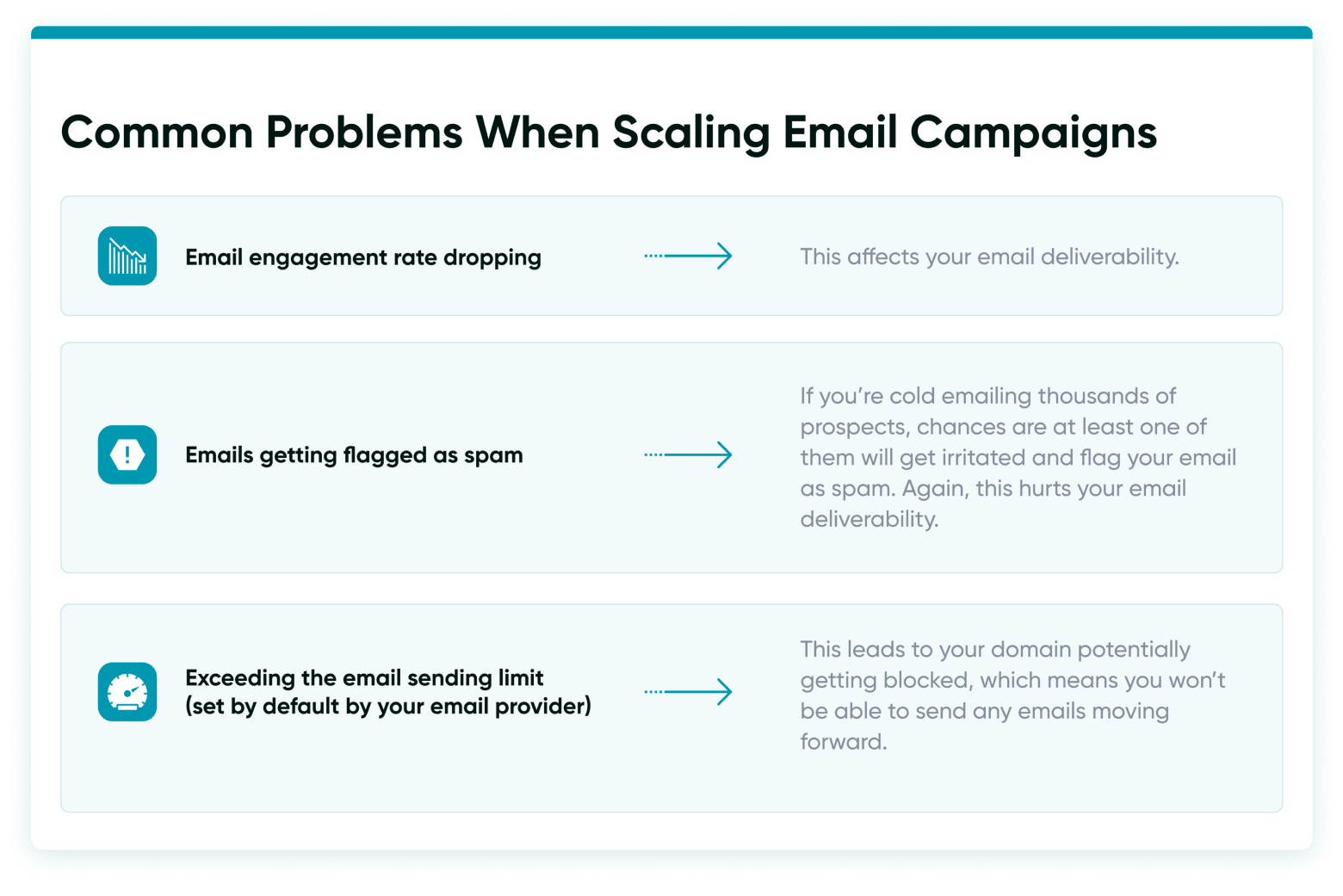
Unfortunately, there’s no foolproof solution that you can apply here. The techniques we’ve discussed so far (segmentation, personalizing, etc) all help to reduce your chances of running into such issues, but even if you use these techniques, you’re not guaranteed a clean record.
So if you plan to make cold email part of your long-term marketing strategy, it’s crucial to set up a second domain that’s devoted solely to cold email campaigns. Here are the steps involved:
- Brainstorm a new domain name
- Warm up your new domain
- Set up your first automated campaign
- Set up your official cold email campaign
Brainstorm a new domain name
First and foremost, come up with a domain name that’s related to your main domain. For example, when we were setting up outreach domains at Woodpecker, we added “get” before our company name to come up with “GetWoodpecker”. Here are some other domain prefixes and suffixes to try:
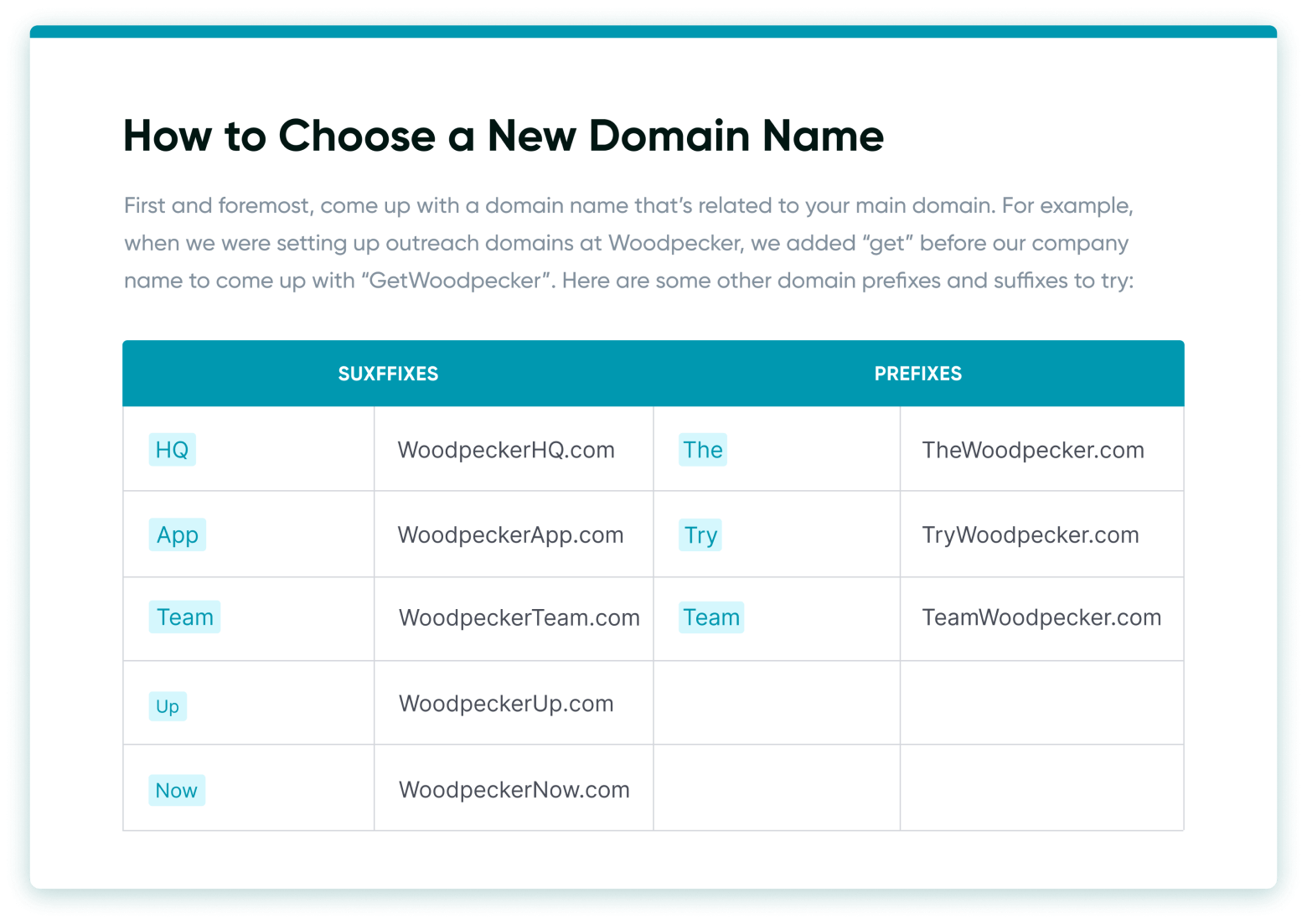
Alternatively, you can go with the .net, .io or .co of your main domain, such as Woodpecker.net, Woodpecker.io or Woodpecker.co. Once you’ve done this, go ahead and purchase your domain name.
Warm up your new domain
After you’ve bought your domain name, don’t rush to email your prospects immediately! Instead, take two to three months to warm up your new domain first. As mentioned in the previous chapter, you can do this by sending out a few emails every day, using conversational language in your emails, and sending and receiving replies to build up your email threads.
Set up your first automated campaign
When you’ve spent two to three months warming up your new domain, it’s time to set up your first automated campaign.
Again, take it easy here. I recommend setting up a lean campaign comprising three to four emails and targeting ~30 verified prospects. With time, you’ll be able to increase the number of emails you send, but as of now, you want to make sure you’re within your email provider’s sending limits:
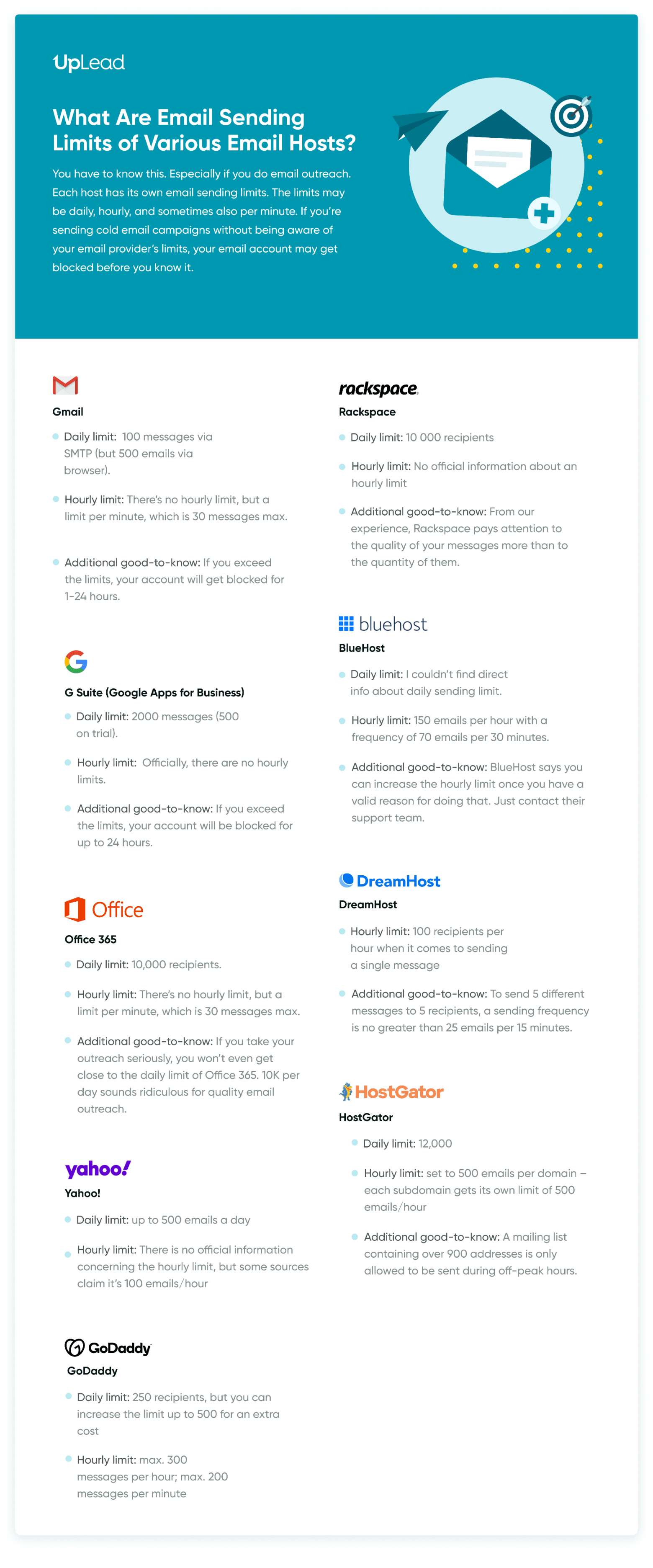
Set up your official cold email campaign
After two to three months of running your first automated campaign, your sending domain should be properly warmed up.
Over to you! Here’s a quick recap of how you can set up a second domain for your cold email campaigns:
- Brainstorm a new domain name, and buy the domain. Companies commonly affix words such as “app”, “service”, “try” before their company name.
- Warm up your new domain by setting your SPF, DKIM and DMARC records, and emailing a couple of email addresses that you know exist.
- Set up your first automated email campaign. Keep this lean – we’re talking no more than three to four emails, and 30-odd prospects. Run this for two to three months at least.
Automating Your Cold Email Campaign
Sujan Patel @ Mailshake
Once you’ve grasped the basics of email marketing, the next step is to introduce automation into the equation.
What does automation do for your company? At its essence, automation takes what your sales team is doing already and scales it up exponentially. On top of that, it also stops prospects from slipping through your fingers due to human fatigue or forgetfulness.
Here’s how to automate your cold email campaigns for better results:
Send personalized cold emails at scale
Any email platform worth its salt will allow you to send cold emails in bulk, without losing that personal touch. This means massively increasing the number of prospects you’re engaging with each day, while still including vital aspects of personalization such as each recipient’s name, company, industry, and more.
Follow automated content suggestions
The best email automation tools will also give you a real-time analysis of your content, helping you to word your emails in a more effective manner.
For instance, Mailshake has an email copy analyzer that highlights issues such as the use of spammy phrases, and overly wordy paragraphs that may turn off your prospects. Simply follow the guidance you’re given, and see your engagement improve:
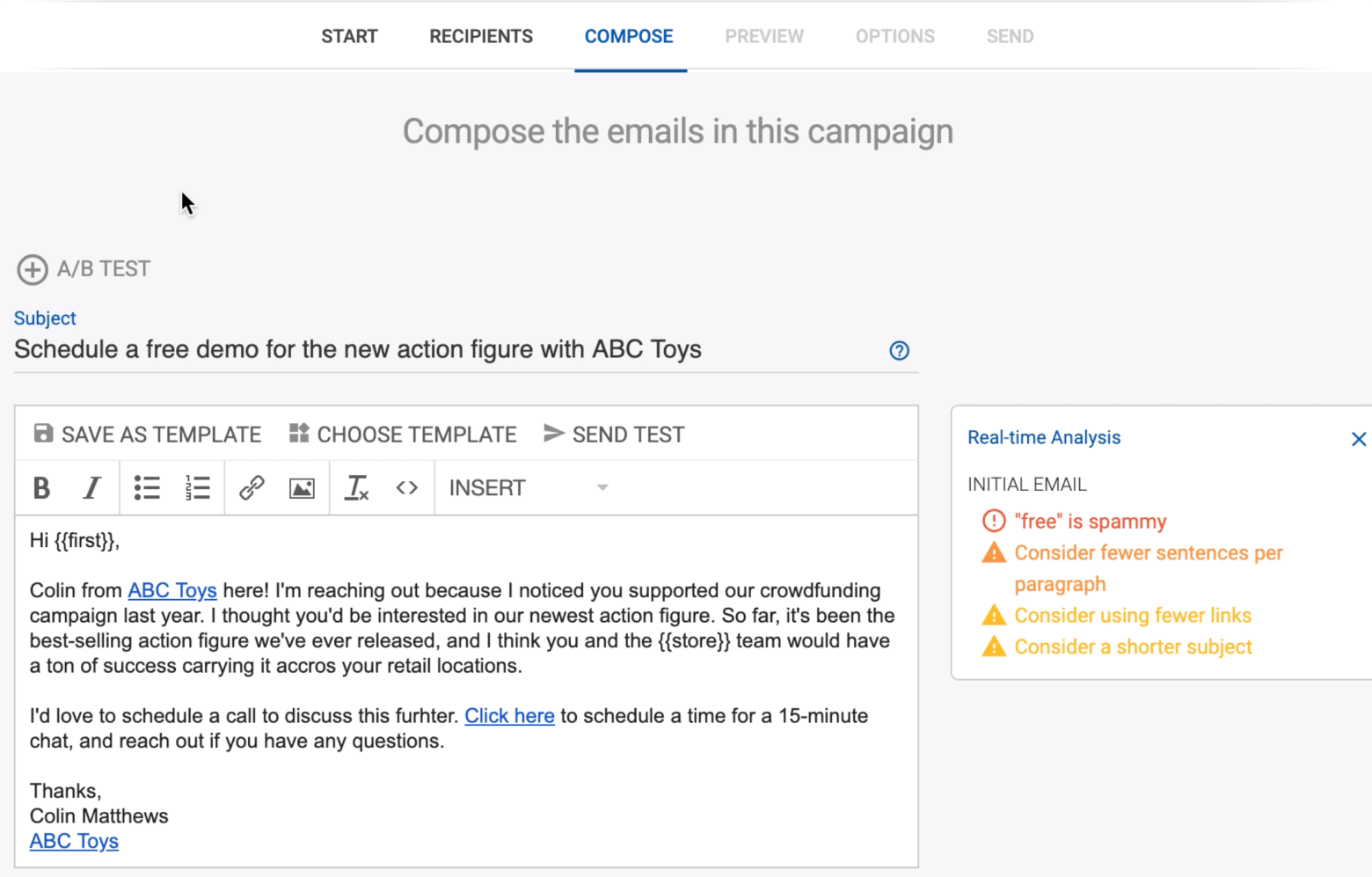
Get visual representations of your statistics
It’s no secret that data is key in any sales campaign. Data must be collected, organized, and analyzed before you can use it to draw recommendations to optimize your campaigns. Data analysis can be tedious, but it beats guesswork when the results come rolling in.
Luckily, email automation tools do the heavy lifting for you. These tools know which stats are most important to your campaigns, automatically collect them, and organize them in a visual, easy-to-interpret way.
Filter leads automatically
Many automated tools allow you to configure what you consider to be a lead using hard data (for example, two click-throughs or one reply). From here, you can also specify if you’d like to place all your leads in a streamlined inbox for you to reply to. This simplifies your workflow, and allows you to spend more time engaging your leads.
How to automate your cold email campaign using a content-focused sequence
Guillaume @ lemlist
Here at lemlist, we use a ton of content-focused prospecting sequences, which basically means that we craft our cold email campaigns to revolve around content. In this case study, we show you how to come up with a content-focused campaign to engage your prospect.
To start off, connect with your prospect by identifying a common interest. In the example here, our common interest is Rand Fishkin and the story of Moz.
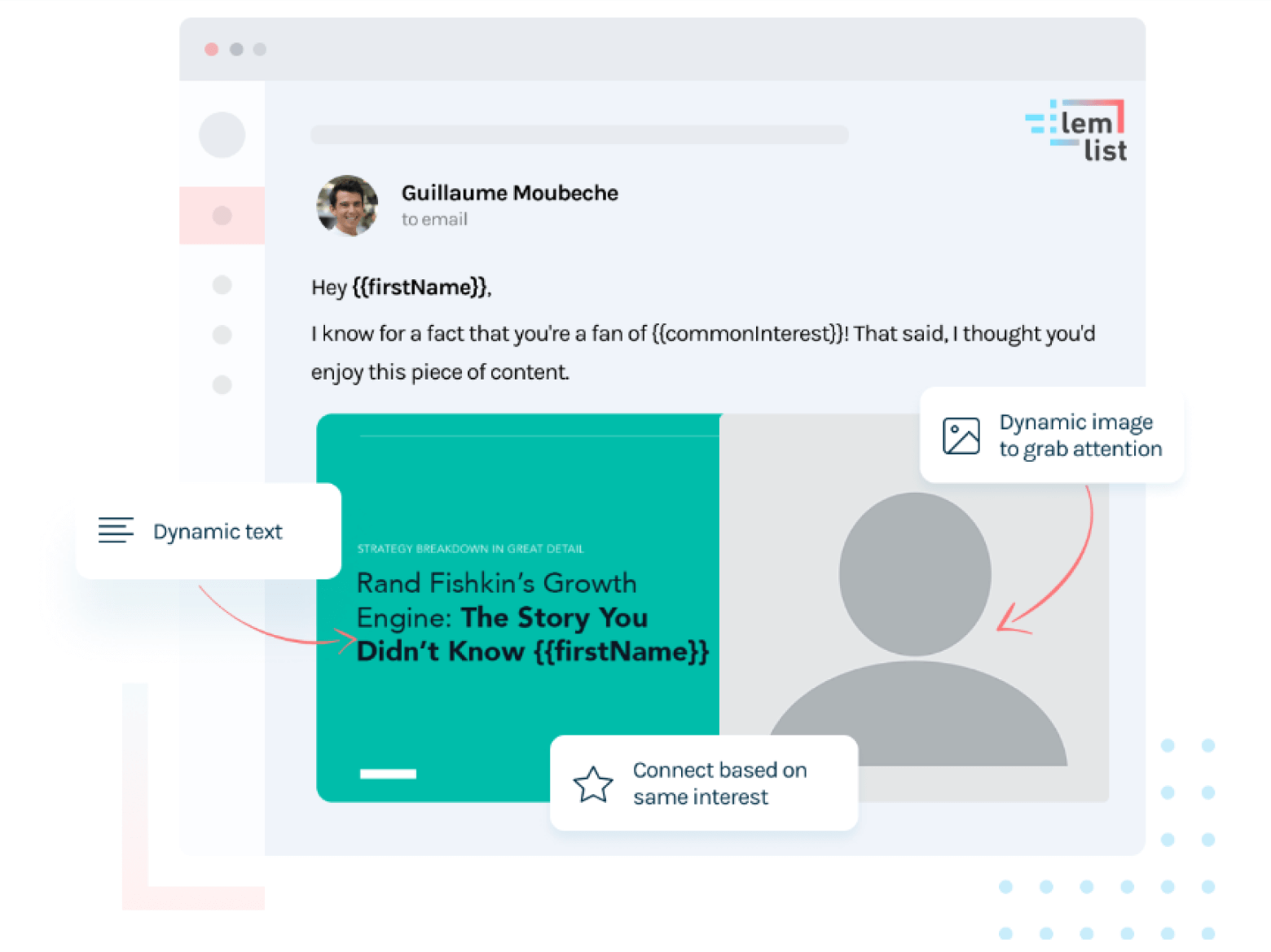
If you don’t want to share an external piece of content, you could also create an actionable case study around the interest you and your prospect share, and send this instead. Make sure your case study provides value, and doesn’t hard-sell.
Assuming your prospect doesn’t reply, your campaign would fire off a second email a few days later. This email should consist of a personalized video that applies all those principles from the previously shared content to their business.
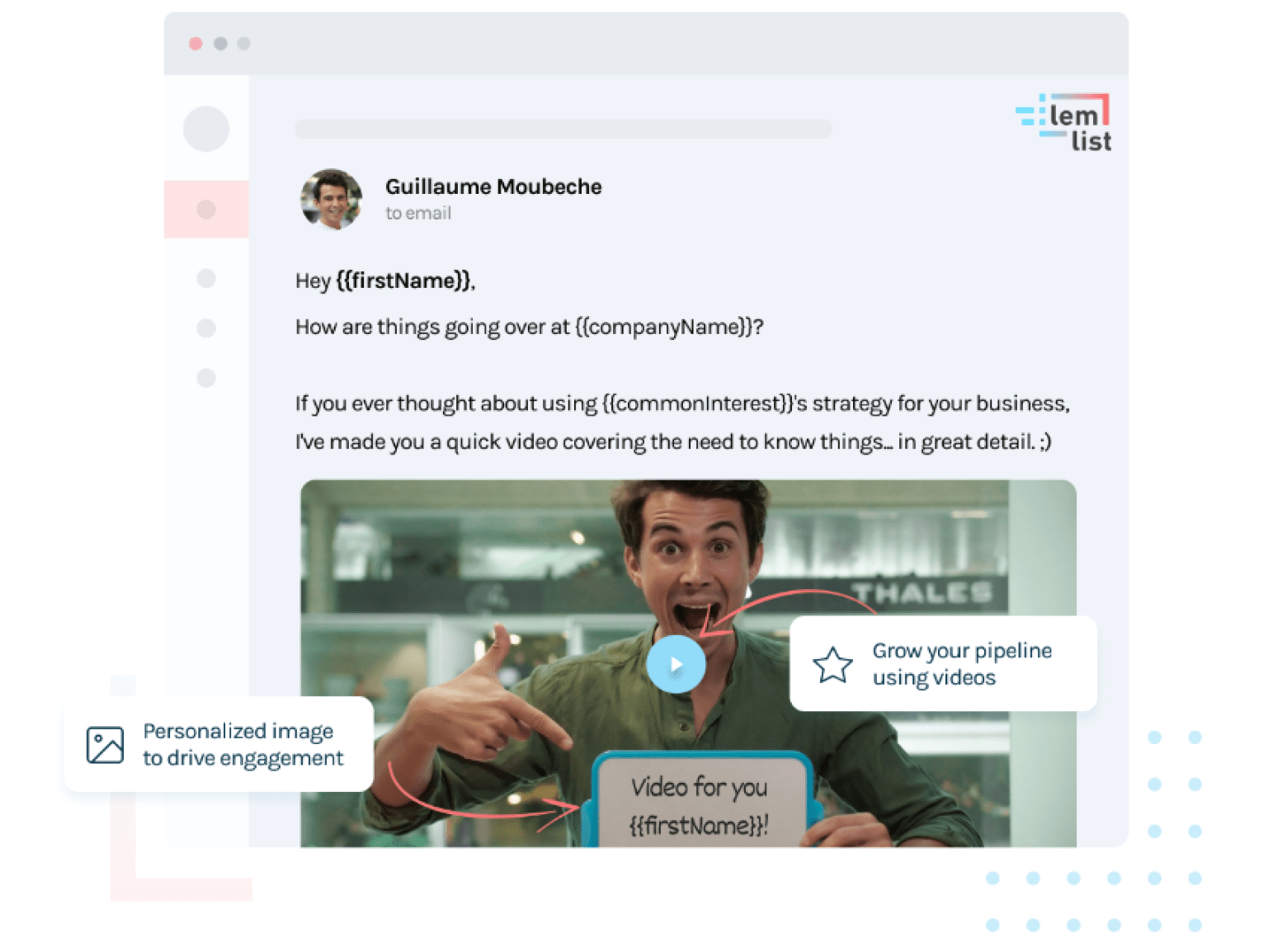
After clicking on the image, prospects get redirected to our dynamic landing page, which adds more personalized layers to the picture. We built these pages directly in lemlist, zero coding needed. Here’s how it looks:
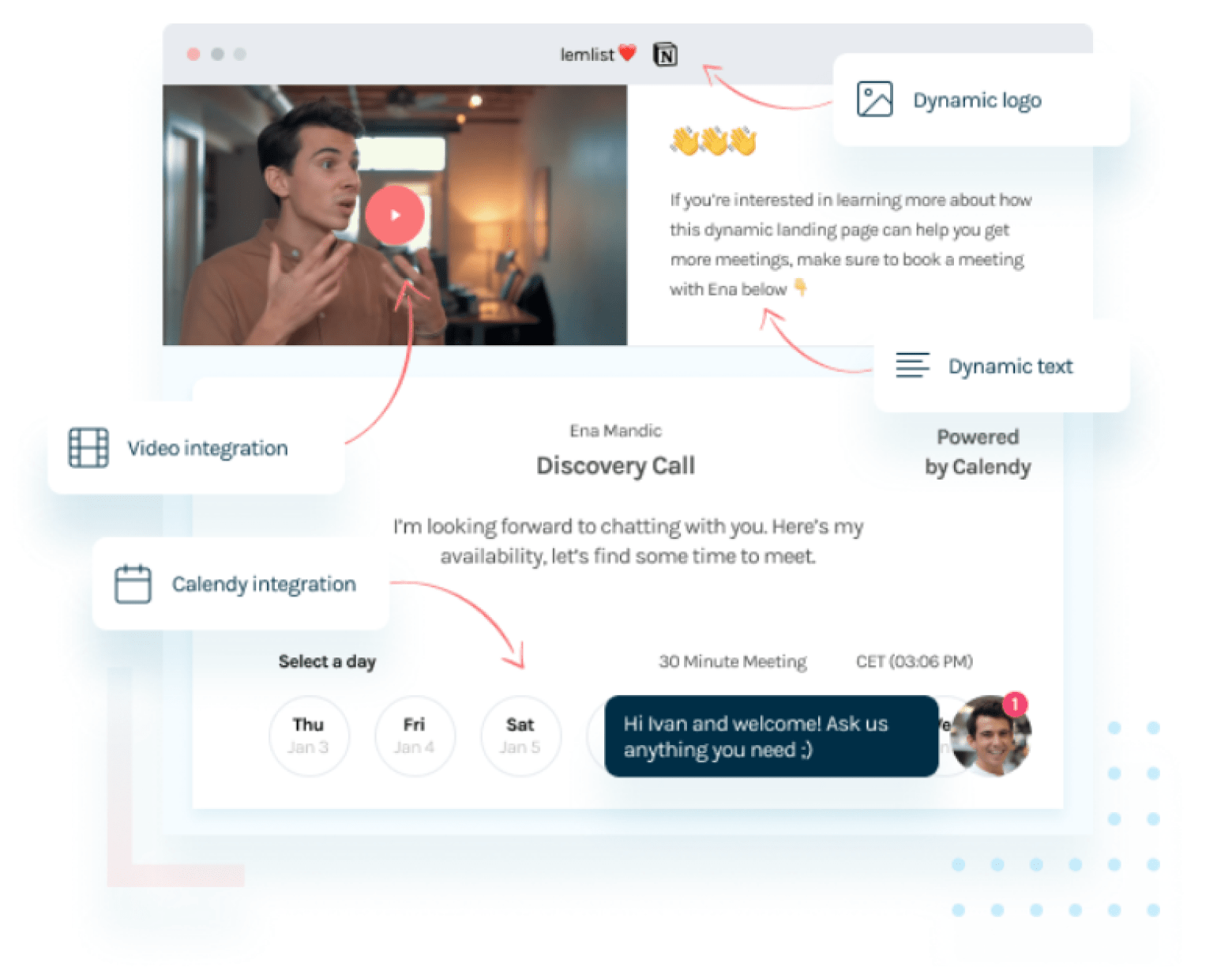
As you can see, many things are happening there. We have a video, customized copy, dynamic logo, an embedded Calendly widget that decreases friction, and live chat that pops up as soon as the video finishes.
Here, we could also consider some backup goals. Besides moving the prospect down the funnel, we might want to invite them to join our community, glue them to our Facebook Pixel or have them subscribe to our YouTube.
Over to you! Here’s how you get started with email automation:
- Decide what, exactly, you’d like to automate. Aside from the obvious (automating your follow-up emails), you can also have your email tool automatically filter and qualify prospects, analyze your email metrics to create reports for you, etc.
- Consider investing in a better email marketing platform (if your existing tool doesn’t offer much in terms of automation).
- Regularly review your automated campaigns to make sure they’re performing well. It’s exceptionally important to utilize a conversational tone with these campaigns… the emails may be automated, but you don’t want them to sound like they’re coming from a bot!
Cold Email Software to Use
Now that you know how email automation works, let’s look at a couple of email automation tools that you can use to get started.
Mailshake
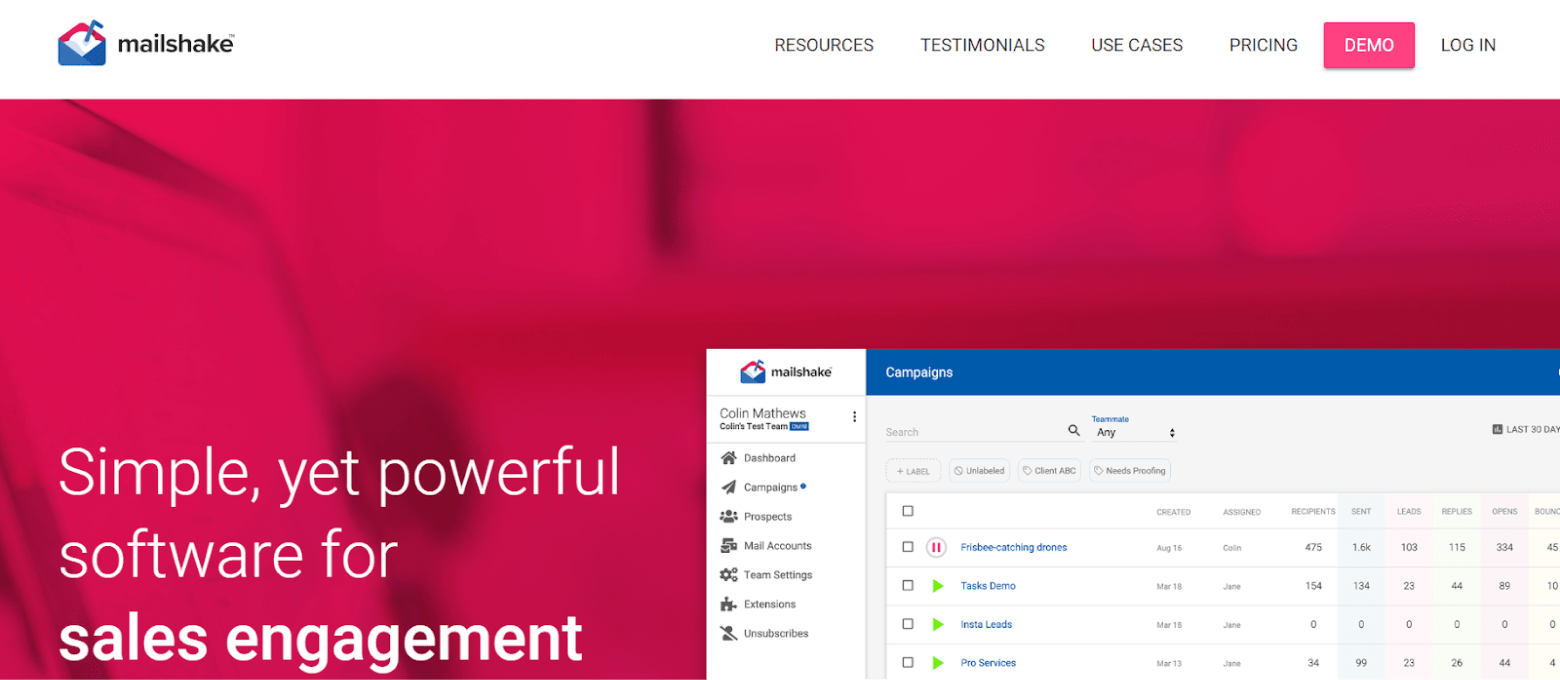
Mailshake is an email marketing software that allows you to send personalized cold emails at scale. Apart from automating your cold emails, you can also use Mailshake to engage with your prospects via phone call and social media, and have all your data reflected on a single dashboard.
Pricing: $59/month onwards. Mailshake comes with a 30-day guarantee, and they will process a full refund for you if you’re not 100% satisfied with their software.
Lemlist
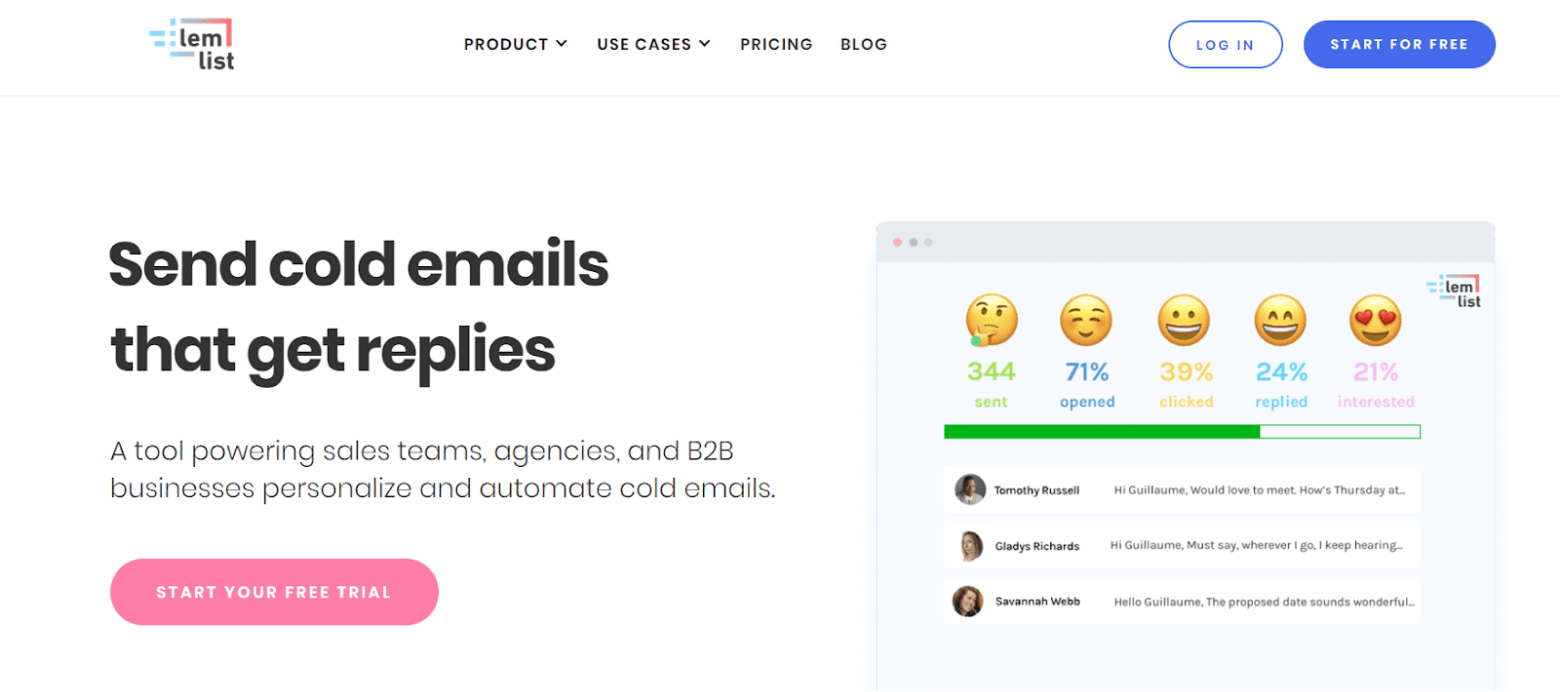
Lemlist is a marketing automation tool for anyone who wants to personalize and automate their cold emails. The tool comes with a huge collection of ready-to-use email templates, including sales emails, follow-ups, backlink generation emails, sourcing emails, and more. To maximize your email deliverability, there’s even “lemwarm”, a feature that helps you automatically warm up your new emails or domains.
Pricing: $29/month onwards.
Woodpecker
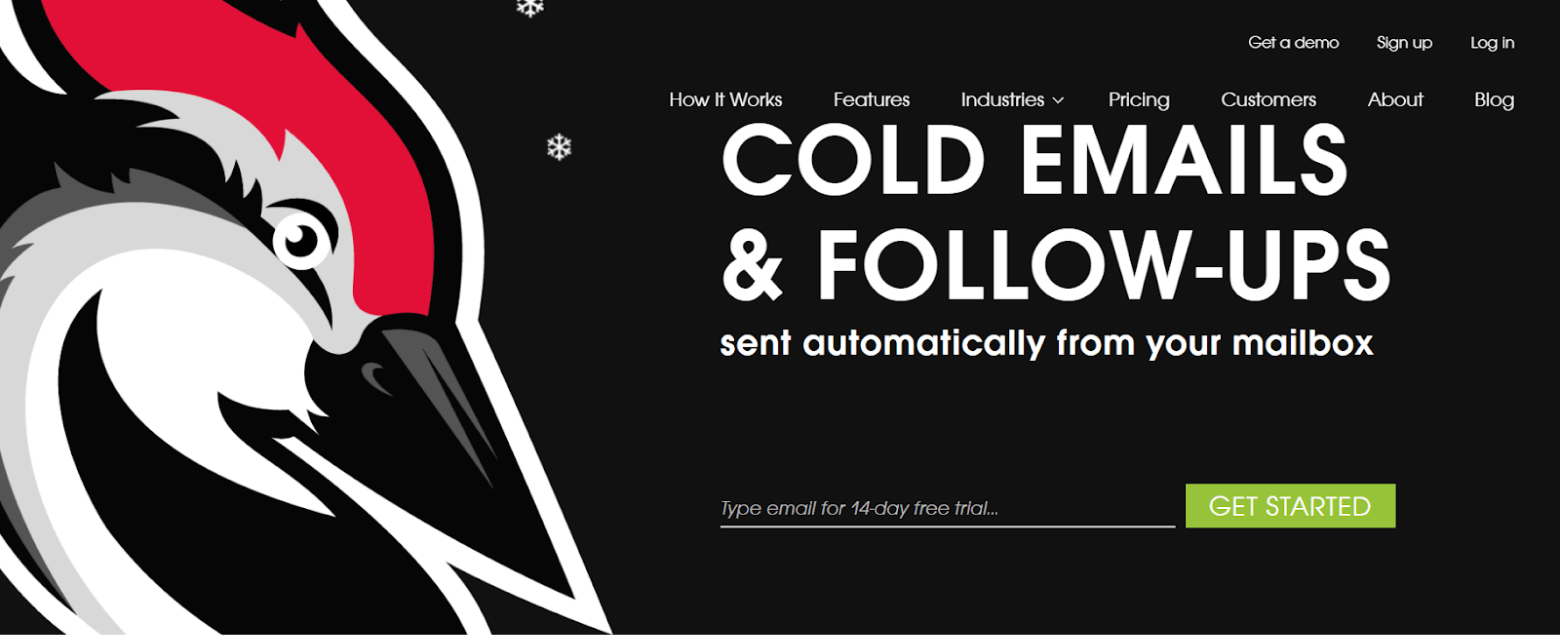
Woodpecker is an email marketing tool that specializes in cold email outreach and inbound lead nurturing. Simply schedule your cold email campaign to go out, and Woodpecker will use their email throttling algorithm to ensure that your emails are sent out individually with irregular frequency (making it seem like your emails are sent manually). This keeps your email deliverability high, and keeps you in your domain host’s good books.
Pricing: $40/month onwards.
Reply.io
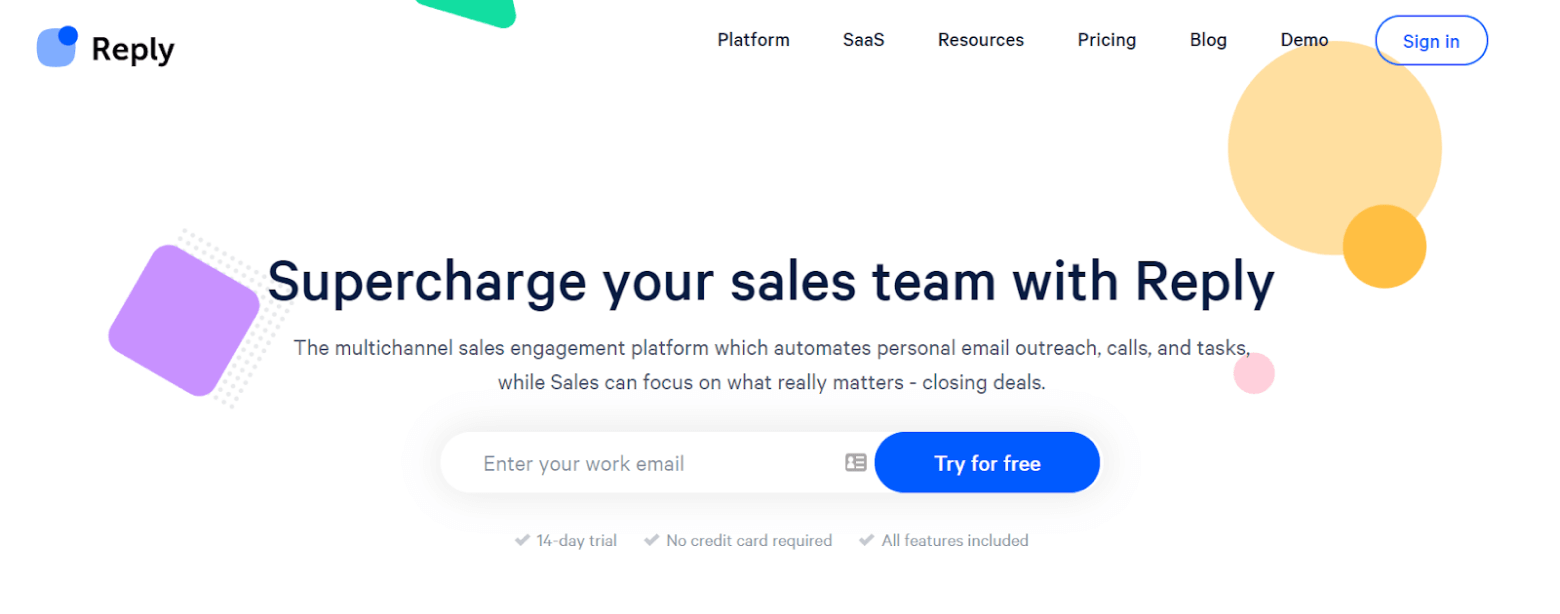
Unlike the other email marketing software on this list, Reply.io is more of a sales engagement platform than a standalone email marketing tool. While you can take care of your email marketing and automation with Reply.io, that’s only scratching the tip of the iceberg – you can also use the tool to discover prospects, manage your contacts, and generate a list of tasks for your sales team to optimize their workflow.
Pricing: $70/month onwards.
Outreach.io
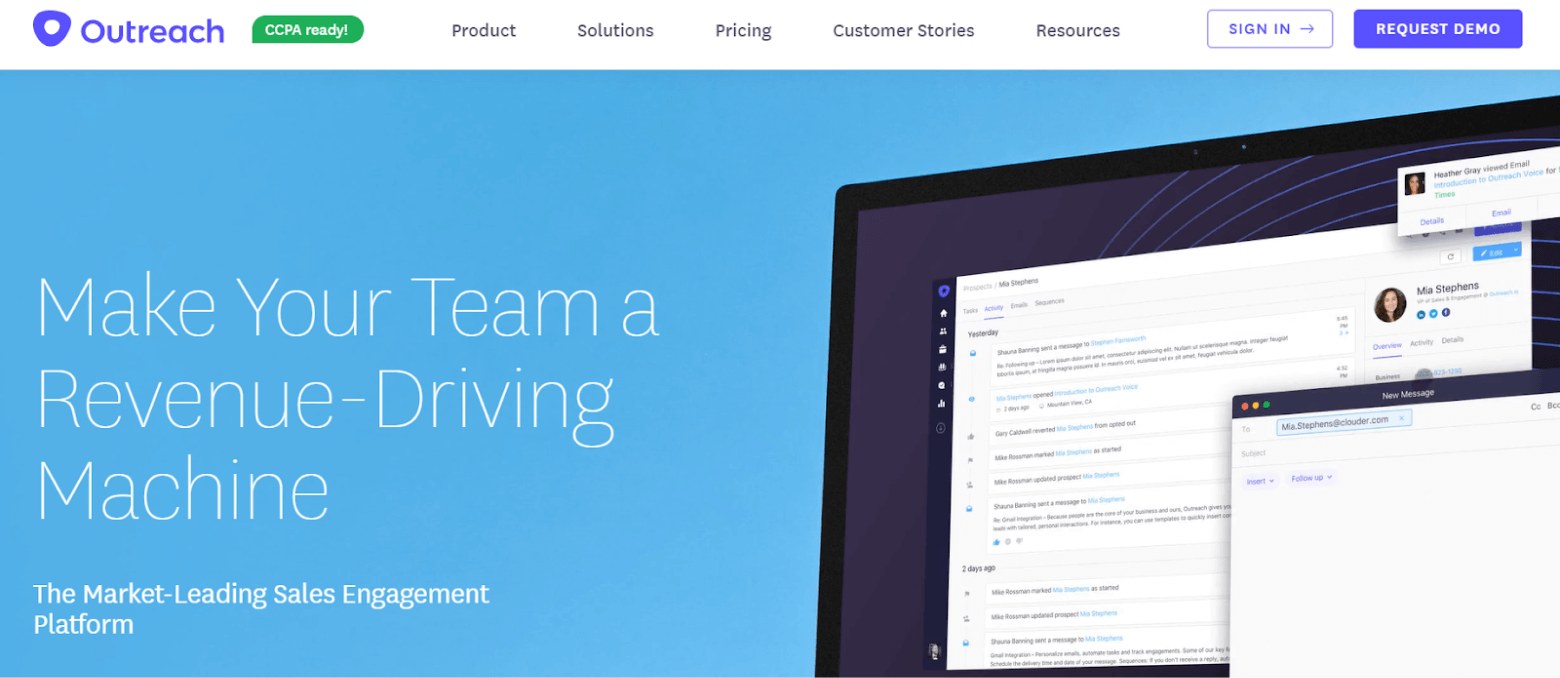
Outreach.io is a feature-rich sales engagement platform that you can use to optimize your marketing and sales outreach. You can use Outreach.io to hone in on specific accounts and set up an account-based marketing strategy, then automate and personalize your sales campaigns using emails, voice messages and more.
Outreach.io also allows you to coordinate the efforts of your sales and marketing teams, so that your sales reps can quickly follow up with your most qualified leads.
Pricing: No pricing information provided online – those who are interested will have to contact Outreach.io to request for more information.
Cold Email Follow-Up: Here’s How to Send Follow-Up Emails
Lee Gladish @ Airborneapp
Even if you’ve written the best cold email in the internet history, you’re competing with the hundreds of other emails your prospect has received that day. Bearing this in mind, you can’t take it for granted that they’ll open (or respond to) your carefully crafted email.
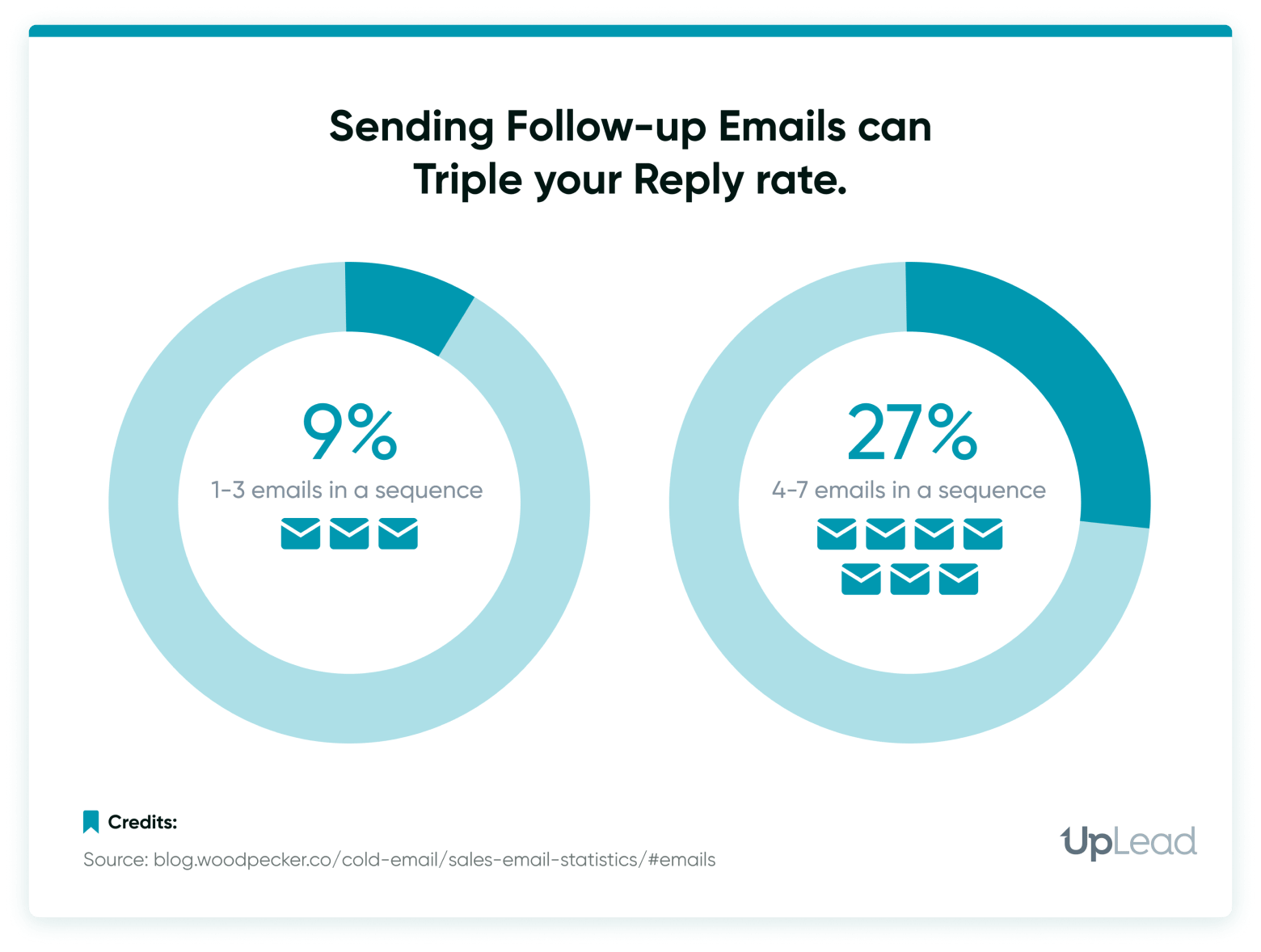
Not all is lost, though. You can use a solution to increase your chances of getting your cold email read and replied to, and that’s… follow up emails!
Why follow ups work
When I encourage people to use follow ups, they’re often hesitant. If a prospect didn’t respond to their first email, why send another? Isn’t that kinda rude? Won’t it just annoy them?
I get it. I certainly don’t want to annoy people. But with the number of emails being sent and received every single day, the fact is it takes more than one email to get someone’s attention.
That’s where follow up emails come in handy. At its essence, a follow up email is a reminder and a prompt for your prospect to take a certain action. Hopefully, that’ll be a positive action, such as reading your email and replying positively.
Of course, there’s always the chance that your prospect might unsubscribe, or even write a nasty reply. While this isn’t the best-case scenario, there’s an upside to it: at least you know that your prospect isn’t interested, and you can stop wasting your time on their account.
Writing a good follow up email
There are a number of different approaches you can try for your follow ups. Some marketers send a simple message such as “Just checking if you saw my previous email,” “Is this of interest?” or even just “Bump.” While these simple follow ups are better than not following up at all, as a professional email marketer, you can do better!
To get started, follow these tips:
- Keep your emails short. I’m a big believer in brief emails that respect your prospect’s time, and that goes double for your follow ups. There’s no need to launch into a long essay with your follow up.
- Offer additional value. While short emails are good, don’t make them so short they don’t contain anything worthwhile. Your follow-up should offer a persuasive reason (ideally building on the initial email) for the prospect to pay attention and respond.
- Try different call-to-actions. If a prospect hasn’t responded to your initial email, why not mix up your CTA? For example, if your first email invited them to jump on a call, offer them a resource to download in your follow-up.
- Use personalization. Many marketers will personalize their initial email, then send the blandest, most impersonal follow-ups. Personalization is important to every email. Making your follow-ups personal to the prospect and their pain points means they’ll be much more likely to respond.
How many follow ups you should send
Knowing the right number of follow ups to send is a balancing act. The more emails you send, the more responses you’ll get. However, if you send too many, you risk upsetting potential prospects and being permanently blocked.
The aim is to send as many follow-ups as necessary to get the maximum positive response from your email list. We’ve found that 6-7 follow-ups are our sweet spot at Reply. However, I highly recommend testing this for your own unique offer and audience to see what works best for you.
It’s also important to not leave your follow-ups to chance. You need a reliable method to schedule your follow-ups. The ideal solution is to automate your whole sequence from start to finish, saving you the trouble of remembering who’s due a follow-up and who isn’t. Remember, you can easily do this with any of the automation tools discussed in Chapter 11.1.
Prioritizing your follow-ups
If the thought of following up on every single email feels overwhelming, you should prioritize high-value prospects and anyone who’s demonstrated interest.
How do you figure out who these prospects are? Email software like Reply, which can automate both the initial cold email and the follow-ups, can also show you if a prospect has opened your email multiple times. This clearly indicates that they’re interested in what you have to offer.
Still, following up doesn’t mean spamming your prospects into submission. If a prospect requests that you stop emailing them, then stop. It’s a legal requirement under CAN-SPAM laws and, more importantly, it’s the ethical thing to do.
To do this, I recommend that you use an email automation tool that automatically removes people who reply from subsequent follow-ups (as well as anyone who opts out).
Over to you! Here’s how you can start crafting your follow up strategy:
- Identify your high-value prospects, and your prospects who have demonstrated interest in your product/service. These are the folks that you should prioritize when following up.
- Decide how many follow ups you want to send to your prospects. If six to seven follow ups sound too aggressive to you, start off with just three or four, then take it from there.
- Craft your follow up emails. Keep them short, add value, and experiment with different offers and CTAs.
- Use your email marketing software to schedule your follow ups. Set a rule to automatically remove respondents and unsubscribers from further follow ups.
- Test to find out how many follow-ups you need to get the maximum number of positive responses, without irritating your prospects.
Case study: Following up in a way that adds value
Jason Bay @ Blissful Prospecting
Part of our strategy at Blissful Prospecting is to get on as many high-quality sales podcasts as we can, so that we get the word out about our brand. To do this, we cold email our prospects (people who own podcasts) and ask for an opportunity to join their podcast as a guest.
Here, I’ll walk you through my entire cold email campaign, and share how I used my follow up emails to add value to the conversation, and nudge my prospects into saying “yes”.
For context, my first email to my prospects introduces myself and tells them I’d love to be interviewed as a guest on their podcast. Here’s what it looks like:
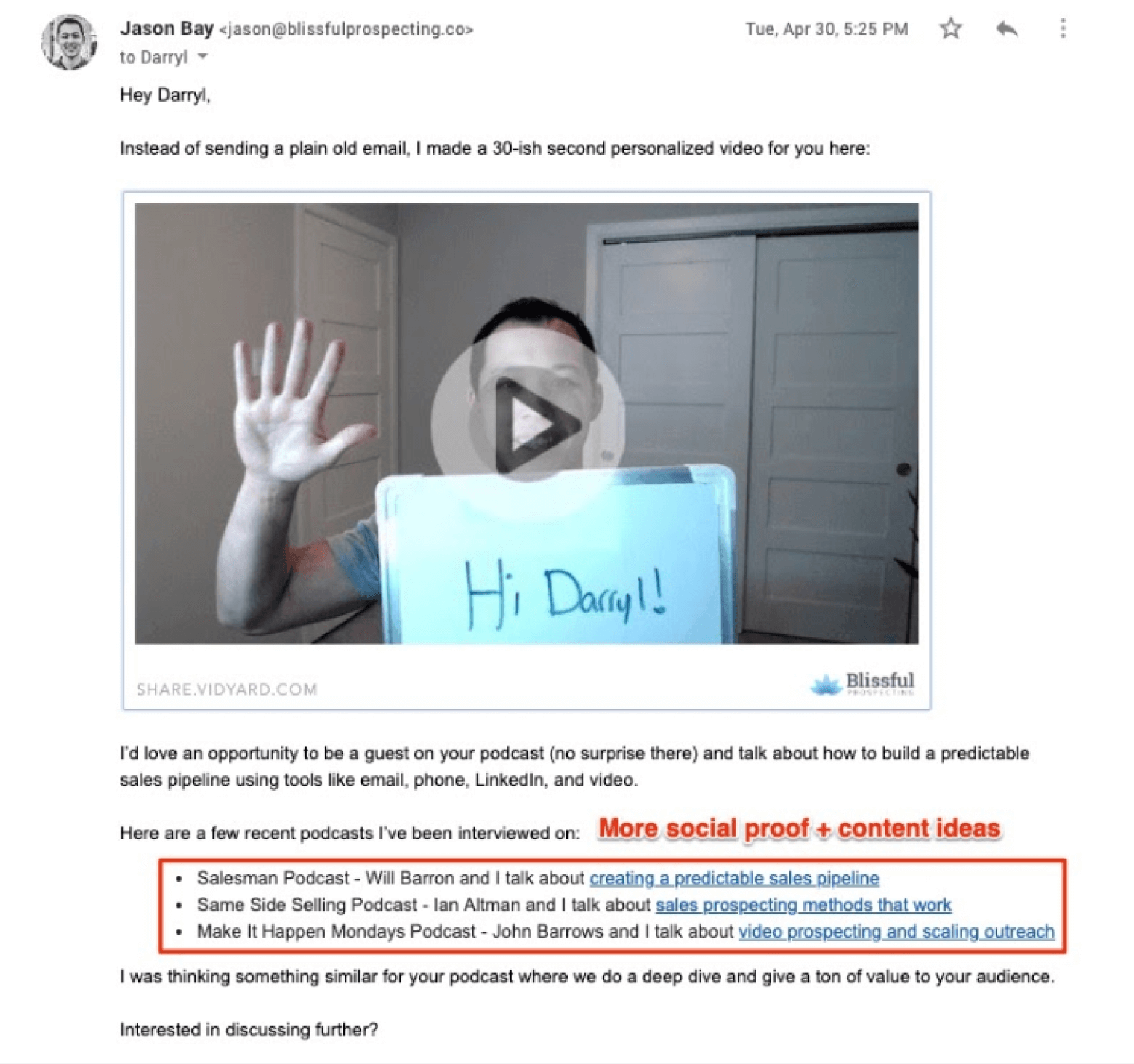
If they don’t reply, I send my first follow up email:
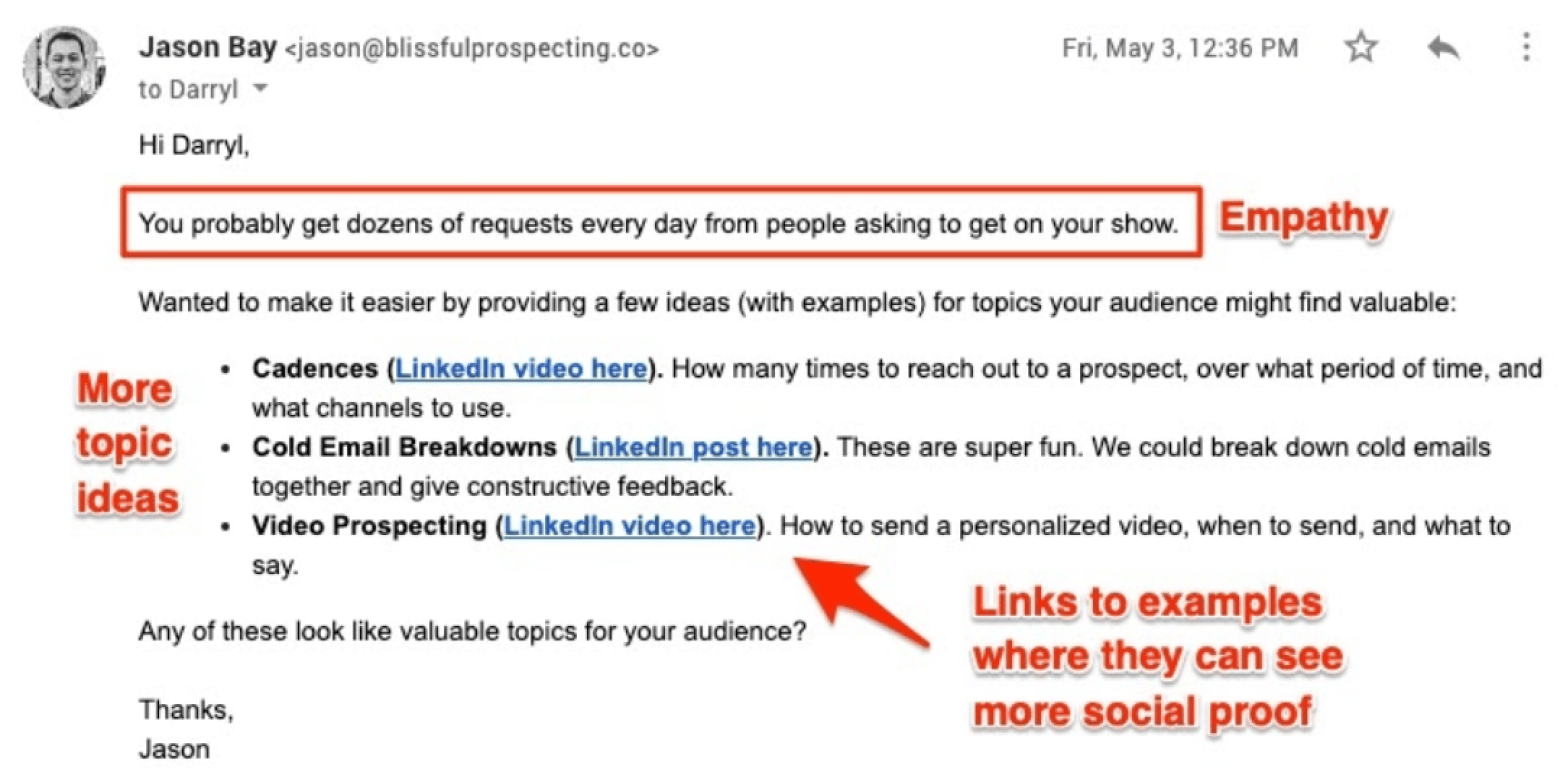
What I did here:
- Led with empathy, acknowledging that the prospect probably gets a lot of cold emails.
- Shared a few topics that I could talk about on their podcast. This reduces friction, because now my prospect doesn’t have to spend time brainstorming potential topics – they can just look through my list and pick the one they like the best
If the prospect still doesn’t reply, I hit them up with this second follow up email:
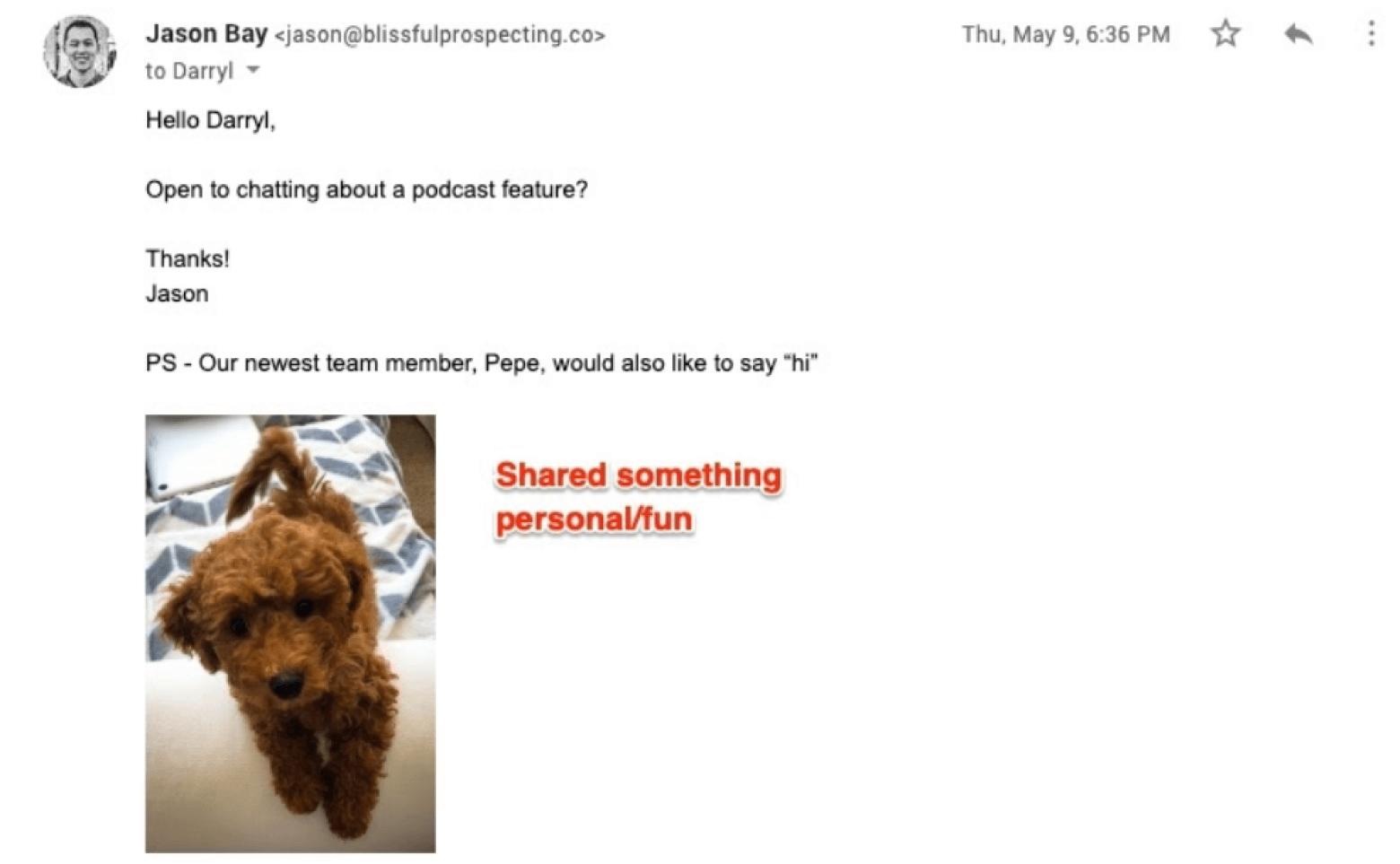
What I did here:
- Showed persistence, but not in an annoying way.
- Showed a personal/funny side of myself. You can pull the “I have a cute puppy card” like what I did here – trust me, it works.
If my prospect gets back to me, that’s great. If not, I take one last stab at it with my final follow up email:
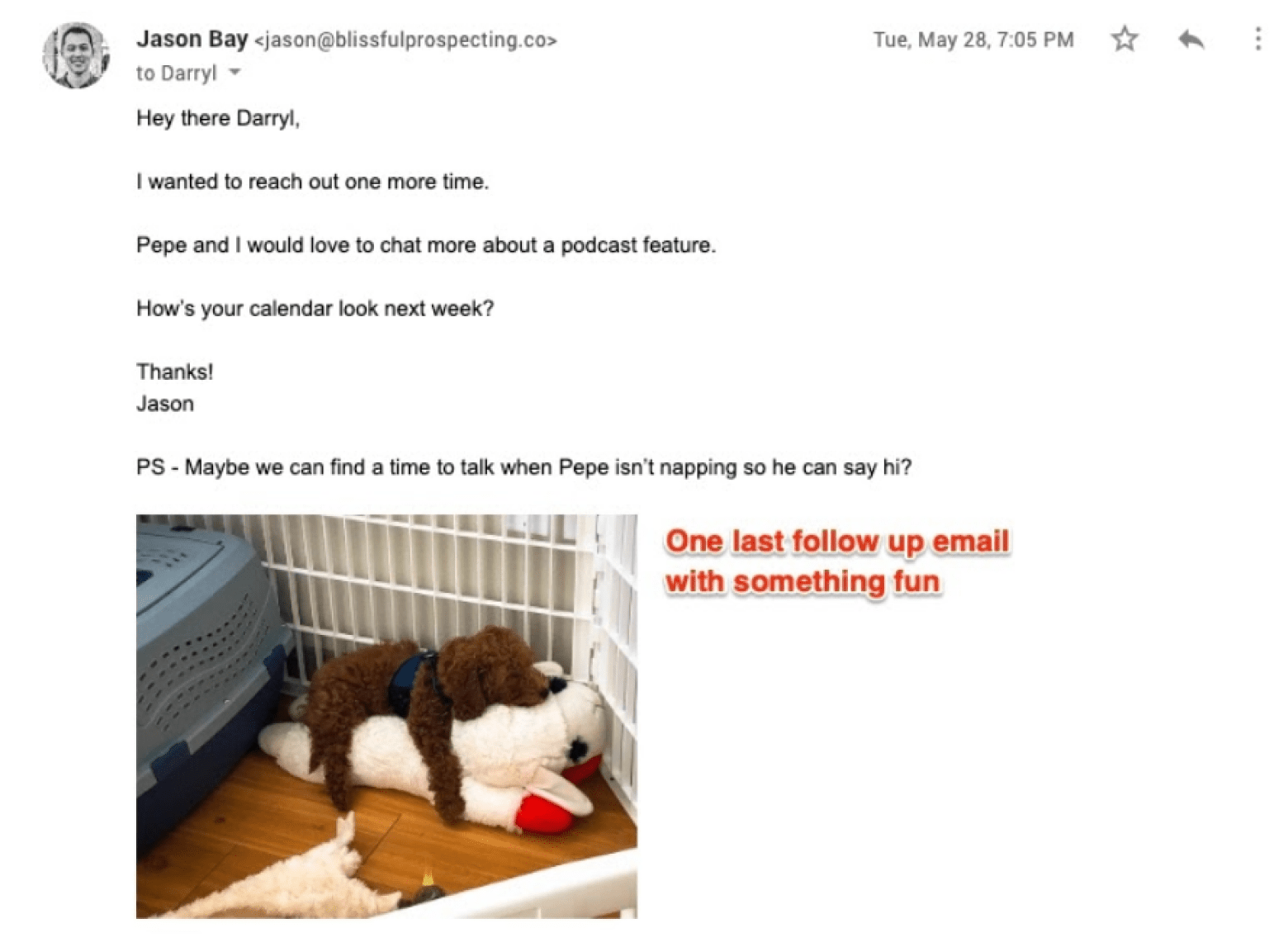
What I did here:
- Showed persistence, but not in an annoying way.
- Showed a personal/funny side of myself.
- Left the invite to chat open-ended and casual, instead of being too aggressive.
A/B Testing to Improve Your Campaigns
Guillaume @ lemlist
A/B testing, or split testing, is a way of comparing two versions of a single email or email campaign. It’s typically done by testing the subject’s response to Email A against Email B, and determining which one is more effective.
For those of you who are new to A/B testing: most email tools and/or A/B testing tools will refer to the two emails you’re testing as Variant A and Variant B. These just refer to your two different emails (Email A and Email B), so don’t get confused by the terminology!
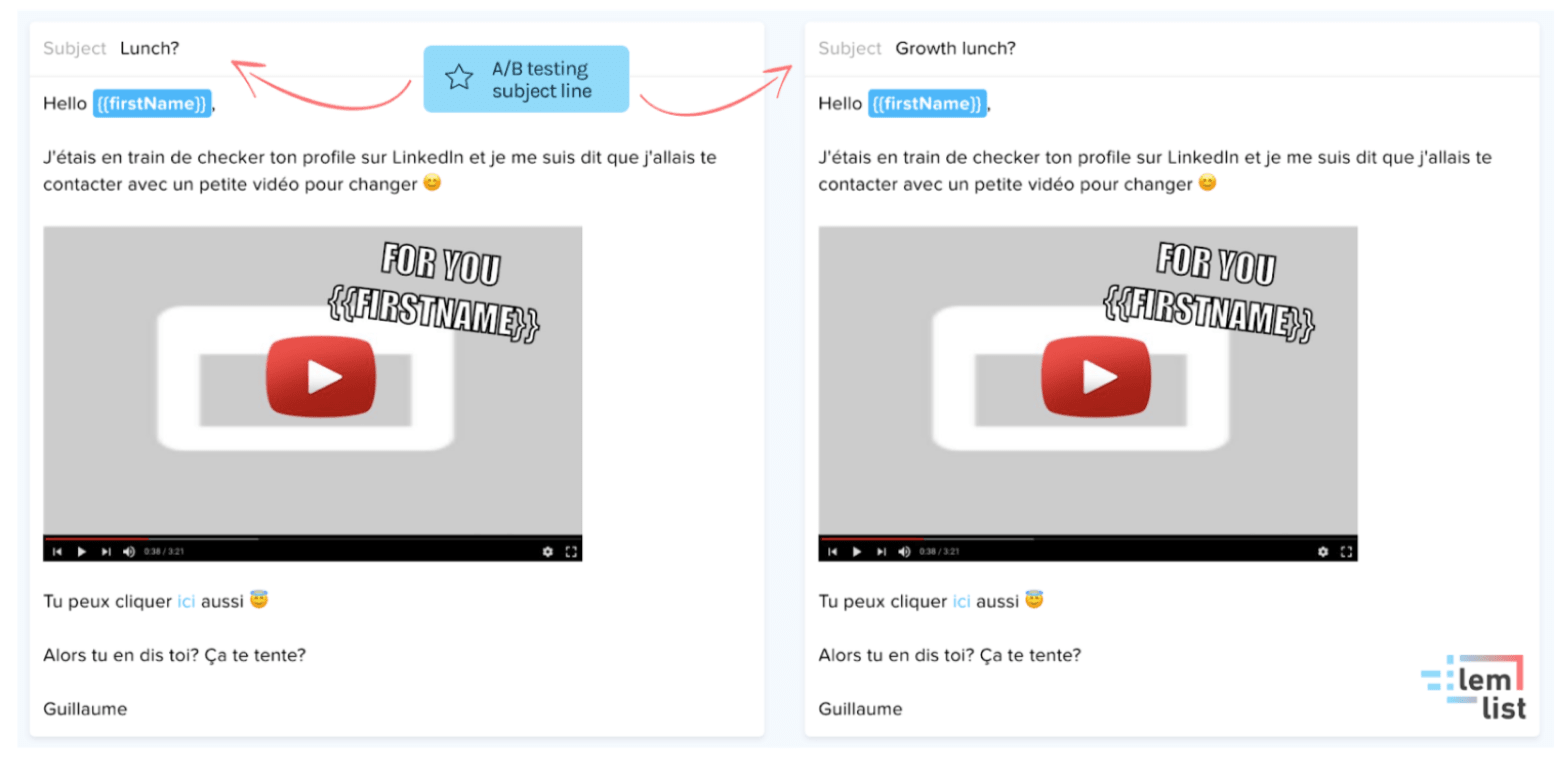
As you’ve probably already guessed, it’s critical to run A/B tests if you want to get better at cold emailing because it’s the only way to know what’s working or not.
Make sure you change only one variable at a time
While you can get creative with A/B testing, there’s one golden rule that you should always abide by, which is only changing one variable at a time.
For instance, say you’re keen to find out whether the length and tone of your email subject line will affect your open rates. Now, these are two different elements you’re looking at here, so you’ll want to run two different A/B tests:
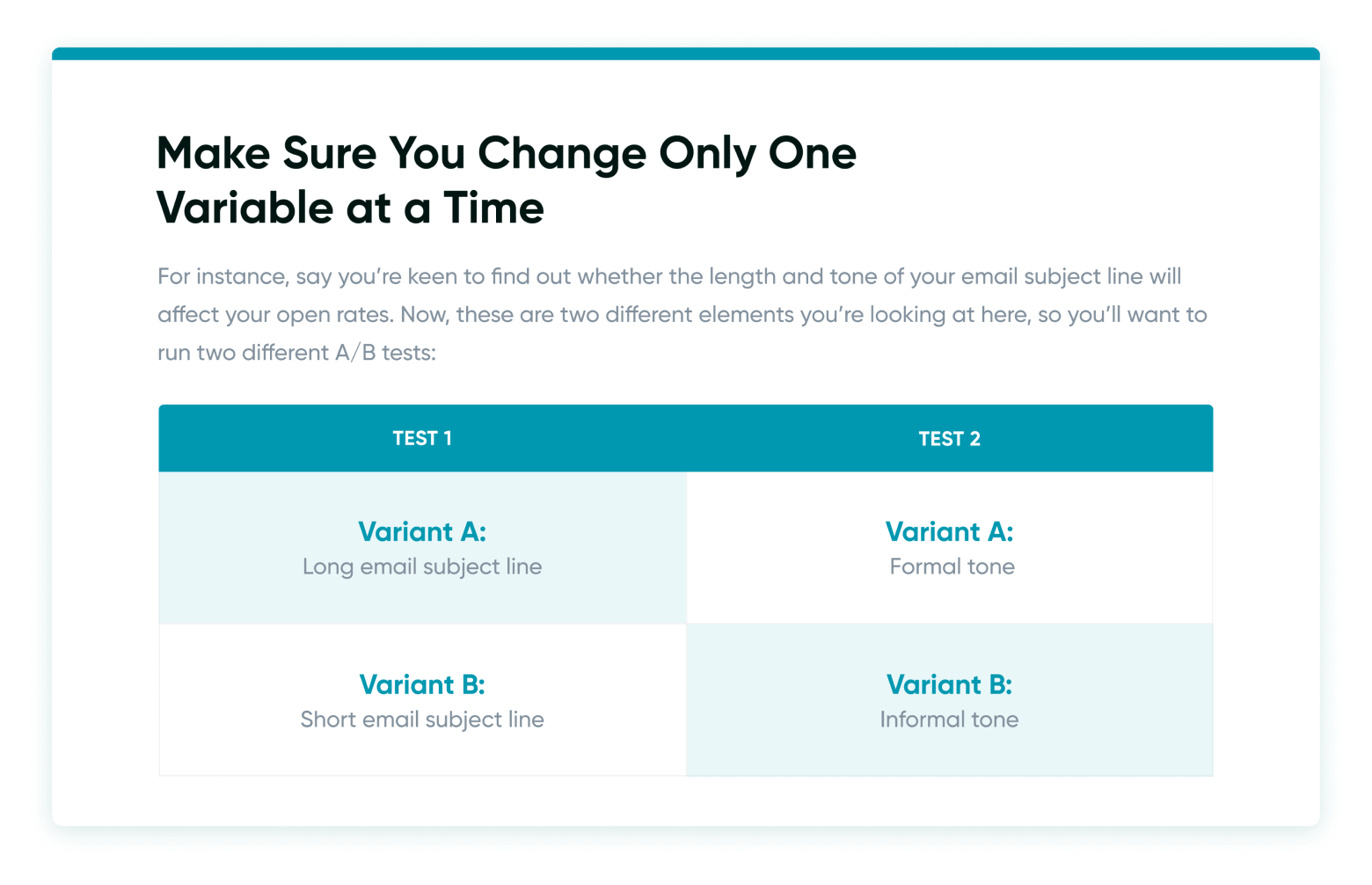
If you simply conduct one test, and change two variables at a time, you won’t know whether the results you get are attributable to the first or second variable. Keep that in mind!
The importance of your sample size
If your sample size (ie the number of subscribers you’re conducting your A/B test with) is too small, the test might not be statistically significant. This means your results won’t be valid.
Now, here’s the tricky thing: there isn’t a one-size-fits-all sample size that you can use for every email campaign. Instead, your minimum sample size depends on a variety of factors, including your expected conversion rate, the change in conversion rate you’d like to detect, etc.
The easiest way of figuring out your sample size is by using an online calculator, such as this one by Optimizely. Here are the factors you’ll need to input:
- Baseline conversion rate. If your existing cold email campaign is converting at 5%, then your baseline conversion rate is 5%.
- Minimum detectable effect. This refers to the change in conversion rate you’d like to detect. If you want to increase your conversion rate by 40% (which takes you from 5% to 7%), your minimum detectable effect is 40%..
- Statistical significance. The standard for statistical significance is typically 95% – if your test results are 95% statistically significant, this means that you’re 95% confident that your observed results are real, and not an error caused by randomness.
If your sample size is 2,000, that means that your email needs to be delivered to a minimum of 2,000 recipients in order for your results of your A/B test to be statistically significant. Yes, it’s much easier to run your A/B test without bothering with the math… but if your results aren’t accurate, then this defeats the purpose of testing in the first place!
A/B testing ideas for email campaigns
Eager to get started on A/B testing? Here are a few ideas to inspire you, plus our learnings and insights from several of our own A/B tests:
- Test your subject line
- Test the length of your subject line
- Test the tone of your subject line (formal vs informal)
- Test using emojis in your subject line
- Test sentence case vs title case in your subject line
- Test using a question in your subject line
- Test your opening line
- Test ice-breaking techniques
- Test the length of your opening line
- Test your tone (formal vs informal)
- Test the length of your body copy
- Test using animated GIFs
- Test the angle of your email
- Test your CTA (asking your prospect to sign up for a product demo vs free trial vs consultation)
- Test using in-text links vs button links
- Test using HTML vs a plain text email
- Test adding testimonials to your email
- Test different images
- Test using one image vs multiple images
Testing email subject lines
Your subject line is one of the easiest things to test in a cold email campaign. Personally, we find that casual subject lines tend to have a much higher open rate and bring about more conversions than more specific, clickbait-y ones.
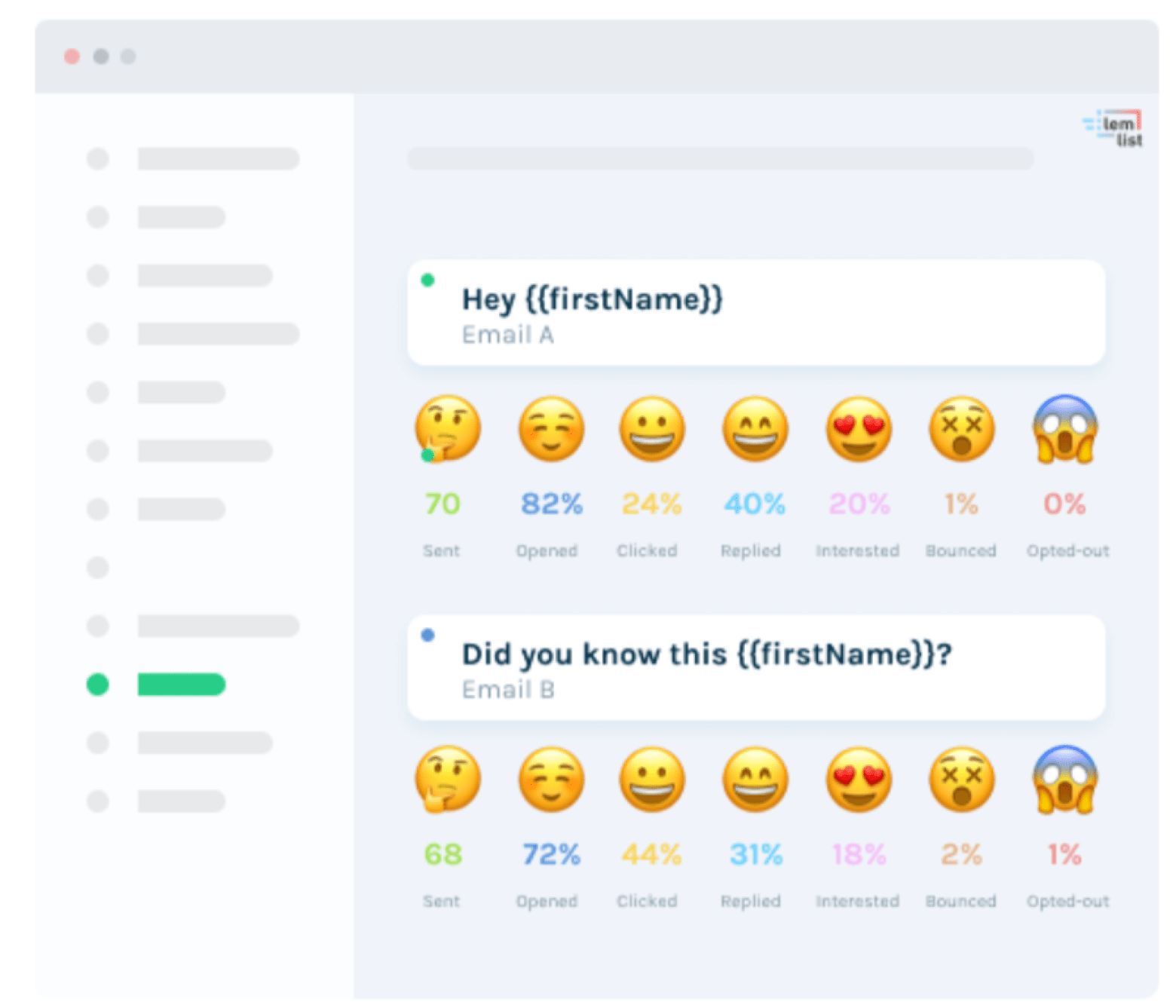
Testing intro lines
Subject lines aside, it’s also a no-brainer to test your intro lines. Your intro lines have the all-important task of “hooking” your prospect and getting them invested in reading the rest of your email, so we recommend spending some time optimizing this particular element.
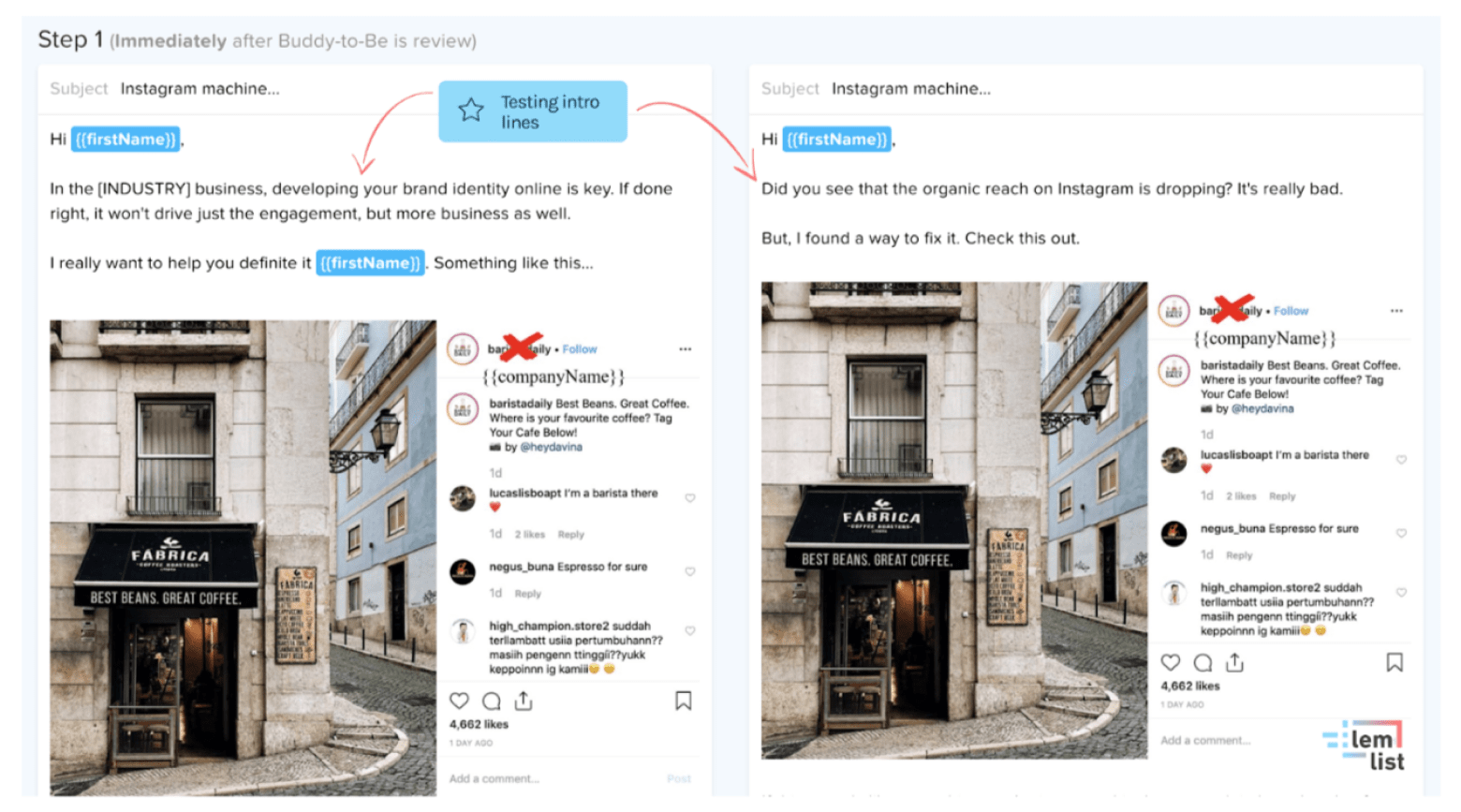
Testing ice-breaking techniques
How do you break the ice, and build rapport with your prospects? Some marketers like to bring up mutual friends, and others might compliment them on something that they’ve achieved recently.
We recommend experimenting with a couple of techniques, and using A/B testing to figure out which works the best!
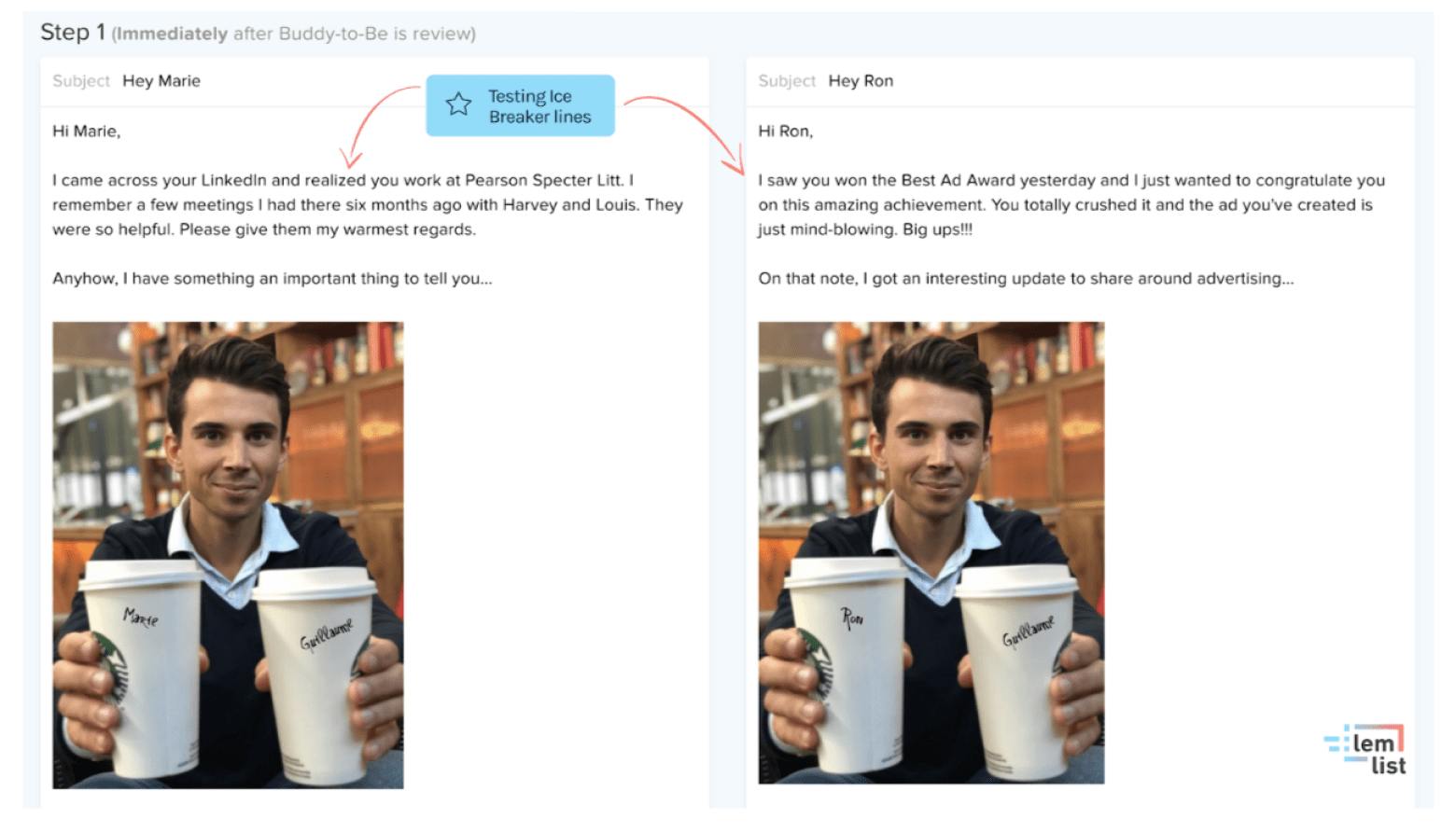
Over to you! Here’s how you can A/B test your campaigns to improve your results:
- Decide what variable you want to test. Make sure you only test one variable at a time.
- Decide on your key metric. If you’re testing your subject line, you’ll probably look at your open rate; if you’re testing an element within your email body, you’ll probably focus on click-through rate, response rate or conversion rate instead.
- Decide how much of an uplift you want to see in your key metric. If your existing conversion rate is 5%, and you’re hoping for a 40% uplift, this means your conversion rate should increase from 5% to 7%.
- Calculate your minimum sample size with an online calculator, and make sure your email list is big enough. (If it’s not, postpone the test and focus on building your email list first. If you conduct a test when your list is too small, this might bring you inaccurate and/or misleading results).
- Come up with the two different variations of your cold email, and set up your test on your email marketing platform.
Common Mistakes People Make With Cold Email
Jan Kartusek @ In Sales Academy
When done right, cold email campaigns can be immensely powerful. But it’s easy to go wrong with these campaigns… so check out this list of common cold email mistakes that you can learn from:
Sending emails with too many links
The more links you include in your email, the lower your sender score will be. This influences your deliverability, so make sure you stick to a maximum of two links per email, including any links in your signature. Ideally, you’d have:
1. A link in your body text, directing prospects to a specific landing page.
2. A second link in your email signature, directing subscribers to your website
Using ineffective Calls-to-Action
It’s important to nail your Call-to-Action (CTA), but newbie marketers often make the mistake of using CTAs that are too specific, or too unspecific. You don’t want to close on one end of the spectrum with a vague CTA, such as “I look forward to your reply”.
On the other hand, it also doesn’t pay to close with a CTA that’s too specific, such as “Can I catch you for 15 minutes on Tuesday at 5pm?”
The key here is to make it easy for your prospect to take the next step, and to reduce friction as much as possible.
For you to do this, you have to:
1. Clearly state what you want them to do next. Are you asking them to book a consultation with you? Sign up for a product demo? Or simply indicate their interest to receive a case study you want to send to them?
2. Allow your prospect to take that action at their convenience. If you’re asking them to book a consultation, send them a Calendly link showing all your available slot. This way, they can choose a time/date that works best for them without any unnecessary back and forth.
Using more than one Call-to-Action
On a similar note, using more than one CTA is also a rookie mistake that will reduce the effectiveness of your campaigns.
Let’s assume that you’re pitching a product/service that your prospect actually needs, and you’ve successfully demonstrated that your product can be of value to them.
Now, if you hit them with one specific CTA, they just might respond to you and take the action you desire.
If you finish up your email with two or three CTAs though, this might confuse and/or overwhelm your prospect. When that happens, they might file your email away for later (and then forget about it completely), or worse, send it to the Trash folder.
So, keep things as simple as possible and reduce friction by using only one CTA.
Not articulating your value proposition effectively
Your value proposition is basically the value that you bring to your customers. In your cold email, be sure to highlight your value proposition rather than reciting a bunch of features/benefits but failing to connect the dots for your prospect.
Instead, “Our tool comes with 150+ integrations, and works well with popular CRM platforms such as Salesforce.”
Say: “Our tool integrates with Salesforce and 150+ other software and platforms, which means you’ll never have to manually port over your data again.”
Instead of: “We’ve been in this industry for 10+ years, and we’ve got plenty of experience.”
Say: “In the 10+ years that we’ve been in this industry, we’ve helped countless companies navigate {problem that your prospect faces}, including {prospect’s competitor}. In fact, we were the ones who helped {prospect’s competitor} get from {initial situation} to {current situation} in just {time period}.”
Over to you! Here’s a quick recap of the common cold email mistakes to avoid:
- Sending emails with too many links. Include a maximum of two links in your emails.
- Using ineffective Calls-to-Action. The best CTAs are clear, and also provide some level of flexibility.
- Using too many Calls-to-Action. Stick to one CTA for greater impact
- Not articulating your value proposition effectively. Make sure you connect the dots for your prospects, and tell them why they need your product.
10+ Cold Email Examples and Templates That Actually Work
To put together this final chapter, we trawled the web to source the best cold email templates and invited several email experts to share their best-performing cold emails as well. Feel free to use the following examples as inspiration or adapt them to use in your own cold email campaigns!
Email #1
Ryan Robinson @ ryrob
The most effective cold email template I’ve used has helped me generate more than $111,000 in freelance business for myself last year. Here, instead of asking my prospect for their time or attention, I’m doing something valuable for them first. For example:
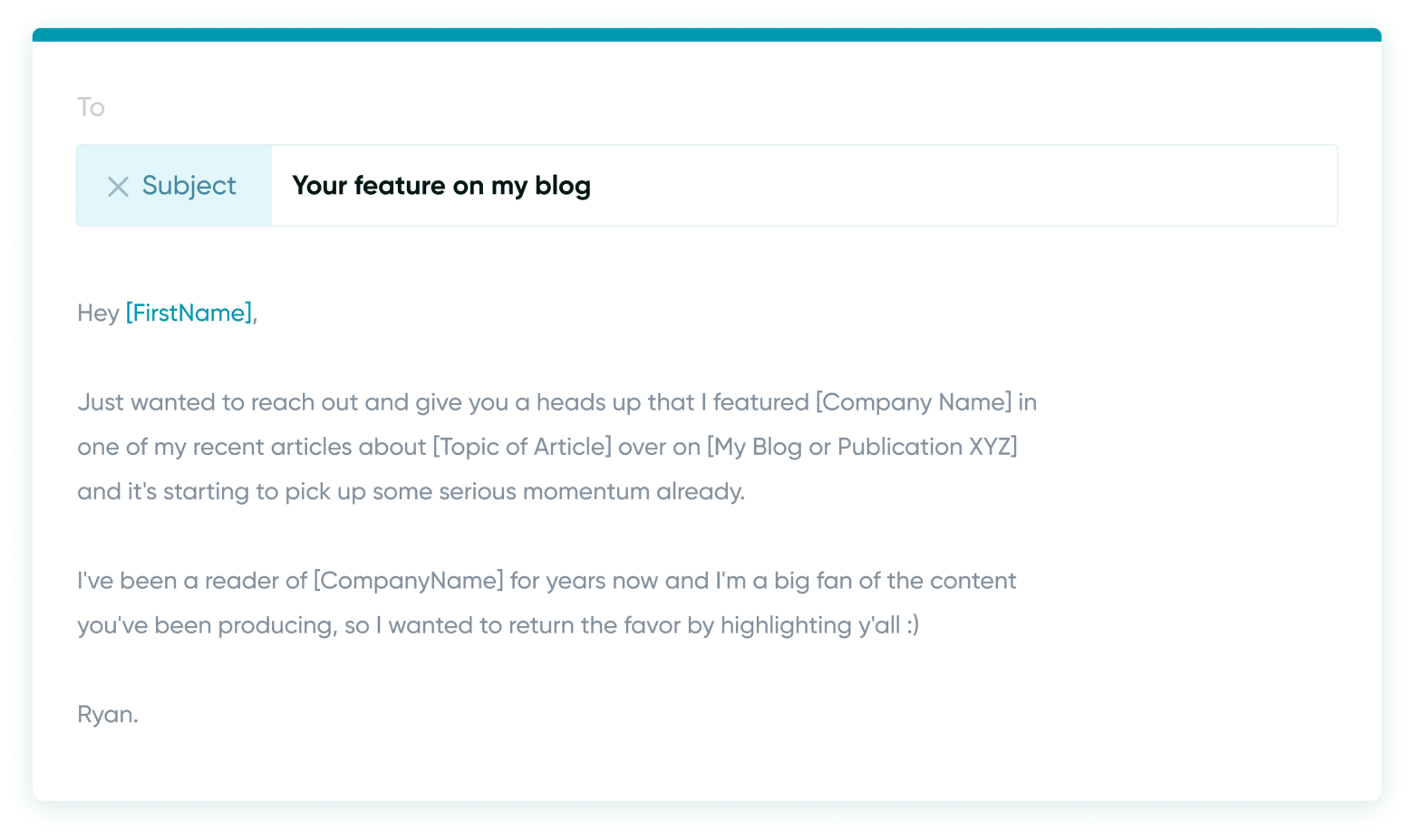
Why it works: You’ll notice that there’s no immediate ask of the prospect to hire me for my services. The sole objective of this email is to open up a dialogue and show them that I can already deliver on the kinds of services I offer, by providing that exact value first. This email almost always gets a reply within 24 hours.
Email #2
Maha Bodhi @ Yogi Maha
Personally, I’m a believer in cold emails that are short, sweet and to the point. My best-performing cold email to date is only two sentences long, and it’s helped me generate plenty of new business for my yoga program.
In fact, here’s an example of how I used this cold email to book a session with Google:
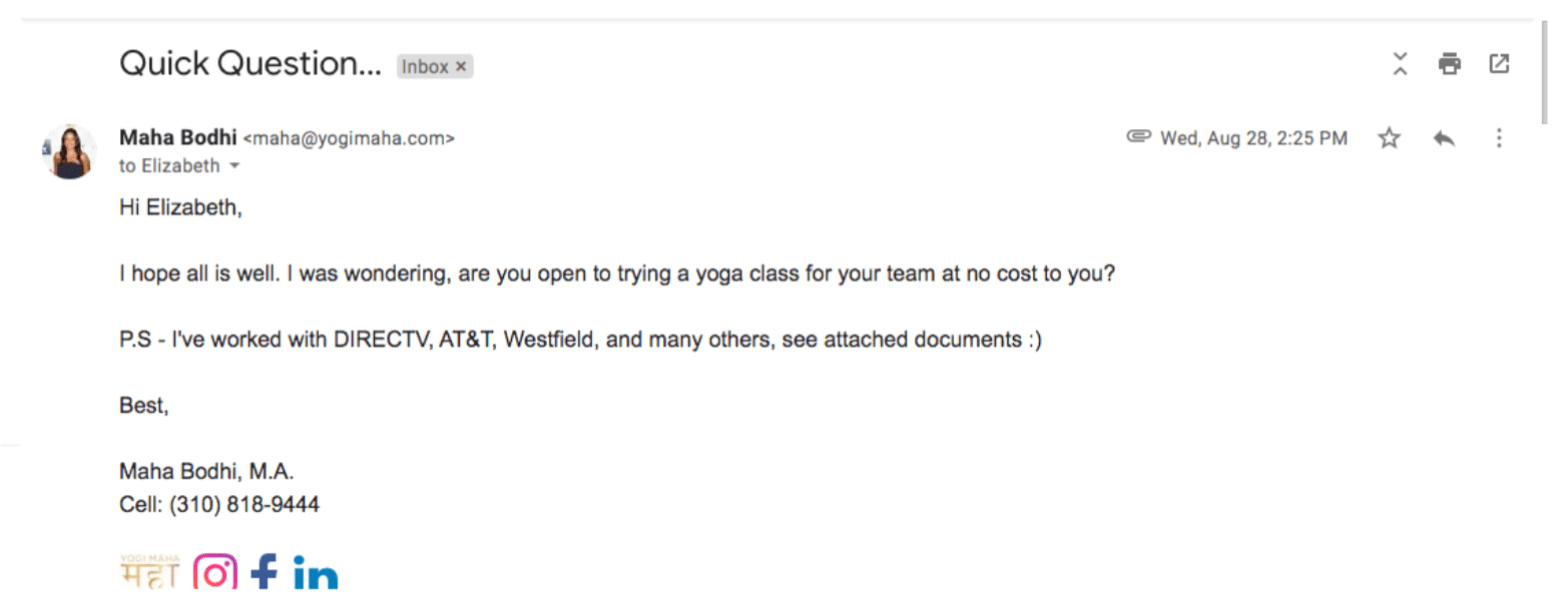
Here’s a reply from one of the prospects I cold-emailed, Liz:
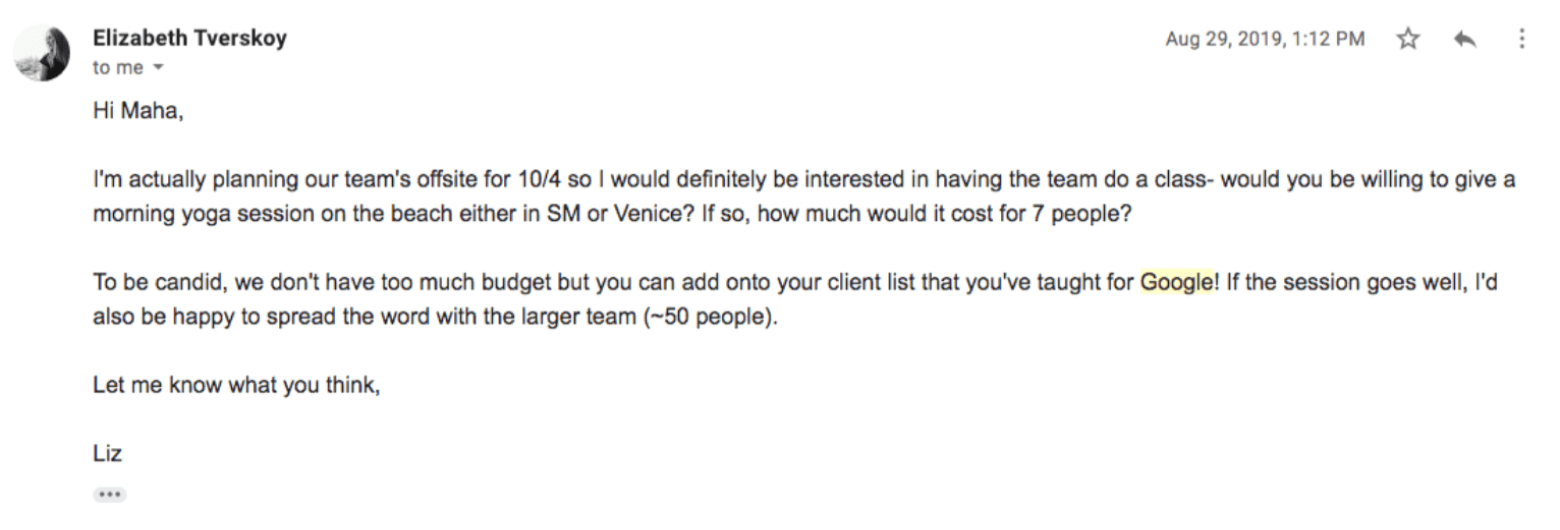

Why it works: There are a few different elements to this email that makes it successful.
First, it’s short and sweet, with a straightforward ask. Next, there’s plenty of social proof, because I reference about the big brands that I’ve previously worked with. Last but not least, my offer is attractive – I’m giving away a free class, so it’s a no-brainer for the prospect to accept.
Email #3
Guillaume @ lemlist
We have several cold email templates that we swear by at lemlist. One of our best-performing cold emails is this “Podcast Outreach” email, which I send out to prospects when I’m hoping to land an interview on their podcast:
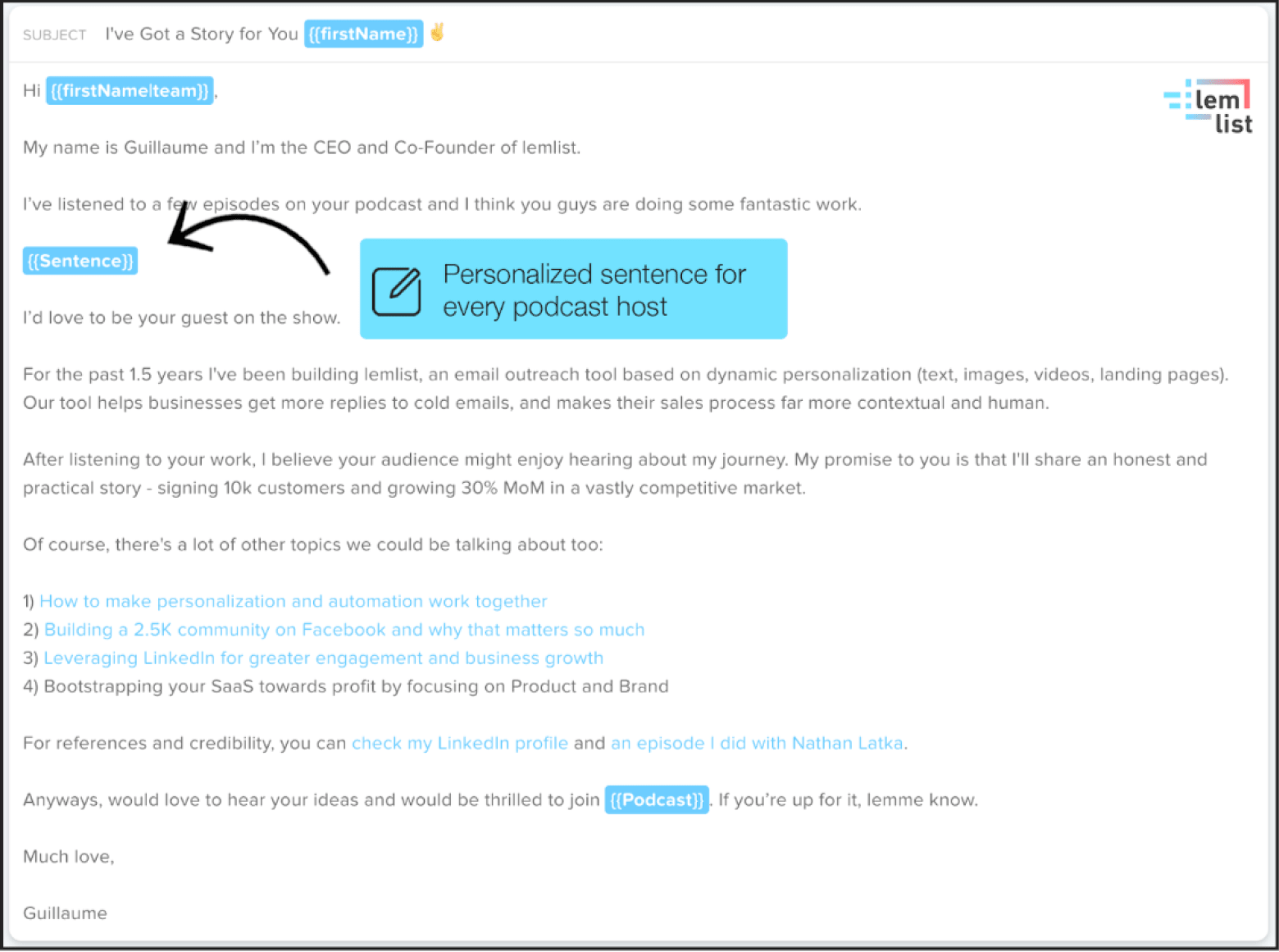
In a recent campaign, this email brought me a 84% open rate and 41% reply rate.
Why it works: In this cold email, I focus on what I bring to the table, and what my prospect could gain from working with me. I also throw in a couple of podcast ideas and topics, which takes the pressure off the prospect and makes it easy to say “Yes, let’s do it!”
Email #4
Guillaume @ lemlist
As much as possible, I try to connect with entrepreneurs and marketers so that I can pick their brains and learn from them. After much trial-and-error, I’ve crafted a great cold email that’s pretty successful in scoring meet-ups:

In a recent campaign, I A/B tested two variations of this email: one with the subject line “Lunch?”, and another with the subject line “Growth lunch?” Both variations performed well – the first one generated an 86% open rate and 40% reply rate, and the second generated a 100% open rate and 31% reply rate.
Why it works: Like I mentioned in Chapter Nine, crafting a personalized video for each individual prospect is pretty much the highest level you can hit with cold email marketing. When someone receives an email containing a personalized video, they’re intrigued and much more likely to read and reply to your email.
Email #5
Guillaume @ lemlist
I use this next cold email template to reach out to YouTubers to build backlinks, but the template is highly versatile, and it’s applicable to a wide range of use cases. Regardless of what industry you’re in, or what you’re hoping to get out of your cold emails, you can tweak this template and use it in your campaign:
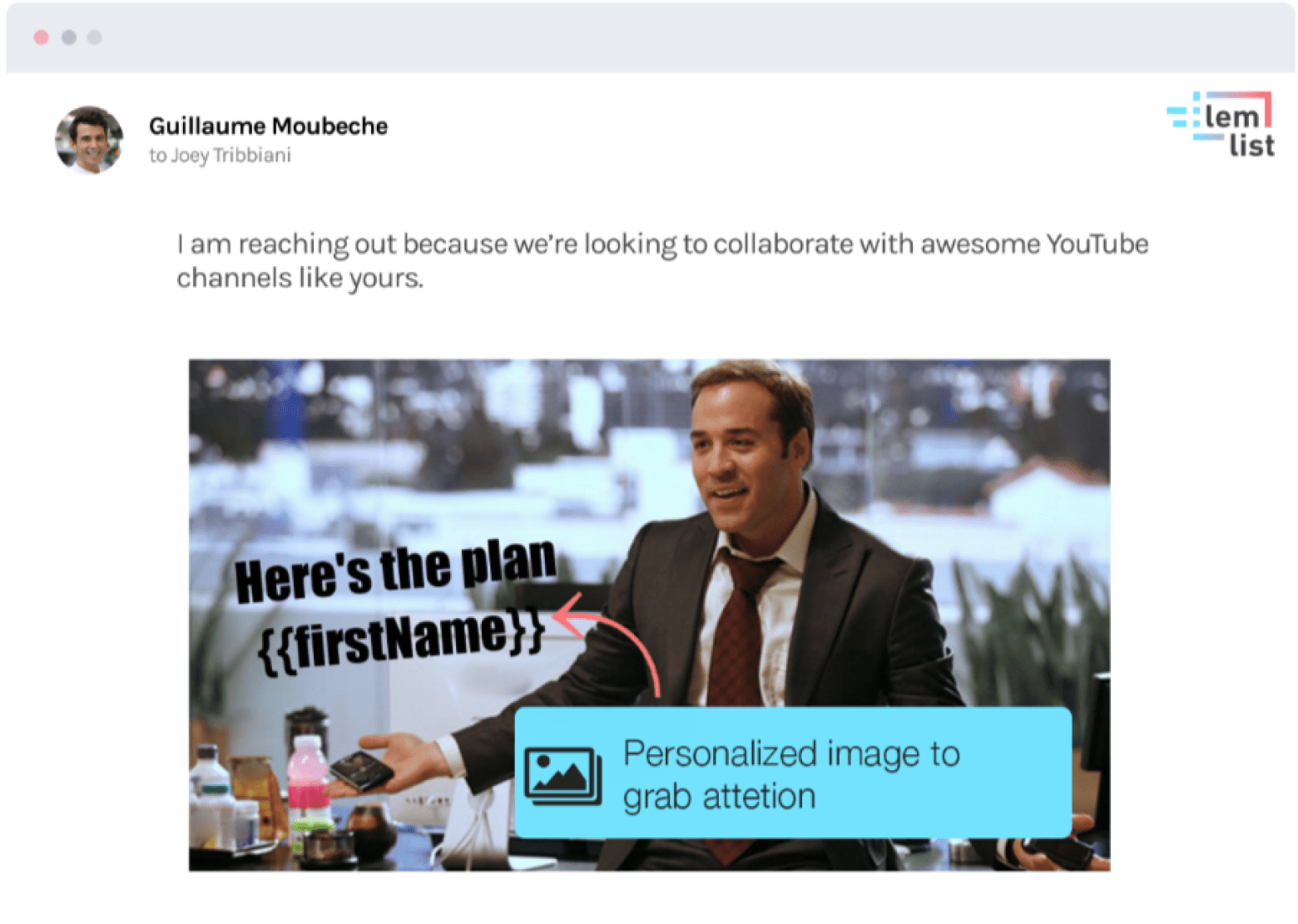
Here’s how the email continues:
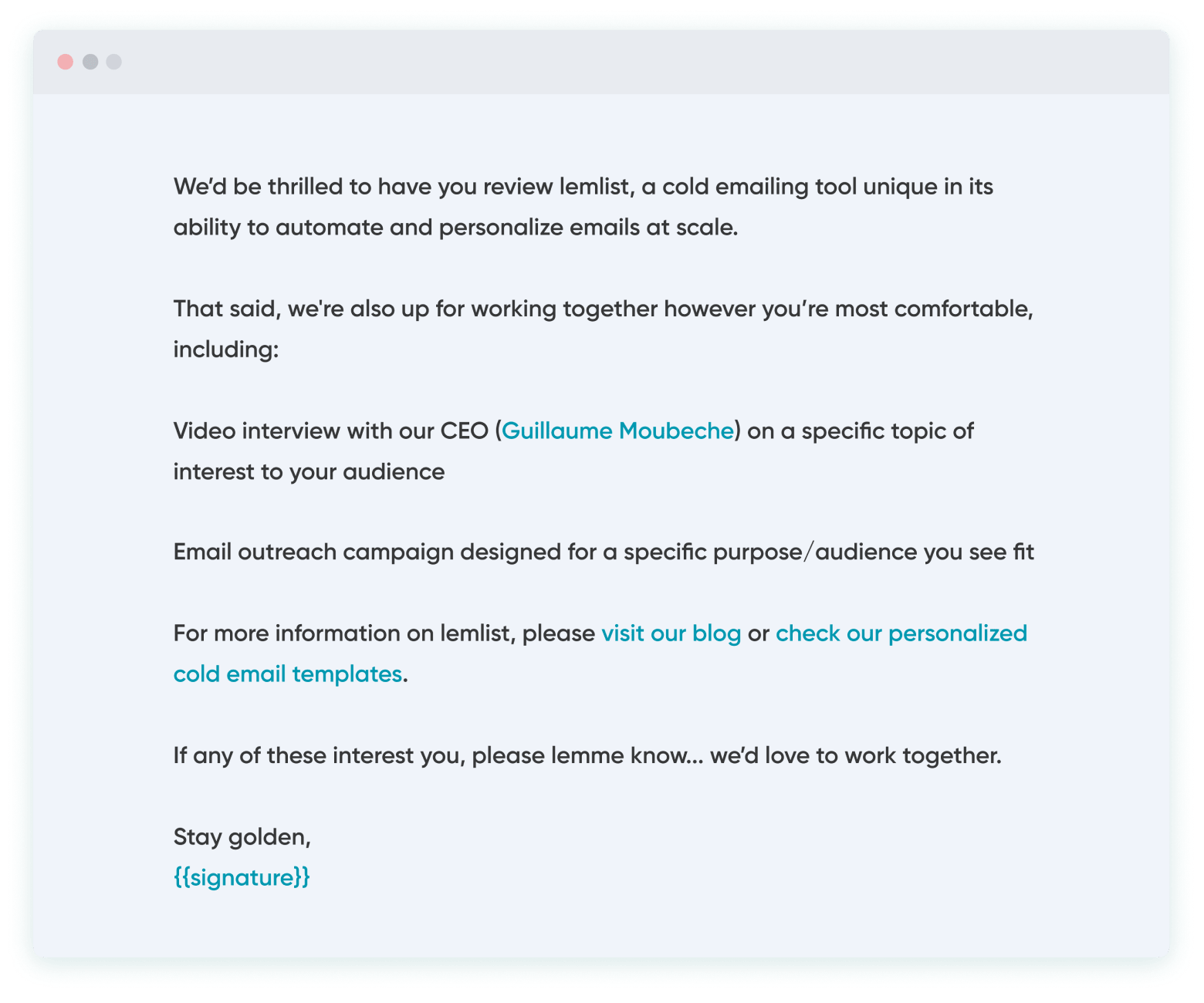
In a recent campaign, this email brought me a 76% open rate and 21% reply rate. Using this email, we generated 40+ backlinks in a three-week time frame.
Why it works: Again, it all boils down to personalization.
Pro-tip: if you’re referencing pop culture or using a picture of, say, a famous TV character in your email, make sure you’ve got the right era! If your prospect is a millennial born in 2000, they probably wouldn’t understand any Friends references.
Email #6
Guillaume @ lemlist
This famous “Coffee Cup” email template is a staple at lemlist, and it was actually inspired by one of our users.
We actually use this email as a follow-up email (telling our prospect that we haven’t heard from them, but we’ve got their favorite drink ready and waiting). That said, I’ve reworked the intro so that you can use it to cold email a prospect that you don’t know:

Here’s how the email continues:
Let me know which day suits you best so I can pass by ?
Best,
{{signature}}
In a recent campaign, a variation of this email (used as a follow up!) brought me a 93% open rate and 21% reply rate.
Why it works: This email works because it’s fun and unexpected, and it humanizes your outreach. Chances are, your prospect will get a chuckle out of the email… and this makes them that much more likely to respond to you!
Email #7
Guillaume @ lemlist
We created this next email template while working with a few startups who were looking for a creative way to run sales campaigns. This email utilizes super light text personalization with a dynamic image as the main attention grabber:
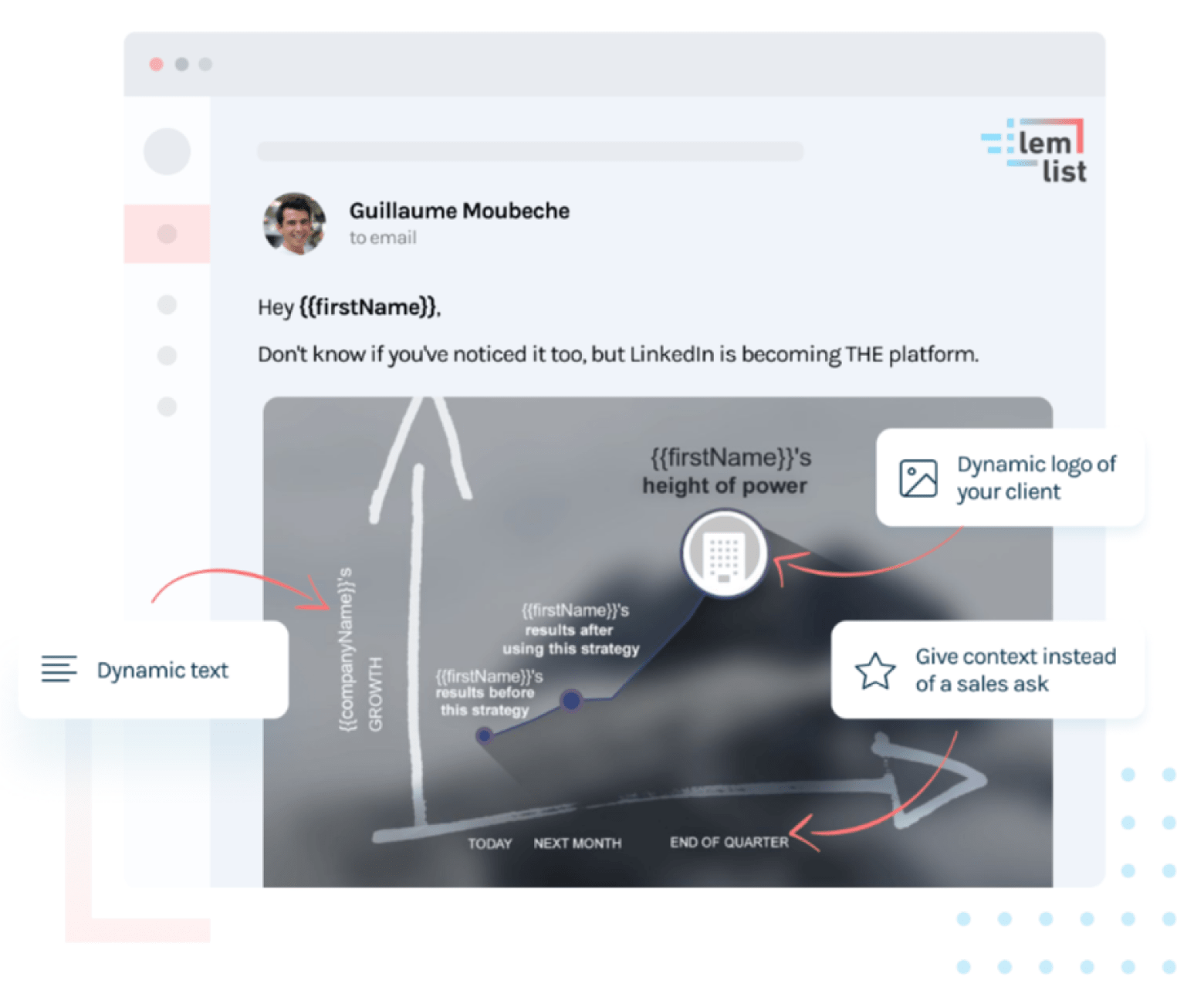
Here’s how the email continues:
This represents a major opportunity for {{companyName}}.
And it’s precisely where you and I come in…
If you remember, this is exactly how [add in proof or example here].
So, with that in mind, I wanted to bring your attention to [write your pitch here].
Essentially, do this {{firstName}}:
[Personalized image explaining strategy]See you on the other side,
{{signature}
In a recent campaign, this email brought me a 94% open rate and 76% reply rate. (It doesn’t get much better than that!)
Why it works: This email is fun and humorous, but it also does a great job at visually outlining the importance of LinkedIn (or whatever solution you’re selling) to your prospects.
Email #8
Will Cannon @ UpLead
Over at UpLead’s blog, we run an UpLead Growth Chats feature. Here, we interview successful entrepreneurs and ask them to share insights and tips about how to tackle the various aspects of building a company. I use this template to reach out to prospects I’d like to interview, and it’s gotten me great results:
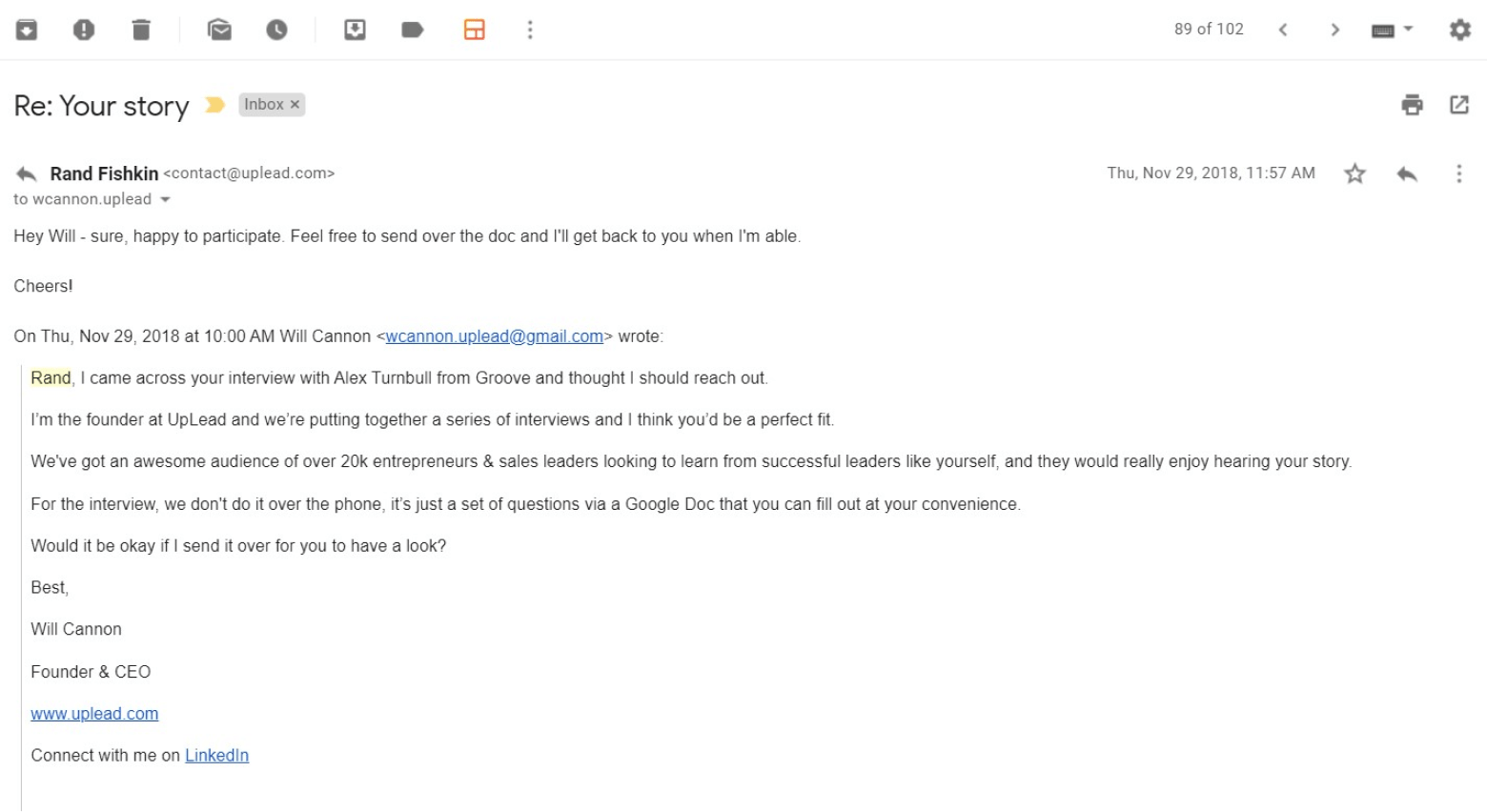
Why it works: Targeting plays a huge role here – I specifically reached out to entrepreneurs who had been interviewed by other blogs/publications, so I knew they’d be at least somewhat open to my ask.
On top of that, I also made sure to mention the amount of exposure they’d get by doing the interview, and outlined the next steps clearly so it’d be easy for my prospect to say yes.
Email #9
Maria Vasconcelos @ AmpleMarket
Maria didn’t write this email, but she endorsed it as one of the best cold emails she’d ever read in a Quora thread. The email is from a company that sells HR software, and it relies on humor and a fun, conversational tone to build rapport:
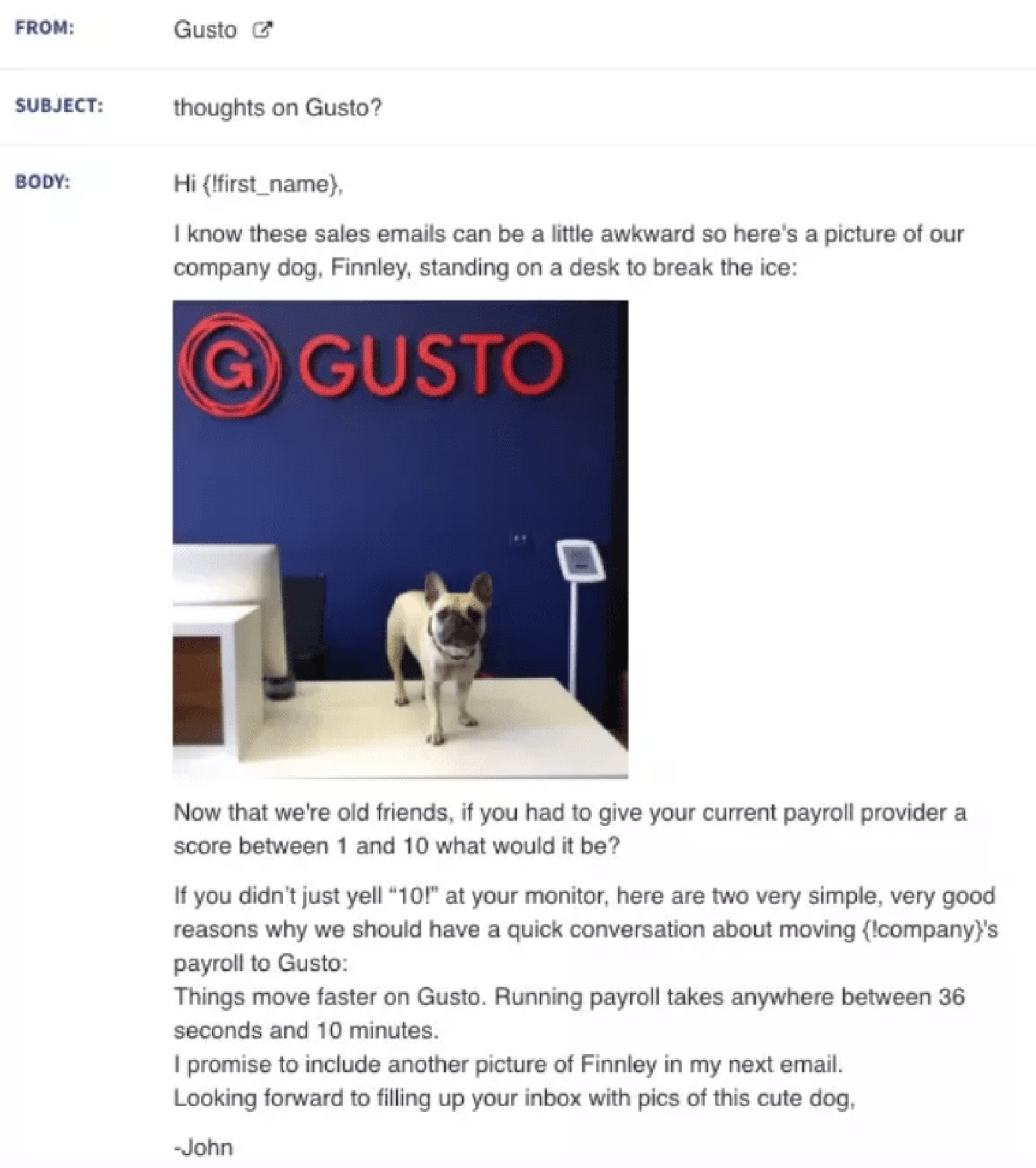
Why it works: People respond better to cold emails that show a little personality, plain and simple. Also, the company included a solid value proposition (“Things move faster on Gusto. Running payroll takes anywhere between 36 seconds and 10 minutes”) that provides a great hook.
Email #10
Neil Cocker @ Ramp T-shirts
Neil runs Ramp, which he bills as the “smartest, simplest, custom t-shirts ordering site in the world”. In his massively successful cold email campaign, he sent out 50,000 cold emails featuring a photo of him wearing each prospect’s company t-shirt:
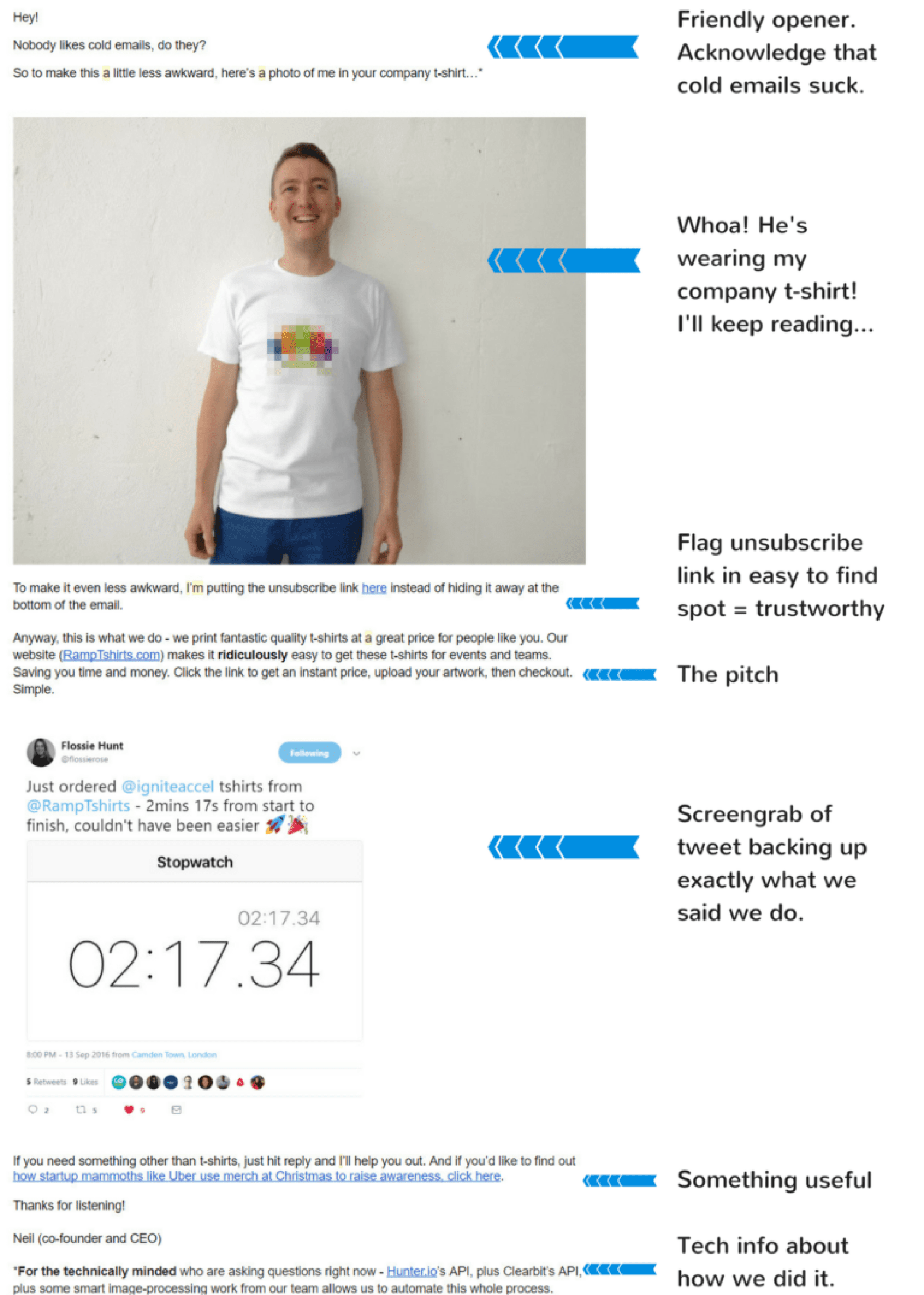
Why it works: Many elements make this email awesome, all of which are detailed in the screenshot above. The bottom line? With his carefully crafted cold email, Neil comes across as credible and trustworthy, which is half the battle won.
Email #11
Forster Perelsztejn @ Prospect.io
Forster Perelsztejn from Prospect.io says that he’s not easily impressed by cold emails, but pointed out that this specific one that he received from Sumo was “a masterpiece of targeting and scalability”:
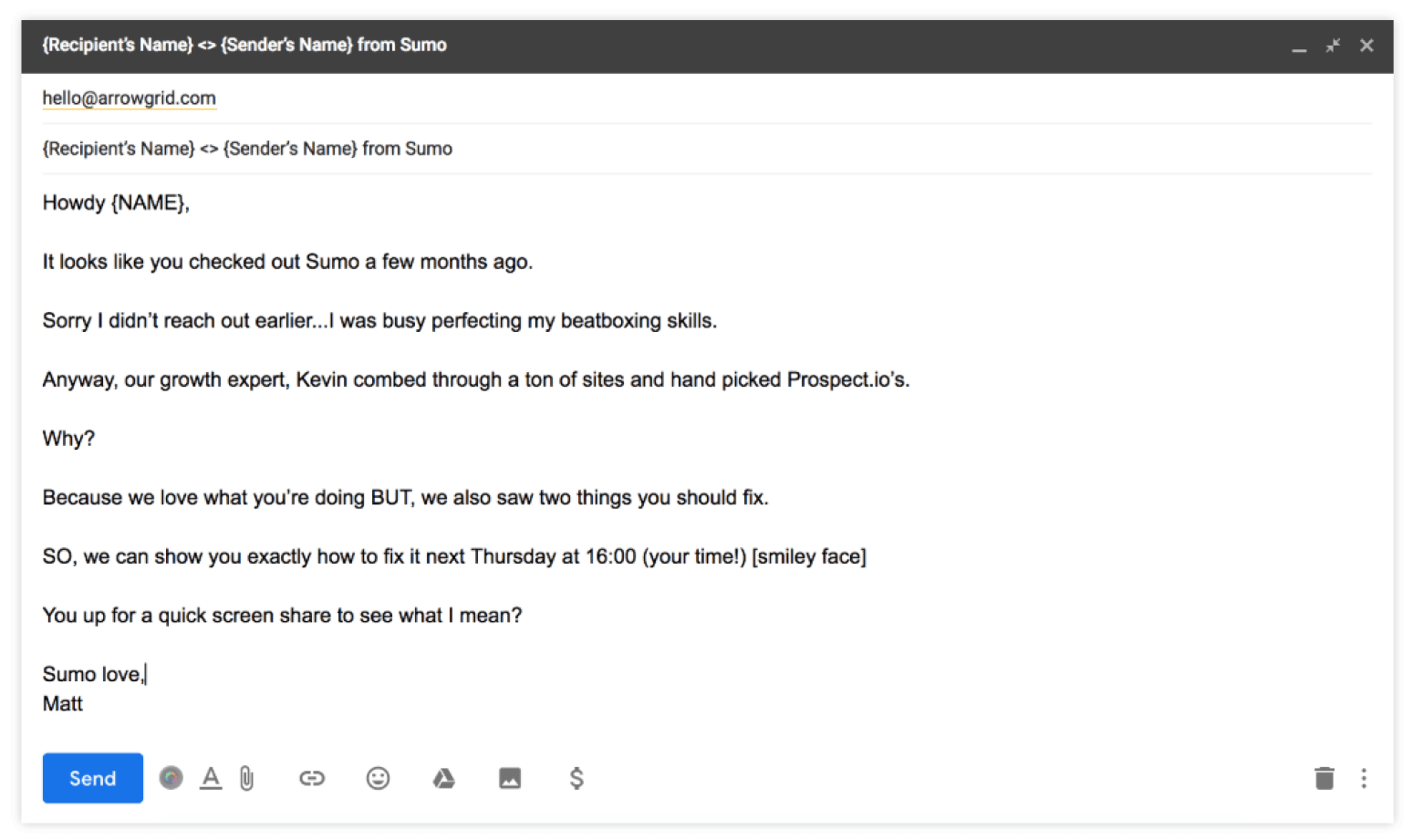
Why it works: We’ve mentioned a few times that you have to add value to your prospect. In this email, Sumo is doing this in the most concrete way possible – by pointing out their prospect’s mistakes, and offering a solution for them.
Email #12
Jonathan Grana @ Interseller
As Jonathan from Interseller shares, it’s key to show some personality in your emails, and remind people that there is a human on the other end of the thread. He does this using a conversational tone and a humorous GIF:
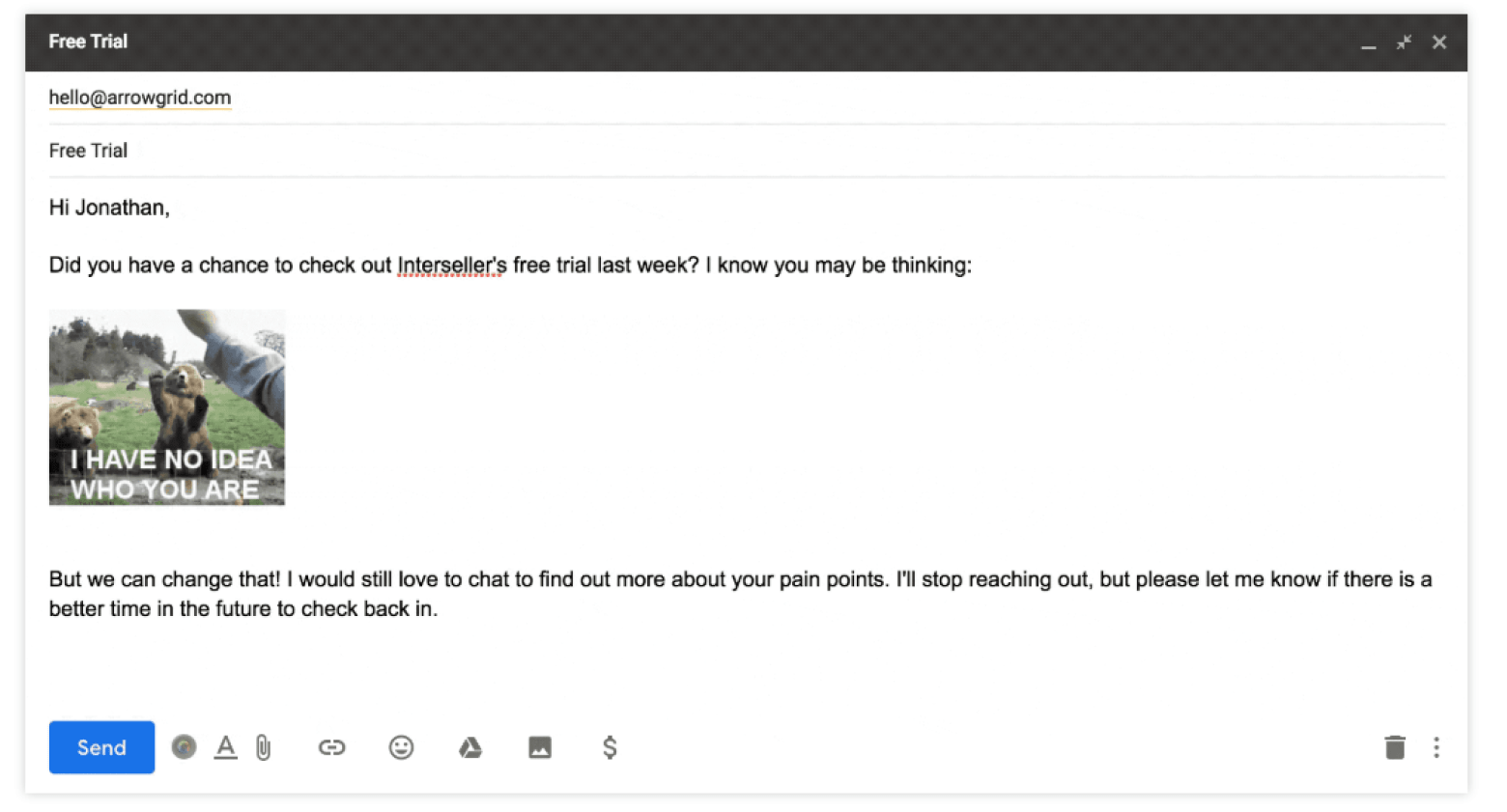
Why it works: The email is endearing, and helps you build rapport with your prospect. This is best used as the last email in a campaign or series – assuming your prospect hasn’t replied to your previous emails, you’ll want to demonstrate that you’re “backing down” and that you have no intention of hard-selling them.
Email #13
Aaron Krall @ AaronKrall.io
In this Quora thread, SaaS consultant and marketer Aaron Krall shares a cold email template that he’s used to get appointments from notable SaaS founders:
Subject line: Do you suffer from low conversion rates from free users to paid subscribers?
Hi {{first_name}},
I noticed you offer free trials of {{company_name}} to build a list of potential paid users. I’m curious, would you like to convert more of those free trials into paid users?
I have an idea I can explain in 13 minutes that can help you increase your MRR by converting more of those free trials into paid users in a 7 days, with no additional effort from you or your sales staff.
I don’t know if this something that would help you or not, but if so, would it make sense to chat?
Cheers,
Aaron
Why it works: The cold email targets a specific pain point of SaaS founders, which incentivizes them to respond. Also, Aaron states exactly how much time he needs from them (just 13 minutes!), which reduces friction and encourages his prospects to take that next step.
Email #14
Anna Pogrebniak @ AddSearch
According to Anna Pogrebniak, the best cold email she’s ever received is from Drift. In this Quora thread, she talks about how Drift’s email is both precise and to-the-point, resulting in her booking a demo with them immediately after she read the email:
“Hey Anna,
On the Lumoa site now. I’m required to fill out a 6-field form (see below) to request a demo. Now my only next step is to wait…
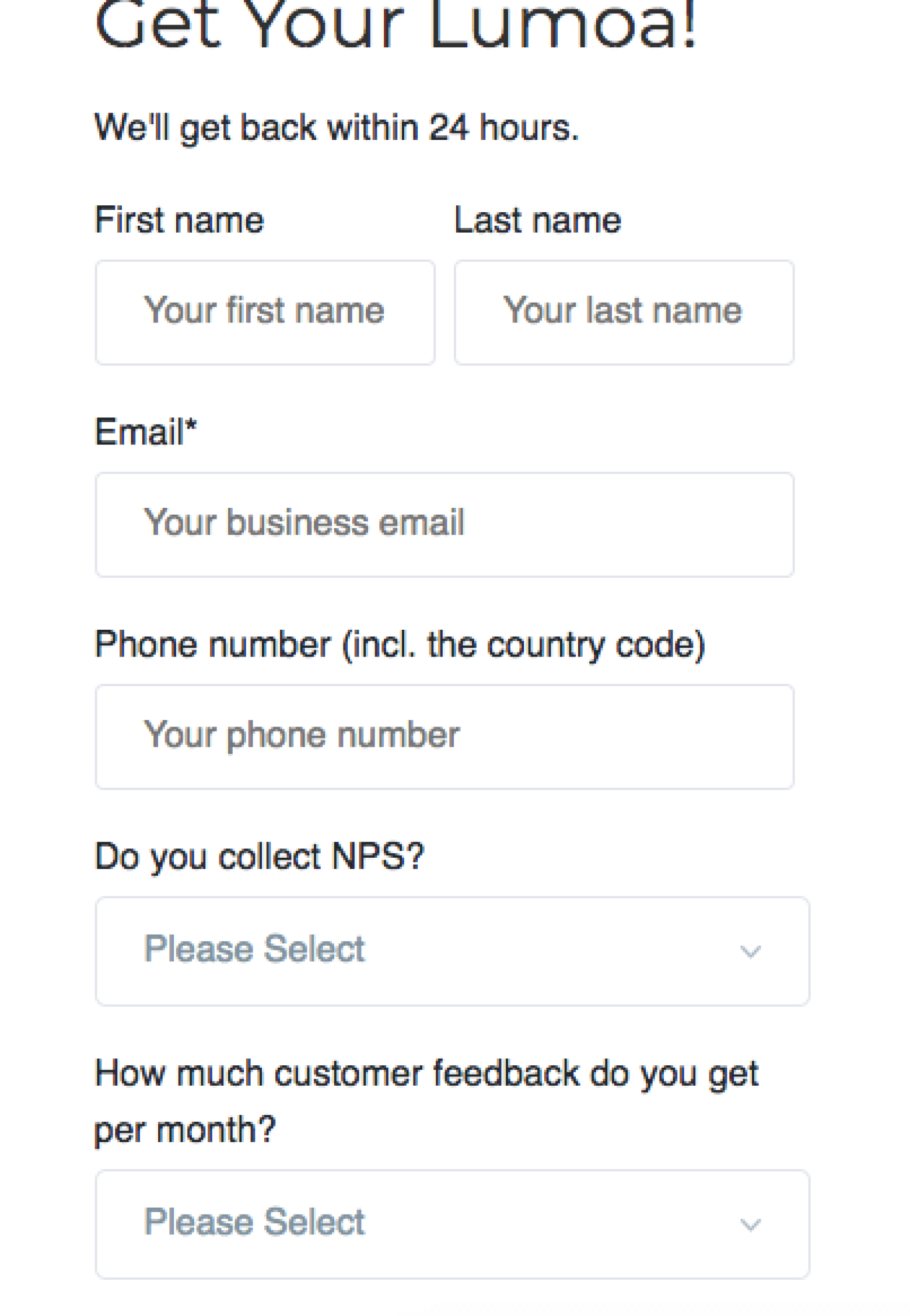
But I’m on the site now and I’m at my highest level of intent. So why not proactively engage me here?
MongoDB only had forms too. Then they added bots with Drift and saw a 70% increase in net new leads and 170% increase in opportunities.
Open to taking a look? You can book time below my signature to streamline things!
Best,
Anthony”
Why it works: Why it works: Again, this cold email from Drift provides tons of value. First, it tells Anna what her company is doing wrong, and tells her how to fix it. On top of that, it also provides social proof (by referencing MongoDB), and communicates the results Anna is likely to get from fixing the problem.
Cold Email Outreach: Conclusion
Congratulations! You’ve made it all the way to the end of this huge article, which means that you’re now an unofficial expert on all things related to cold emails.
We’ve covered a lot of ground in this guide, and to help you along, here’s all our content summarized into a handy checklist for you:
This checklist walks you through everything you need to do to set up a cold email campaign from scratch, and it’s the perfect aid for those who are venturing into cold emails for the first time.
And with that, you’re all set! We’ve equipped you with all the skills and knowledge that you need, and from here, it’s up to you to go forth and start crafting an awesome cold email campaign.
PSA: This is the point where inertia sets in. At this point, 99% of people reading this article will probably leave this page, think to themselves: “That was a good read! I should definitely get started on cold emailing soon”… and then proceed to procrastinate for the rest of the year.
Look, we get it. It’s not easy setting up a cold email campaign, and all the technical details and jargon can get pretty intimidating. But think of it this way: if you don’t at least give cold email a try, you’re basically sabotaging your company and not letting your company reach its full potential. You don’t want to do that, do you?
So take the first step today, and start building a hyper-targeted list of prospects to email. Assuming you already have a rough idea of your ideal customer persona, you can use UpLead to quickly identify the right prospects using 50+ criteria, including industry category, job title, geographic location, job function, and more.
To get started, sign up for a free 7 day UpLead trial, which allows you to access our database of over 46 million contacts in 200+ countries worldwide.
Lead generation doesn’t have to be all that painful. With UpLead, you can easily connect with high-quality prospects and leads to grow your company.

Special thanks to our contributors:
